Paul van Yperen's Blog, page 304
June 28, 2017
Helmut Käutner
Watchful Dreamer: The Subversive Melancholia of Helmut Käutner is the name of an Il Cinema Ritrovato's section about one the most influential and acclaimed directors of the German post-war cinema. Helmut Käutner (1908-1980) already began his career as an actor and cabaret artist at the end of the Weimar Republic and he directed his first major films in Nazi Germany. Programma curator Olaf Möller describes him as "a radical of modesty and moderation, an ironic modernist of melancholia, an inventor of cinematic forms, an avant-gardist of the popular." It makes us curious about this section.
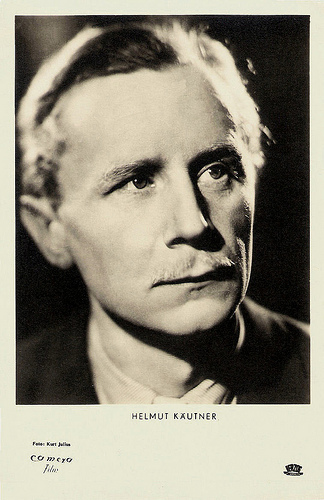
Helmut Käutner. German postcard by Photo-Kitt, München, no. 504. Photo: Kurt Julius / Camera Film.
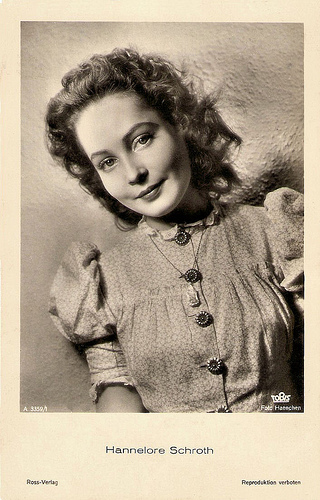
Hannelore Schroth . German Postcard by Ross Verlag, no. A 3359/1, 1941-1944. Photo: Haenchen / Tobis.
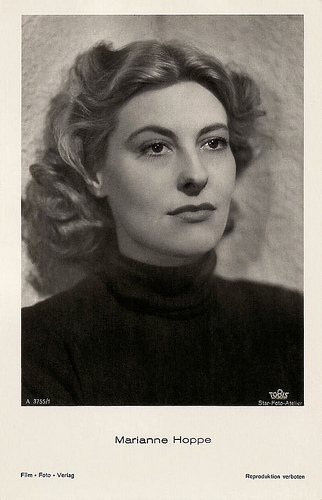
Marianne Hoppe . German postcard by Film-Foto-Verlag, no. A 3755/1. 1941-1944. Photo: Star-Foto-Atelier / Tobis.
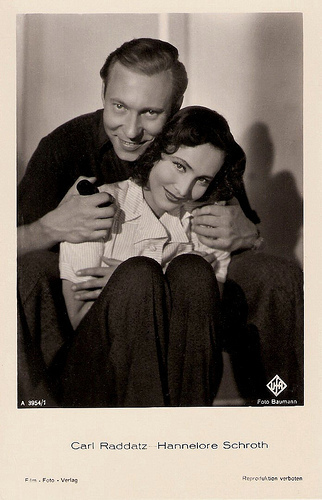
Carl Raddatz and Hannelore Schroth . German postcard by Film-Foto-Verlag, no. 3954/1, 1941-1944. Photo: Baumann / Ufa.
Pro-English Tendencies
Paul Günther Helmut Käutner was born in 1908 in Düsseldorf, Germany. He was the son of merchant Paul Läutner and his wife Claire, born Röntgen. In 1916, the family moved to Essen where Käutner attended Helmholtz-Realgymnasium and participated in school theatre performances. He studied graphics, costume design, set design, and interior design at the Kunstgewerbeschule.
In 1928, he went to Munich's university to study German studies, philosophy, psychology, art history, and theatre studies. From 1931 to 1935 he wrote, directed and performed at the Munich Student Cabaret troupe Die vier Nachrichter (The Four Executioners). The literary and rather unpolitical group was banned in 1935 for "lack of reliability and aptitude according to national socialist governance". Käutner wrote feuilletons and reviews for the Bavarian university newspaper.
In 1932, he made his film debut as an actor in Kreuzer Emden/Cruiser Emden (Louis Ralph, 1932), but after that experience he turned to the theatre again and also wrote songs. From 1936 to 1938 he worked as an actor and director at the Schauspielhaus in Leipzig, at the Kammerspielen in Munich, at the Theater am Schiffbauerdamm, at the Komödie and at the Kabarett der Komiker in Berlin.
In 1938 he drew attention to himself as a screenwriter for such films as Schneider Wibbel/Wibbel the Tailor (Victor de Kowa, 1938), Salonwagen E 417/Parlour car E 417 (Paul Verhoeven, 1938), Die Stimme aus dem Äther/The voice from the ether (Harald Paulsen, 1938) and Marguerite: 3/Marguerite Divided by Three (Theo Lingen, 1938).
In 1939 Käutner began his career as a film director with the light-hearted comedy Kitty und die Weltkonferenz/Kitty and the World Conference (1939), featuring Hannelore Schroth . Käutner was not a member of the resistance but, during the period of National Socialism, he was able to maintain a certain independence in his work. Kitty and the World Conference was withdrawn by the Nazi censors due to its “pro-English tendencies”.
Käutner rejected the UFA filmmaking establishment and produced thoughtful and poetic works like Kleider machen Leute/Clothes Make the Man (1940) starring Heinz Rühmann , Auf Wiedersehen, Franziska!/Goodbye, Franziska! (1941), and Romanze in Moll/Romance in a Minor Key (1943) starring Marianne Hoppe and Paul Dahlke .
The latter was often seen as Käutner’s best film of this period. Romanze in Moll is an adaptation of Guy du Maupassant’s short story Les Bijoux. A somewhat traditional love-triangle story, the film was praised for its compositional perfection and technical virtuosity.
Käutner’s films considered the struggles of the German people during a period of great turmoil. With Große Freiheit Nr. 7/Great Freedom No. 7 (1944) with Hans Albers , and Unter den Brücken/Unter the Bridges (1945) with Hannelore Schroth and Carl Raddatz , he created two films which, in their emphasis on the individual, strongly opposed the world view of the national socialists.
Käutner’s work was noted for its more humanistic depiction of daily life than his contemporaries. Große Freiheit Nr. 7 is a melancholy, bittersweet story of disappointed love set amongst the sailors' clubs and bars of the Hamburg waterfront. The film title, which refers to a street next to Hamburg's Reeperbahn road in the St. Pauli red light district, caused a furor among the Nazis who feared that audiences would misinterpret the film’s meaning. As a result, the film was banned in Germany until the fall of the Third Reich.
Unter den Brücken, which is set amongst the bargees of the River Havel, is now considered one of the greatest love stories in the history of German cinema. Käutner’s avoidance of overt political content in his films during the war, allowed him to continue his career unhindered after 1945.
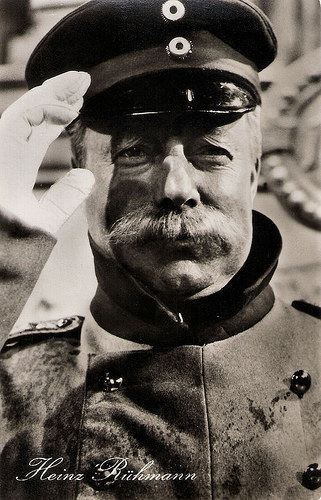
Heinz Rühmann . East-German postcard by VEB Progress Film-Vertrieb. Berlin, no. 309. Photo: Real-Film. Publicity still for Der Kaufmann von Köpenick/The Captain from Köpenick (Helmut Käutner, 1956).
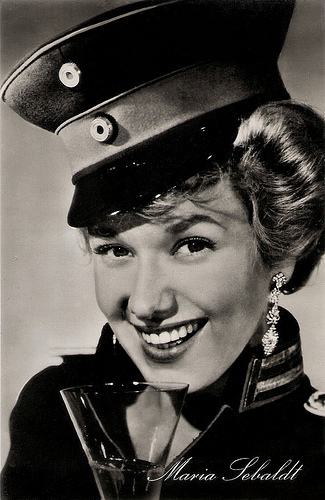
Maria Sebaldt . East-German postcard by VEB Progress Film-Vertrieb. Berlin, no. 321. Photo: Real-Film. Publicity still for Der Kaufmann von Köpenick/The Captain from Köpenick (Helmut Käutner, 1956).
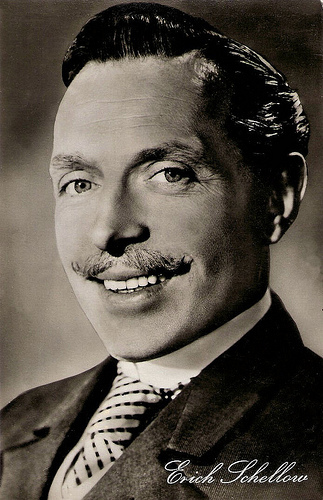
Erich Schellow . East-German postcard by VEB Progress Film-Vertrieb, Berlin, no. 312, 1957. Photo: Real Film. Publicity still for Der Hauptmann von Köpenick/The Captain from Köpenick (Helmut Käutner, 1956).
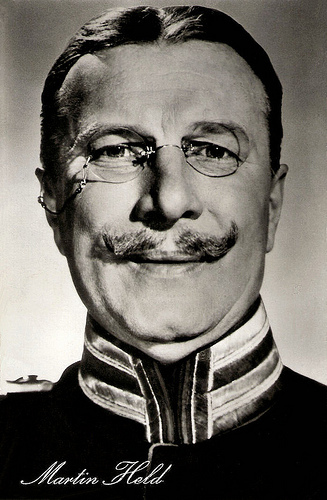
Martin Held . East-German postcard by VEB Progress Film-Vertrieb. Berlin, no. 311. Photo: Real-Film. Publicity still for Der Kaufmann von Köpenick/The Captain from Köpenick (Helmut Käutner, 1956).
Prix International at the Cannes film festival
In 1947 Helmut Käutner’s made the first German film after WWII, the Trümmerfilm In jenen Tagen/In Those Days (1947) with Gert E. Schäfer, Erich Schellow and Winnie Markus . The film which describes the post-war reality and people overwhelmed and traumatised by the impact of fascism, was a great success and launched the new German film. Käutner used the framing device of an automobile whose various owners serve as the film’s protagonists and initiate its episodic structure.
In the next years he directed such films as Der Apfel ist ab/The Original Sin (1948), Königskinder/Royal Children (1950), Epilog – Das Geheimnis der Orplid/Epilogue (1950) and Bildnis einer Unbekannten/Portrait of a Unknown Woman (1954) . He was acclaimed for these socially conscious, often starkly realistic post-war films, which depicted the plight of the common man, struggling with the traumatic effects of the war and its aftermath. However, the films were no audience successes.
In 1954, he won the Prix International at the Cannes film festival for his stark, realistic anti-war drama Die letzte Brücke/The Last Bridge (1954). In the following years, he had great successes with Ludwig II: Glanz und Ende eines Konigs/Mad Emperor: Ludwig II (1955) and the Carl Zuckmayer adaptations Des Teufels General/The Devil’s General (1954), with Curd Jürgens , Der Hauptmann von Köpenick/The Captain from Kopenick (1956) with Heinz Rühmann , and Der Schinderhannes (1958), again with Curd Jürgens .
In 1956, Der Hauptmann von Köpenick was nominated for the Oscar for Best Foreign Language Film at the 29th Academy Awards. Another international success was Monpti/Love from Paris (1957), starring Romy Schneider and Horst Buchholz . Käutner moved to Hollywood and produced two films for Universal: the family melodrama The Restless Years (1958) and A Stranger in My Arms (1959), with Charles Coburn and Sandra Dee.
He soon returned to West-Germany and made Der Rest ist Schweigen/The Rest Is Silence (1959), a modern-day retelling of Hamlet, starring Hardy Krüger . Other interesting films were Das Glas Wasser/A Glass of Water (1960) and Schwarzer Kies/Black Gravel (1961).
Käutner did not feel a connection with the Oberhausen Manifesto of 1962 or the New German Cinema, and Käutner distanced himself more and more from the cinema. His final feature films were Das Haus in Montevideo/The House in Montevideo (1963) with Heinz Rühmann and Ruth Leuwerik , Lausbubengeschichten/Tales of a Young Scamp (1964), and the remake of Der Feuerzangenbowle/The Fire Tongue Bowl (1970), with Walter Giller and Uschi Glas .
He began to work for television and occasionally he appeared as an actor. In addition, he also increasingly directed for the theatre. In 1967, he received the Adolf-Grimme-Preis for his television production of Valentin Katayev, produced at the Saarland Radio, Surgical interventions in the soul life of Dr. Igor Igorowitsch. In 1974 he played the title role in Hans-Jürgen Syberberg's feature film Karl May. Helmut Käutner also worked for radio Hamburg.
Since 1934, he had been married to the actress Erica Balqué who later was assistant director for almost all his films. His last years of life, already seriously ill, he spent with his wife in Tuscany in his house in Castellina in Chianti, in the north of the province of Siena. There he died in 1980 at the age of 72.
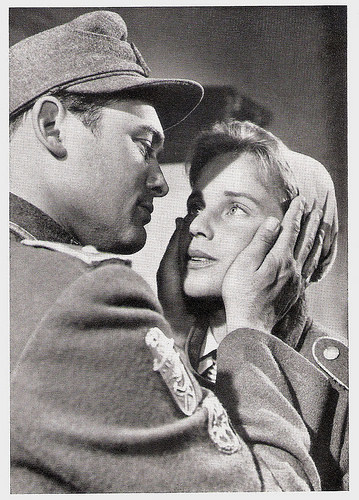
Maria Schell and Carl Möhner . German collectors card. Photo: publicity still for Die Letzte Brücke/The Last Bridge (Helmut Käutner, 1954).
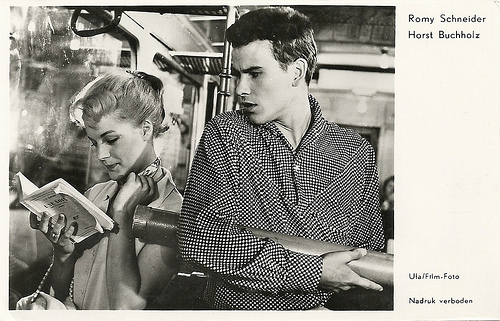
Romy Schneider and Horst Buchcholz . Dutch postcard by Gebr. Spanjersberg, Rotterdam, no. 1022. Photo: Ufa. Publicity still for Monpti (Helmut Käutner, 1957).
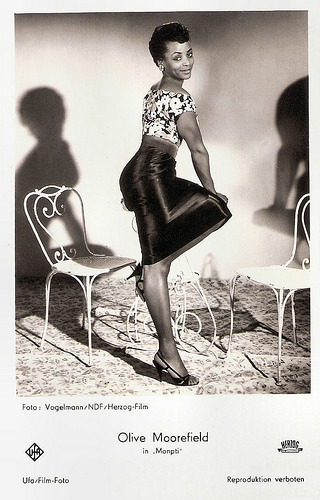
Olive Moorefield . German postcard by Ufa. Photo: Vogelmann / NDF / Herzog-film. Publicity still for Monpti (Helmut Käutner, 1957).
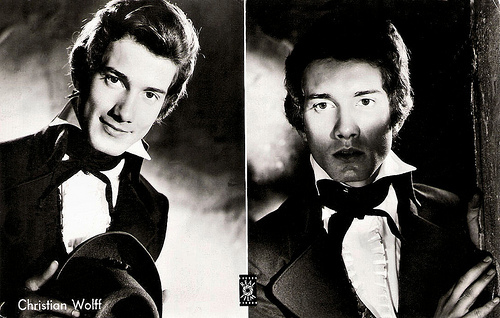
Christian Wolff. German postcard by Rüdel-Verlag, Hamburg-Bergedorf, no. D 2548. Photo: Real / Europa / Gabriele. Publicity still for Der Schinderhannes/Duel in the Forest (Helmut Käutner, 1958).
Sources: Julian Petley (Film Reference), Filmportal.de, Harvard Film Archive, Encyclopædia Britannica, Wikipedia (English and German), and .

Helmut Käutner. German postcard by Photo-Kitt, München, no. 504. Photo: Kurt Julius / Camera Film.

Hannelore Schroth . German Postcard by Ross Verlag, no. A 3359/1, 1941-1944. Photo: Haenchen / Tobis.

Marianne Hoppe . German postcard by Film-Foto-Verlag, no. A 3755/1. 1941-1944. Photo: Star-Foto-Atelier / Tobis.

Carl Raddatz and Hannelore Schroth . German postcard by Film-Foto-Verlag, no. 3954/1, 1941-1944. Photo: Baumann / Ufa.
Pro-English Tendencies
Paul Günther Helmut Käutner was born in 1908 in Düsseldorf, Germany. He was the son of merchant Paul Läutner and his wife Claire, born Röntgen. In 1916, the family moved to Essen where Käutner attended Helmholtz-Realgymnasium and participated in school theatre performances. He studied graphics, costume design, set design, and interior design at the Kunstgewerbeschule.
In 1928, he went to Munich's university to study German studies, philosophy, psychology, art history, and theatre studies. From 1931 to 1935 he wrote, directed and performed at the Munich Student Cabaret troupe Die vier Nachrichter (The Four Executioners). The literary and rather unpolitical group was banned in 1935 for "lack of reliability and aptitude according to national socialist governance". Käutner wrote feuilletons and reviews for the Bavarian university newspaper.
In 1932, he made his film debut as an actor in Kreuzer Emden/Cruiser Emden (Louis Ralph, 1932), but after that experience he turned to the theatre again and also wrote songs. From 1936 to 1938 he worked as an actor and director at the Schauspielhaus in Leipzig, at the Kammerspielen in Munich, at the Theater am Schiffbauerdamm, at the Komödie and at the Kabarett der Komiker in Berlin.
In 1938 he drew attention to himself as a screenwriter for such films as Schneider Wibbel/Wibbel the Tailor (Victor de Kowa, 1938), Salonwagen E 417/Parlour car E 417 (Paul Verhoeven, 1938), Die Stimme aus dem Äther/The voice from the ether (Harald Paulsen, 1938) and Marguerite: 3/Marguerite Divided by Three (Theo Lingen, 1938).
In 1939 Käutner began his career as a film director with the light-hearted comedy Kitty und die Weltkonferenz/Kitty and the World Conference (1939), featuring Hannelore Schroth . Käutner was not a member of the resistance but, during the period of National Socialism, he was able to maintain a certain independence in his work. Kitty and the World Conference was withdrawn by the Nazi censors due to its “pro-English tendencies”.
Käutner rejected the UFA filmmaking establishment and produced thoughtful and poetic works like Kleider machen Leute/Clothes Make the Man (1940) starring Heinz Rühmann , Auf Wiedersehen, Franziska!/Goodbye, Franziska! (1941), and Romanze in Moll/Romance in a Minor Key (1943) starring Marianne Hoppe and Paul Dahlke .
The latter was often seen as Käutner’s best film of this period. Romanze in Moll is an adaptation of Guy du Maupassant’s short story Les Bijoux. A somewhat traditional love-triangle story, the film was praised for its compositional perfection and technical virtuosity.
Käutner’s films considered the struggles of the German people during a period of great turmoil. With Große Freiheit Nr. 7/Great Freedom No. 7 (1944) with Hans Albers , and Unter den Brücken/Unter the Bridges (1945) with Hannelore Schroth and Carl Raddatz , he created two films which, in their emphasis on the individual, strongly opposed the world view of the national socialists.
Käutner’s work was noted for its more humanistic depiction of daily life than his contemporaries. Große Freiheit Nr. 7 is a melancholy, bittersweet story of disappointed love set amongst the sailors' clubs and bars of the Hamburg waterfront. The film title, which refers to a street next to Hamburg's Reeperbahn road in the St. Pauli red light district, caused a furor among the Nazis who feared that audiences would misinterpret the film’s meaning. As a result, the film was banned in Germany until the fall of the Third Reich.
Unter den Brücken, which is set amongst the bargees of the River Havel, is now considered one of the greatest love stories in the history of German cinema. Käutner’s avoidance of overt political content in his films during the war, allowed him to continue his career unhindered after 1945.

Heinz Rühmann . East-German postcard by VEB Progress Film-Vertrieb. Berlin, no. 309. Photo: Real-Film. Publicity still for Der Kaufmann von Köpenick/The Captain from Köpenick (Helmut Käutner, 1956).

Maria Sebaldt . East-German postcard by VEB Progress Film-Vertrieb. Berlin, no. 321. Photo: Real-Film. Publicity still for Der Kaufmann von Köpenick/The Captain from Köpenick (Helmut Käutner, 1956).

Erich Schellow . East-German postcard by VEB Progress Film-Vertrieb, Berlin, no. 312, 1957. Photo: Real Film. Publicity still for Der Hauptmann von Köpenick/The Captain from Köpenick (Helmut Käutner, 1956).

Martin Held . East-German postcard by VEB Progress Film-Vertrieb. Berlin, no. 311. Photo: Real-Film. Publicity still for Der Kaufmann von Köpenick/The Captain from Köpenick (Helmut Käutner, 1956).
Prix International at the Cannes film festival
In 1947 Helmut Käutner’s made the first German film after WWII, the Trümmerfilm In jenen Tagen/In Those Days (1947) with Gert E. Schäfer, Erich Schellow and Winnie Markus . The film which describes the post-war reality and people overwhelmed and traumatised by the impact of fascism, was a great success and launched the new German film. Käutner used the framing device of an automobile whose various owners serve as the film’s protagonists and initiate its episodic structure.
In the next years he directed such films as Der Apfel ist ab/The Original Sin (1948), Königskinder/Royal Children (1950), Epilog – Das Geheimnis der Orplid/Epilogue (1950) and Bildnis einer Unbekannten/Portrait of a Unknown Woman (1954) . He was acclaimed for these socially conscious, often starkly realistic post-war films, which depicted the plight of the common man, struggling with the traumatic effects of the war and its aftermath. However, the films were no audience successes.
In 1954, he won the Prix International at the Cannes film festival for his stark, realistic anti-war drama Die letzte Brücke/The Last Bridge (1954). In the following years, he had great successes with Ludwig II: Glanz und Ende eines Konigs/Mad Emperor: Ludwig II (1955) and the Carl Zuckmayer adaptations Des Teufels General/The Devil’s General (1954), with Curd Jürgens , Der Hauptmann von Köpenick/The Captain from Kopenick (1956) with Heinz Rühmann , and Der Schinderhannes (1958), again with Curd Jürgens .
In 1956, Der Hauptmann von Köpenick was nominated for the Oscar for Best Foreign Language Film at the 29th Academy Awards. Another international success was Monpti/Love from Paris (1957), starring Romy Schneider and Horst Buchholz . Käutner moved to Hollywood and produced two films for Universal: the family melodrama The Restless Years (1958) and A Stranger in My Arms (1959), with Charles Coburn and Sandra Dee.
He soon returned to West-Germany and made Der Rest ist Schweigen/The Rest Is Silence (1959), a modern-day retelling of Hamlet, starring Hardy Krüger . Other interesting films were Das Glas Wasser/A Glass of Water (1960) and Schwarzer Kies/Black Gravel (1961).
Käutner did not feel a connection with the Oberhausen Manifesto of 1962 or the New German Cinema, and Käutner distanced himself more and more from the cinema. His final feature films were Das Haus in Montevideo/The House in Montevideo (1963) with Heinz Rühmann and Ruth Leuwerik , Lausbubengeschichten/Tales of a Young Scamp (1964), and the remake of Der Feuerzangenbowle/The Fire Tongue Bowl (1970), with Walter Giller and Uschi Glas .
He began to work for television and occasionally he appeared as an actor. In addition, he also increasingly directed for the theatre. In 1967, he received the Adolf-Grimme-Preis for his television production of Valentin Katayev, produced at the Saarland Radio, Surgical interventions in the soul life of Dr. Igor Igorowitsch. In 1974 he played the title role in Hans-Jürgen Syberberg's feature film Karl May. Helmut Käutner also worked for radio Hamburg.
Since 1934, he had been married to the actress Erica Balqué who later was assistant director for almost all his films. His last years of life, already seriously ill, he spent with his wife in Tuscany in his house in Castellina in Chianti, in the north of the province of Siena. There he died in 1980 at the age of 72.

Maria Schell and Carl Möhner . German collectors card. Photo: publicity still for Die Letzte Brücke/The Last Bridge (Helmut Käutner, 1954).

Romy Schneider and Horst Buchcholz . Dutch postcard by Gebr. Spanjersberg, Rotterdam, no. 1022. Photo: Ufa. Publicity still for Monpti (Helmut Käutner, 1957).

Olive Moorefield . German postcard by Ufa. Photo: Vogelmann / NDF / Herzog-film. Publicity still for Monpti (Helmut Käutner, 1957).

Christian Wolff. German postcard by Rüdel-Verlag, Hamburg-Bergedorf, no. D 2548. Photo: Real / Europa / Gabriele. Publicity still for Der Schinderhannes/Duel in the Forest (Helmut Käutner, 1958).
Sources: Julian Petley (Film Reference), Filmportal.de, Harvard Film Archive, Encyclopædia Britannica, Wikipedia (English and German), and .
Published on June 28, 2017 22:00
June 27, 2017
Simone Simon
We're in Bologna for Il Cinema Ritrovato, where one of the interesting festival sections this year is Colette and Cinema. The activities in the field of cinema of this 'monumental figure of French literature' were manifold and intense. She wrote the French subtitles of Mädchen in Uniform, the screenplay Divine for Max Ophüls, the dialogues for the first film version of Gigi by Jacqueline Audry, and she adapted Lac aux dames for Marc Allégret. The grand discovery of
Lac aux dames
was kittenish Simone Simon (1910-2005), one of the most seductive and brilliant stars of the French cinema of the 1930s and 1950s. Publicity dubbed her ‘La Sauvage Tendre’ (The Tender Savage).
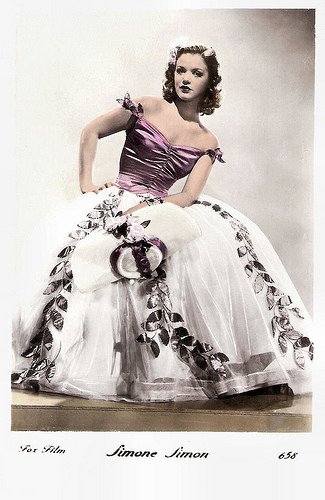
French postcard by Erpé, no. 658. Photo: Fox Film.
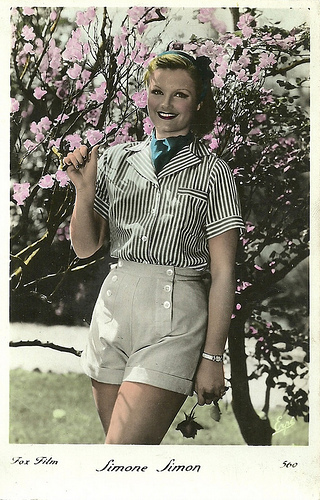
French postcard by Erpé, no. 560. Photo: Fox Film.
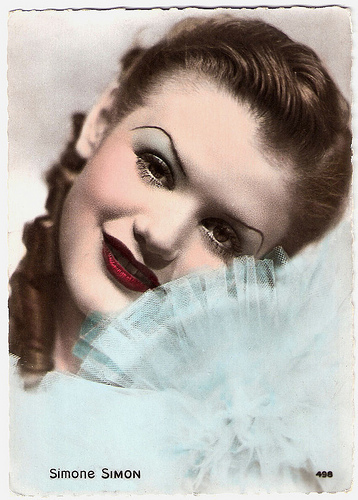
French postcard, no. 498. Photo: publicity still for Les yeux noirs/Black eyes (Marc Allégret, 1935).
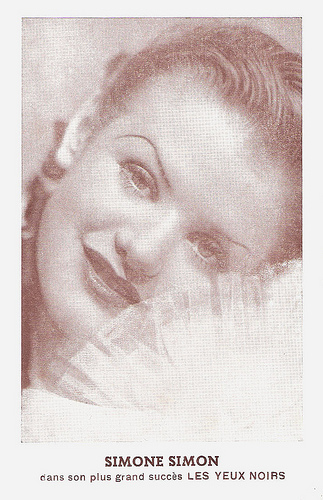
French postcard. Photo: publicity still for Les yeux noirs/Black eyes (Marc Allégret, 1935).
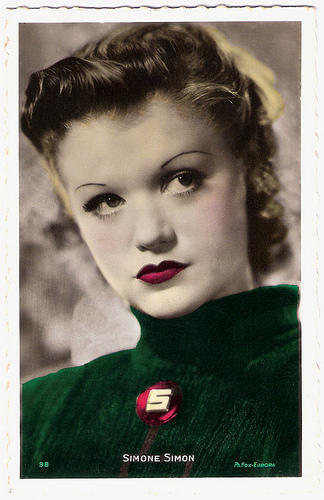
Vintage postcard, no. 98. Photo: Fox-Europa.
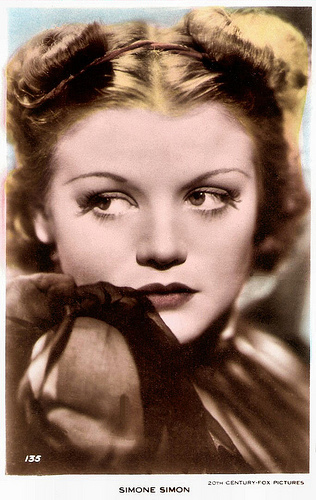
British postcard in the Art Photo series, no. 37-2. Photo: 20th Century Fox, no. 135.
Tyrolean Romance
Simone Thérèse Fernande Simon was born in Marseille, France (some sources say Béthune, a small town in the Pas de Calais province near the Belgian border) in 1910 (some sources say 1911). She was the daughter of Henri Louis Firmin, a French engineer, and Erma Maria Domenica Giorcelli, an Italian housewife.
Simone spent much of her early childhood in Madagascar, where her father managed a graphite mine. Her schooling was somewhat unsettled, her family moving from city to city (Berlin, Budapest, Turin) before finally establishing themselves in Paris in 1930.
There she worked briefly as a singer, model and fashion designer. She was discovered for the cinema by exiled Russian director Victor Tourjansky, who cast her in Le Chanteur inconnu/The Unknown Singer (1931), starring opera singer Lucien Muratore.
By the time Tourjansky and Simon worked together again, in Les Yeux noirs/Dark Eyes (Victor Tourjansky, 1935), Simon had already established herself as a popular young player in the French film industry.
She had achieved stardom with her role opposite Jean-Pierre Aumont in the delicate Tyrolean romance Lac aux dames/Ladies Lake (Marc Allégret, 1934), adapted by Colette from Vicki Baum's novel.
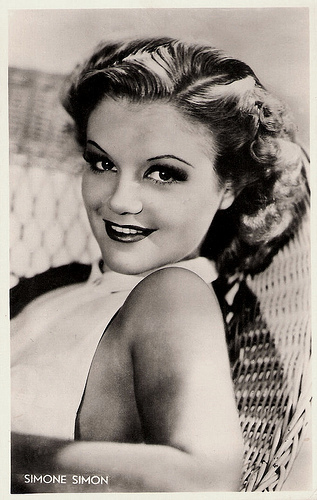
Dutch postcard by J.S.A. Photo: Century Fox / M.P.E.
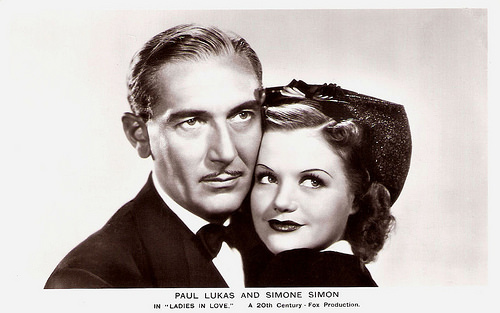
British postcard by Real Photograph, London, no. FS 101. Photo: 20th Century Fox. Publicity still for Ladies in Love (Edward H. Griffith, 1936) with Paul Lukas.
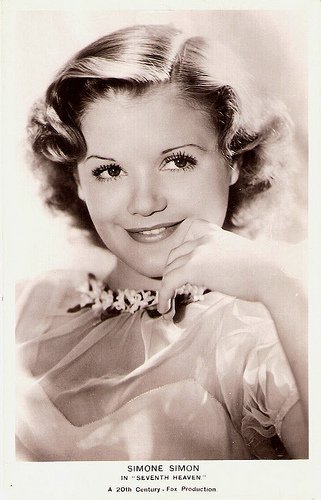
British postcard in the Picturegoer Series, London, no. 1093a. Photo: 20th Century Fox. Publicity still for Seventh Heaven (Henry King, 1937).
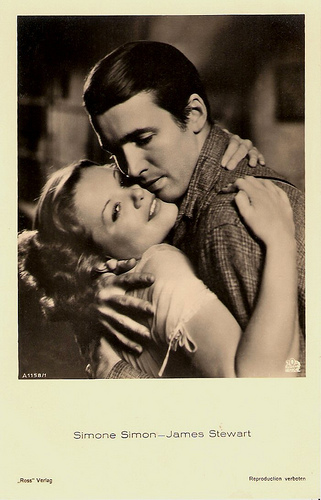
German postcard by Ross Verlag, no. A 1158/1, 1937-1938. Photo: 20th Century Fox. Still from Seventh Heaven (Henry King, 1937) with Simone Simon and James Stewart.
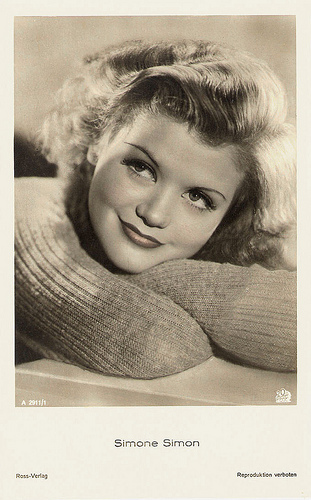
German postcard by Ross Verlag, no. A 2911/1, 1939-1940. Photo: Twentieth Century Fox.
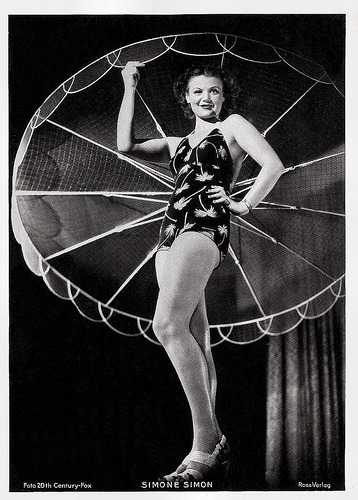
Big German Ross Verlag card. Photo: 20th Century Fox.
Europe’s Sweetheart
After seeing Simone Simon in Lac Aux Dames, Fox mogul Darryl F. Zanuck brought her to Hollywood in 1936. A widespread publicity campaign billed her as ‘Europe’s Sweetheart’. However her films for 20th Century Fox were only moderately successful.
In Girls’ Dormitory (Irving Cummings, 1936) she competed with Ruth Chatterton for the attentions of Herbert Marshall ; and in Ladies in Love (Edward H. Griffith, 1936), she was fourth-billed after Janet Gaynor, Loretta Young, and Constance Bennett.
In Seventh Heaven (Henry King, 1937), a remake of the 1927 silent version with Janet Gaynor and Charles Farrell, she played one of her best roles as a Parisian street urchin romancing a miscast James Stewart. Unfortunately the film flopped, and 'See-moan See-moan' returned, dissatisfied, to France.
There, she reestablished herself as an actress to be reckoned with in the influential, moody drama La Bête Humaine/The Human Beast (Jean Renoir, 1938), based on Emile Zola’s novel. The film exudes the dark, fatalistic sensibility of the ‘poetic realism’ cycle of sombre romances of Marcel Carné and Julien Duvivier in the 1930s. A train driver ( Jean Gabin ) falls in love with the wife of a railwayman , beautifully played by Simon.
The exquisite film was a huge hit. Jean Renoir offered her next the role of Christine de la Chesnaye in La règle du jeu/The Rules of the Game (Jean Renoir, 1939), but Simone Simon preferred to return to Hollywood.
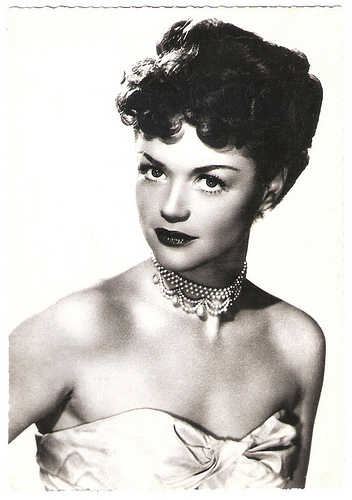
Vintage postcard, no. 2903. Sent by mail in Belgrade in 1960.
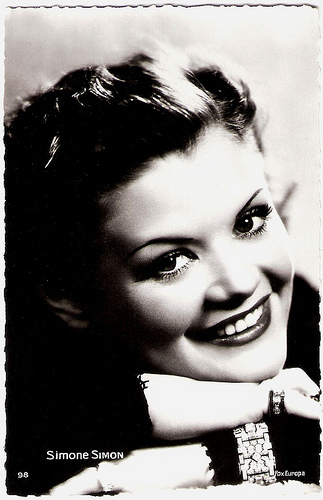
French postcard by Collection Chantal, Paris, no. 98. Photo: Fox Europa.
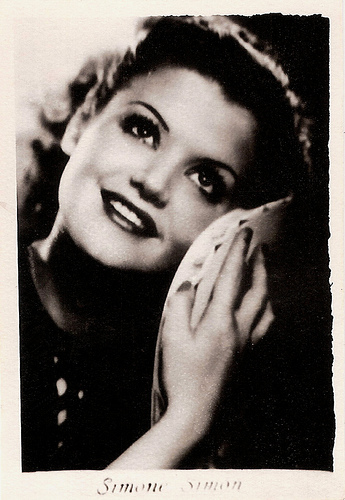
Small collector's card.
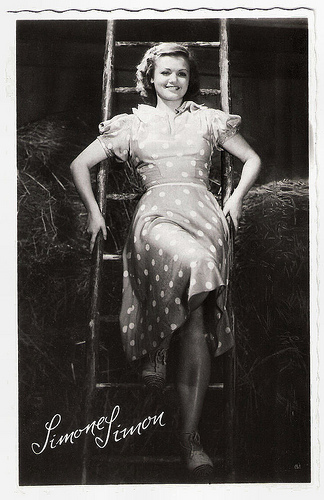
French postcard, no. 61.
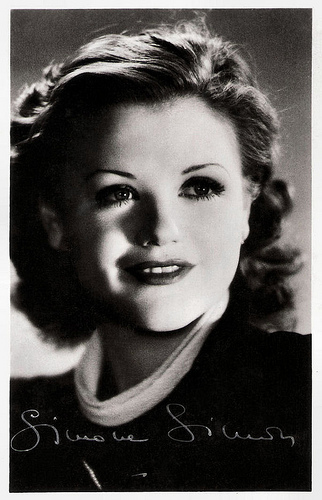
French postcard.
Bewitching, Unearthly Seductress
For RKO Studios Simone Simon achieved her greatest Hollywood successes with a bewitching portrayal of an unearthly seductress in The Devil and Daniel Webster (William Dieterle, 1941), and as a troubled woman who believes she turns into a panther whenever she gets emotionally stirred up, in the cult horror film Cat People (Jacques Tourneur, 1942).
These films, however, did not lead to more good roles and she languished in mediocre films – and a small part as a ghost in the interesting sequel The Curse of the Cat People (Robert Wise, 1944) - until the end of the war. Then she returned to France permanently.
She and Edwige Feuillère were owners of an 1880s girls' boarding school in the controversial Olivia/The Pit of Loneliness (Jacqueline Audry, 1950), which had censor boards outraged at its portrayal of lesbianism.
The same year, she was one of the many stars in La Ronde/Roundabout (Max Ophüls, 1950), a witty version of Arthur Schnitzler's play depicting love as a bitterly comic merry-go-round. Two years later she made a second film with Ophüls, Le Plaisir/House of Pleasure (Max Ophüls, 1952), based on three stories by Guy de Maupassant. In the third episode, La Modèle, she was the lovesick model of a philandering artist ( Daniel Gélin ). When a suicide attempt leaves her crippled, he marries her out of pity, and in the haunting last shot he is seen wheeling her along the beach.
Her film roles were few after this, and she worked mainly onstage. Her final film appearance was in La Femme en bleu/The Woman in Blue (Michel Deville, 1973).
Simone Simon never married. During WW II she was dating double-agent Dusko Popov, who worked for MI5. In 1942 Simon was watched by the FBI, because of this relationship. The couple broke up in 1943. In the 1950s, she was romantically involved with the French banker and racehorse owner/breeder Alec Weisweiller. Simone Simon died in Paris in 2005, aged 94.
Clip of James Stewart and Simone Simon in Seventh Heaven (1937). Source: ClassicMovieShop (YouTube).
Trailer La Bête Humaine/The Human Beast (1938). Source: felixxxx999 (YouTube).
Trailer Cat People (1942). Source: ClassicMovieTarilers (YouTube).
Trailer Pétrus (1946). Source: _ XYZT (YouTube).
Sources: Andre Soares (Alternative Film Guide), Tom Vallance (The Independent), Bruce Eder (AllMovie), (IMDb), Wikipedia, and .

French postcard by Erpé, no. 658. Photo: Fox Film.

French postcard by Erpé, no. 560. Photo: Fox Film.

French postcard, no. 498. Photo: publicity still for Les yeux noirs/Black eyes (Marc Allégret, 1935).

French postcard. Photo: publicity still for Les yeux noirs/Black eyes (Marc Allégret, 1935).

Vintage postcard, no. 98. Photo: Fox-Europa.

British postcard in the Art Photo series, no. 37-2. Photo: 20th Century Fox, no. 135.
Tyrolean Romance
Simone Thérèse Fernande Simon was born in Marseille, France (some sources say Béthune, a small town in the Pas de Calais province near the Belgian border) in 1910 (some sources say 1911). She was the daughter of Henri Louis Firmin, a French engineer, and Erma Maria Domenica Giorcelli, an Italian housewife.
Simone spent much of her early childhood in Madagascar, where her father managed a graphite mine. Her schooling was somewhat unsettled, her family moving from city to city (Berlin, Budapest, Turin) before finally establishing themselves in Paris in 1930.
There she worked briefly as a singer, model and fashion designer. She was discovered for the cinema by exiled Russian director Victor Tourjansky, who cast her in Le Chanteur inconnu/The Unknown Singer (1931), starring opera singer Lucien Muratore.
By the time Tourjansky and Simon worked together again, in Les Yeux noirs/Dark Eyes (Victor Tourjansky, 1935), Simon had already established herself as a popular young player in the French film industry.
She had achieved stardom with her role opposite Jean-Pierre Aumont in the delicate Tyrolean romance Lac aux dames/Ladies Lake (Marc Allégret, 1934), adapted by Colette from Vicki Baum's novel.

Dutch postcard by J.S.A. Photo: Century Fox / M.P.E.

British postcard by Real Photograph, London, no. FS 101. Photo: 20th Century Fox. Publicity still for Ladies in Love (Edward H. Griffith, 1936) with Paul Lukas.

British postcard in the Picturegoer Series, London, no. 1093a. Photo: 20th Century Fox. Publicity still for Seventh Heaven (Henry King, 1937).

German postcard by Ross Verlag, no. A 1158/1, 1937-1938. Photo: 20th Century Fox. Still from Seventh Heaven (Henry King, 1937) with Simone Simon and James Stewart.

German postcard by Ross Verlag, no. A 2911/1, 1939-1940. Photo: Twentieth Century Fox.

Big German Ross Verlag card. Photo: 20th Century Fox.
Europe’s Sweetheart
After seeing Simone Simon in Lac Aux Dames, Fox mogul Darryl F. Zanuck brought her to Hollywood in 1936. A widespread publicity campaign billed her as ‘Europe’s Sweetheart’. However her films for 20th Century Fox were only moderately successful.
In Girls’ Dormitory (Irving Cummings, 1936) she competed with Ruth Chatterton for the attentions of Herbert Marshall ; and in Ladies in Love (Edward H. Griffith, 1936), she was fourth-billed after Janet Gaynor, Loretta Young, and Constance Bennett.
In Seventh Heaven (Henry King, 1937), a remake of the 1927 silent version with Janet Gaynor and Charles Farrell, she played one of her best roles as a Parisian street urchin romancing a miscast James Stewart. Unfortunately the film flopped, and 'See-moan See-moan' returned, dissatisfied, to France.
There, she reestablished herself as an actress to be reckoned with in the influential, moody drama La Bête Humaine/The Human Beast (Jean Renoir, 1938), based on Emile Zola’s novel. The film exudes the dark, fatalistic sensibility of the ‘poetic realism’ cycle of sombre romances of Marcel Carné and Julien Duvivier in the 1930s. A train driver ( Jean Gabin ) falls in love with the wife of a railwayman , beautifully played by Simon.
The exquisite film was a huge hit. Jean Renoir offered her next the role of Christine de la Chesnaye in La règle du jeu/The Rules of the Game (Jean Renoir, 1939), but Simone Simon preferred to return to Hollywood.

Vintage postcard, no. 2903. Sent by mail in Belgrade in 1960.

French postcard by Collection Chantal, Paris, no. 98. Photo: Fox Europa.

Small collector's card.

French postcard, no. 61.

French postcard.
Bewitching, Unearthly Seductress
For RKO Studios Simone Simon achieved her greatest Hollywood successes with a bewitching portrayal of an unearthly seductress in The Devil and Daniel Webster (William Dieterle, 1941), and as a troubled woman who believes she turns into a panther whenever she gets emotionally stirred up, in the cult horror film Cat People (Jacques Tourneur, 1942).
These films, however, did not lead to more good roles and she languished in mediocre films – and a small part as a ghost in the interesting sequel The Curse of the Cat People (Robert Wise, 1944) - until the end of the war. Then she returned to France permanently.
She and Edwige Feuillère were owners of an 1880s girls' boarding school in the controversial Olivia/The Pit of Loneliness (Jacqueline Audry, 1950), which had censor boards outraged at its portrayal of lesbianism.
The same year, she was one of the many stars in La Ronde/Roundabout (Max Ophüls, 1950), a witty version of Arthur Schnitzler's play depicting love as a bitterly comic merry-go-round. Two years later she made a second film with Ophüls, Le Plaisir/House of Pleasure (Max Ophüls, 1952), based on three stories by Guy de Maupassant. In the third episode, La Modèle, she was the lovesick model of a philandering artist ( Daniel Gélin ). When a suicide attempt leaves her crippled, he marries her out of pity, and in the haunting last shot he is seen wheeling her along the beach.
Her film roles were few after this, and she worked mainly onstage. Her final film appearance was in La Femme en bleu/The Woman in Blue (Michel Deville, 1973).
Simone Simon never married. During WW II she was dating double-agent Dusko Popov, who worked for MI5. In 1942 Simon was watched by the FBI, because of this relationship. The couple broke up in 1943. In the 1950s, she was romantically involved with the French banker and racehorse owner/breeder Alec Weisweiller. Simone Simon died in Paris in 2005, aged 94.
Clip of James Stewart and Simone Simon in Seventh Heaven (1937). Source: ClassicMovieShop (YouTube).
Trailer La Bête Humaine/The Human Beast (1938). Source: felixxxx999 (YouTube).
Trailer Cat People (1942). Source: ClassicMovieTarilers (YouTube).
Trailer Pétrus (1946). Source: _ XYZT (YouTube).
Sources: Andre Soares (Alternative Film Guide), Tom Vallance (The Independent), Bruce Eder (AllMovie), (IMDb), Wikipedia, and .
Published on June 27, 2017 22:00
June 26, 2017
Marcello Mastroianni
We're in Italy at Il Cinema Ritrovato and today we feature Marcello Mastroianni (1924-1996), Italy's favourite leading man of the second half of the 20th century. In his long and prolific career, he almost singlehandedly defined the contemporary type of Latin lover, then proceeded to redefine it a dozen times and finally parodied it and played it against type. One of his first films, Domenica d’agosto (Luciano Emmer, 1950), a nostalgic look at Rome's favourite recreation area: the beach at Ostia, is shown in the section A Sunday in Bologna. Marcello plays a traffic cop who devotedly helps his struggling girlfriend. "The film truly is a little gem with a wink and a big beating heart", according to the IMDb reviewer.
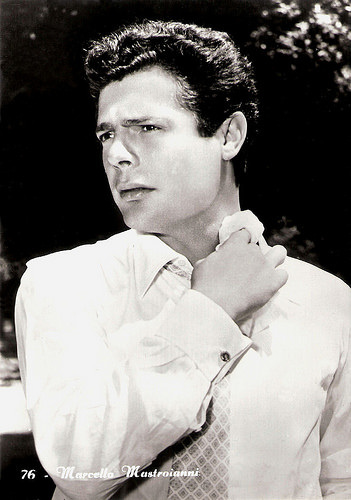
Italian postcard by Turismofoto, no. 76.
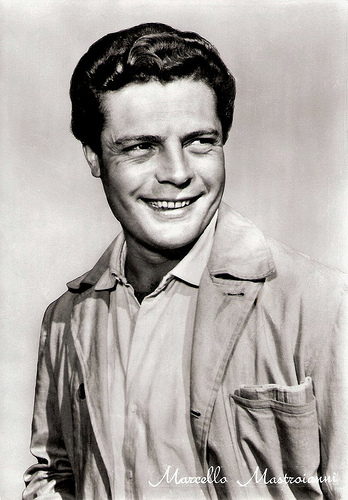
Italian postcard by Rotal Foto, Milano (Milan), no. 250.
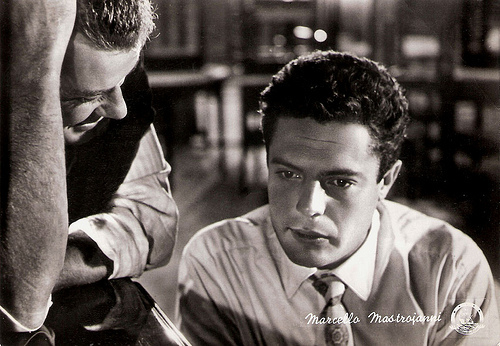
Italian postcard by Bromofoto, Milano, no. 460.
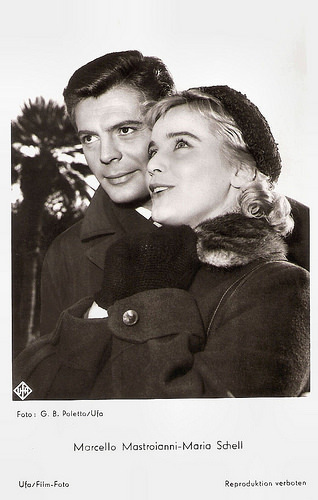
German postcard by Ufa, Berlin-Tempelhof, no. FK 3486. Photo: G.B. Poletto. Publicity still for Le notti bianche/ White Nights (Luchino Visconti, 1957) with Maria Schell.
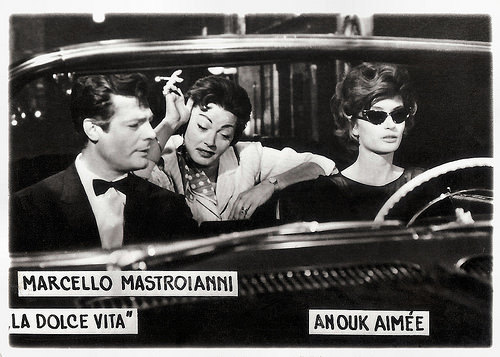
Small Romanian collectors card by Casa Filmului Acin. Photo: publicity still for La Dolce Vita (Federico Fellini, 1960) with Anouk Aimée.
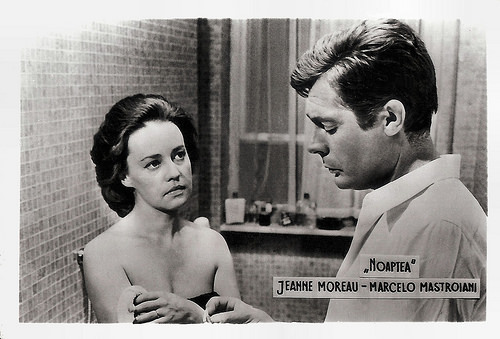
Small Romanian collectors card by Casa Filmului Acin. Photo: publicity stil for La Notte (Michelangerlo Antonioni, 1961) with Jeanne Moreau.
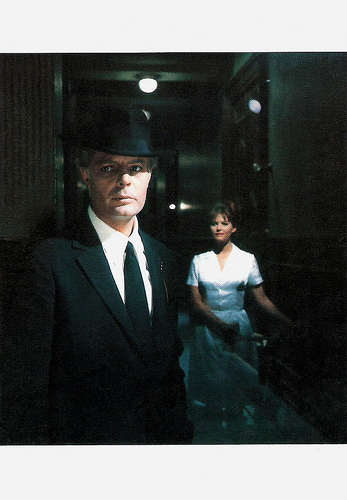
French postcard by Edition La Malibran, Paris, no. MC 38, 1990. Photo: Claude Schwartz. Publicity still for Otto e Mezzo/8½ (Federico Fellini, 1963) with Claudia Cardinale.
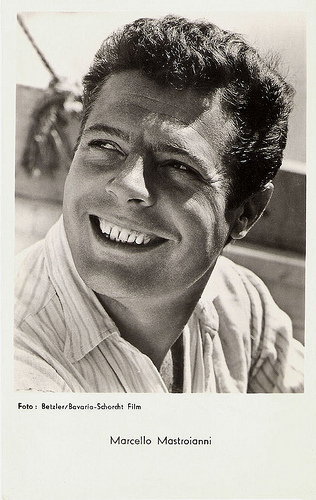
Franco-German postcard by Ufa AG, Berlin/Editions P.I., Paris. Photo: Betzler / Bavaria / Schorcht Film.
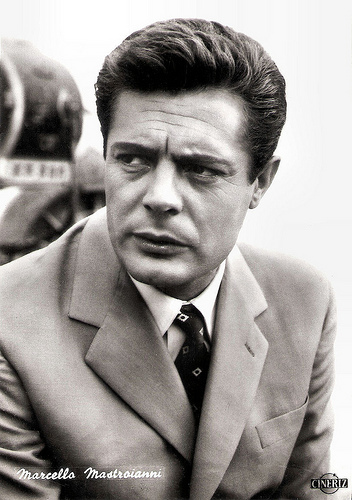
Italian postcard by Bromofoto, no. 1445. Photo: Cineriz.
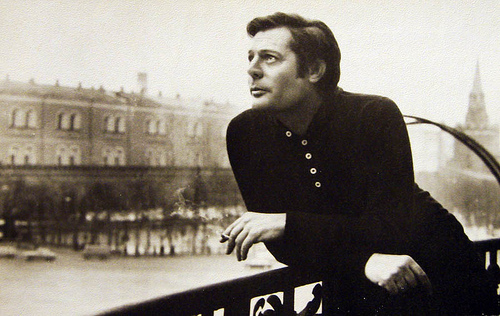
Russian postcard from 1987. Collection: Pierre sur le Ciel.
Forced-labour Camp
Marcello Vincenzo Domenico Mastroianni was born in Fontana Liri, a small village in the Apennines, in 1924. He was the son of Ida (née Irolle) and Ottone Mastroianni, who ran a carpentry shop. Marcello grew up in Turin and Rome.
He appeared as an uncredited extra in Marionette (Carmine Gallone, 1939) and later appeared as an extra in Una storia d'amore/Love Story (Mario Camerini, 1942) and I bambini ci guardano/The Children Are Watching Us ( Vittorio De Sica , 1944).
He worked in his father's carpentry shop, but during World War II he was put to work by the Germans drawing maps. During 1943–1944 he was imprisoned in a forced-labour camp, but he escaped and hid in Venice.
In 1944, Mastroianni started working as a cashier for film company Eagle Lion (Rank) in Rome. He began taking acting lessons and acted with the University of Rome dramatic group. In the university's production of Angelica (1948) he appeared with Giulietta Masina .
His first real film credit was in I Miserabili/Les misérables (Riccardo Freda, 1948) with Gino Cervi .
That year Mastroianni joined Luchino Visconti's repertory company, which was bringing to Italy a new kind of theatre and novel ideas of staging. The young actor played Mitch in A Streetcar Named Desire, Happy in Death of a Salesman, Stanley Kowalski in Visconti's second staging of Streetcar, and roles in Anton Chekhov's Three Sisters and Uncle Vanya.
He also acted in radio plays and he had his first substantial film role in the comedy Una domenica d'agosto/Sunday in August (Luciano Emmer, 1949).
In 1955 Mastroianni co-starred with Vittorio De Sica and Sophia Loren - an actress with whom he would frequently be paired in the years to come - in the screwball comedy Peccato che Sia una Canaglia/Too Bad She's Bad (Alessandro Blasetti, 1955) and later worked with De Sica again on the comedy Padri e Figli/Like Father, Like Son (Mario Monicelli, 1957).
His roles gradually increased in importance, but for the most part both the casts and crews of his projects were undistinguished, and he remained an unknown outside of Italy. Mastroianni permanently sealed his stardom in Italy, playing a timid clerk whose love is not reciprocated by Maria Schell , in Le notti bianche/White Nights (Luchino Visconti, 1957).
He soon became a major international star appearing in films like I soliti ignoti/Big Deal on Madonna Street (Mario Monicelli, 1958) with Vittorio Gassman . In this classic crime caper he displayed a light touch for comedy, playing the exasperated member of an inept group of burglars.
In 1960 he played his most famous role as a disillusioned and world-weary tabloid columnist who spends his days and nights exploring Rome's high society in Federico Fellini's La dolce vita/The Sweet Life (1960) with Anita Ekberg . La dolce vita changed the look and direction of the Italian cinema.
Hal Erickson at AllMovie : "Throughout his adventures, Marcello's dreams, fantasies, and nightmares are mirrored by the hedonism around him. With a shrug, he concludes that, while his lifestyle is shallow and ultimately pointless, there's nothing he can do to change it and so he might as well enjoy it. Fellini's hallucinatory, circus-like depictions of modern life first earned the adjective 'Felliniesque' in this celebrated movie, which also traded on the idea of Rome as a hotbed of sex and decadence. A huge worldwide success, La Dolce Vita won several awards, including a New York Film Critics Circle award for Best Foreign Film and the Palme d'Or at the Cannes Film Festival."
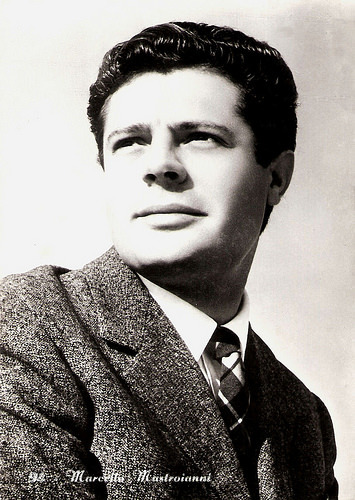
Italian postcard by Turismofoto, no. 94.
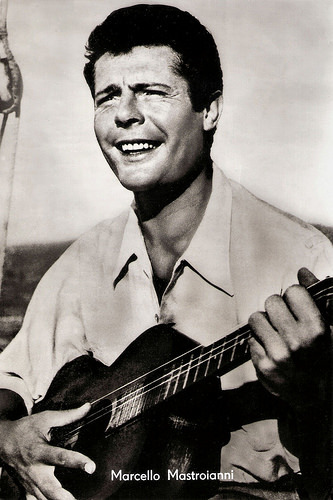
Big East-German card by VEB Progress Film-Vertrieb, Berlin, no. 68/72. Photo: Steffen.
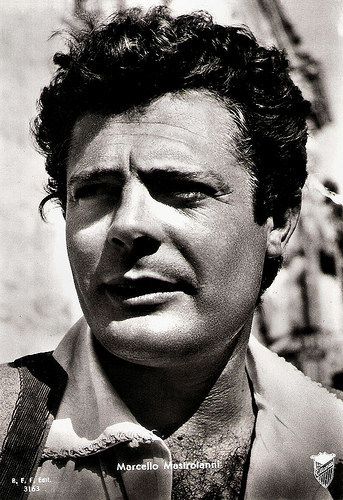
Italian postcard by B.F.F. Edit., no. 3163. Photo: Titanus. Publicity still for La Bella Mugnaia/The Miller's Beautiful Wife (Mario Camerini, 1955).
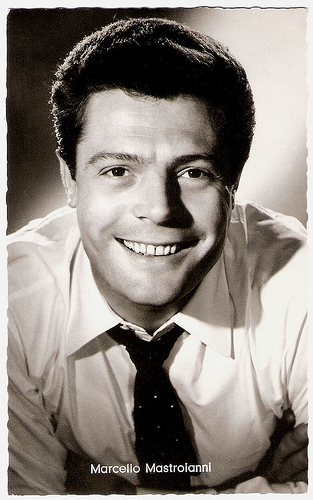
German postcard by Kolibri-Verlag, Minden / Westf., no. 2361. Photo: Bavaria / Schorcht / Vogelmann. Publicity still for Mädchen und Männer/La ragazza della salina/Sand, Love and Salt (1957).
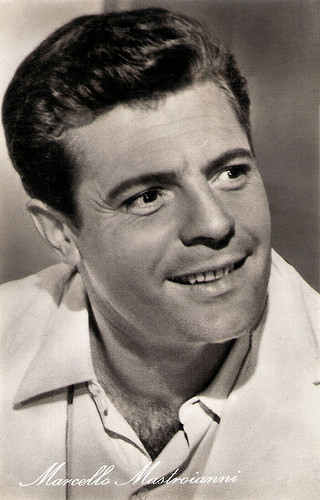
East-German postcard by Progress, no. 1372, 1960.
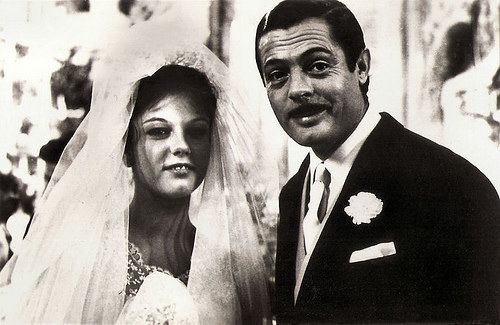
Small Czech collectors card by Pressfoto, Praha (Prague), 1965, no. S 83/6. Publicity still for Divorzio all'italiana/Divorce, Italian Style (Pietro Germi, 1961) with Stefania Sandrelli.
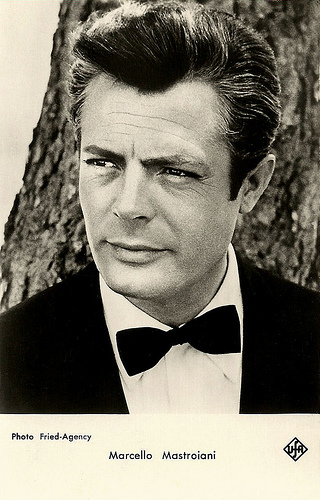
Franco-German postcard by Ufa AG / Editions P.I. Photo: Fried Agency.
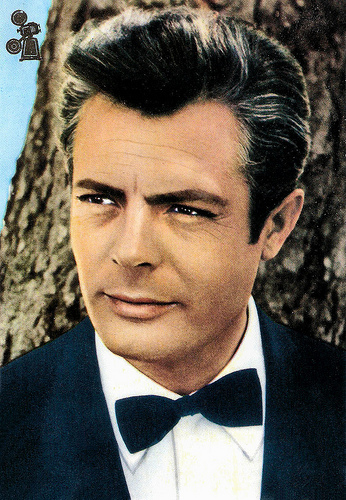
Spanish postcard by Toro de Bronce, no. 44, 1963.

Small Czechoslovakian card by Presseojo, Praha (Prague), 1964. Retail price: 0,50 Kcs.
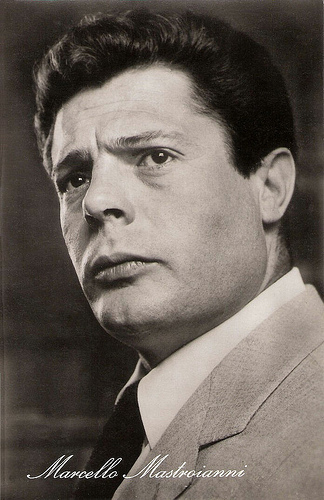
East-German postcard by VEB Progress Film-Vertrieb, no. 512, 1958. Retail price: 0,20 DM. Photo: Unitalia.
Not one-dimensional pretty boys
During the 1960s Marcello Mastroianni played in many great films and regularly worked with top Italian and French filmmakers. He appeared as the title character in Il bell'Antonio/Bell' Antonio (Mauro Bolognini, 1960) and starred in Michelangelo Antonioni’s masterpiece La notte/The Night (1961), where again his distanced, expressionless demeanour fit perfectly into the film's air of alienation and remote emotionality.
He appeared in interesting films like L'assassino/The Assassin (1961, Elio Petri), La Vie Privée/A Very Private Affair (1962, Louis Malle) with Brigitte Bardot , and Cronaca familiare/Family Diary (Valerio Zurlini, 1962) with Jacques Perrin .
Mastroianni followed La dolce vita with another signature role for Fellini, that of Fellini’s alter-ego, a film director who, amidst self-doubt and troubled love affairs, finds himself in a creative block while making a film in Otto e Mezzo/8½ (Federico Fellini, 1962). The film won two Academy Awards.
Mastroianni won the British BAFTA award twice for his roles in the black comedy Divorzio all'Italiana/Divorce, Italian Style (Pietro Germi, 1963) and the deliciously funny three-part sex farce Ieri, oggi, domani/Yesterday, Today, and Tomorrow (Vittorio De Sica, 1963) costarring with Sophia Loren . He and Loren starred together again in the equally amusing sex comedy Matrimonio all'italiana/Marriage Italian Style (Vittorio De Sica, 1964).
According to Elaine Mancini on Film Reference “Mastroianni's masculinity blends perfectly with Loren's exuberant earthy personality” in both these films. While he was to become known for playing Latin lover roles (which he spoofed in Casanova 70 (Mario Monicelli, 1965), his characters often were far more complexly drawn. They were not one-dimensional pretty boys; rather, beneath their handsome exteriors they were lazy, world-weary, and doubt-ridden.
Other films were La decima vittima/The Tenth Victim (Elio Petri, 1965) with Ursula Andress and the Albert Camus adaptation Lo Straniero/The Stranger (Luchino Visconti, 1967) with Anna Karina .
Mastroianni won the Best Actor award at the Cannes Film Festival for Dramma della gelosia - tutti i particolari in cronaca/Drama of Jealousy (Ettore Scola, 1970). In 1987 he would win the award again for Oci ciornie/Dark Eyes (Nikita Mikhalkov, 1987). Mastroianni, Dean Stockwell and Jack Lemmon are the only actors to have won the award twice.
During the 1970s Mastroianni continued to work in interesting films by prolific directors like Leo the Last (John Boorman, 1970), Permette? Rocco Papaleo/My Name Is Rocco Papaleo (Ettore Scola, 1971) with Lauren Hutton, Che?/What? (Roman Polanski, 1972) with Sydne Rome and La donna della domenica/The Sunday Woman (Luigi Comencini, 1975) with Jacqueline Bisset .
He often worked with controversial director Marco Ferreri at Liza (Marco Ferreri, 1972) with Catherine Deneuve , La Grande Bouffe/Blow Out (Marco Ferreri, 1973), Touche pas à la femme blanche/ Don't Touch the White Woman! (Marco Ferreri, 1974), and Ciao maschio/Bye Bye Monkey (Marco Ferreri, 1978) with Gérard Depardieu .
Other interesting films are Così come sei/Stay as You Are (Alberto Lattuada, 1978) with Nastassja Kinski , L'ingorgo - Una storia impossibile/Traffic Jam (Luigi Comencini, 1979) with Annie Girardot , and La terrazza/The Terrace (Ettore Scola, 1980) with Vittorio Gassman .
He played against his Latin lover image in Scola’s Una giornata particolare/A Special Day (Ettore Scola, 1977), in which Mastroianni's homosexual and Sophia Loren 's oppressed housewife come together on the day in 1938 when Adolph Hitler was cheered on the streets of Rome during his visit to Benito Mussolini.
His seemingly detached air was perfectly suited to satire as well, as he demonstrated in films as diverse as the historical drama Allonsanfàn (Paolo and Vittorio Taviani, 1974), and La città delle donne/City of Women (Federico Fellini, 1980).
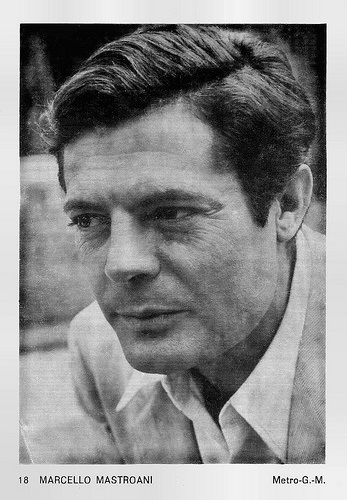
Belgian card by Publishop, Brussels for Cine Metro, Antwerpen, no. 18. Photo: MGM.
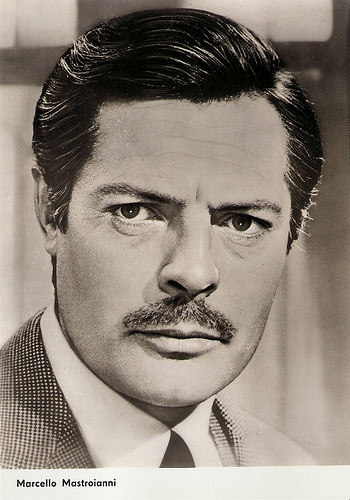
East-German postcard by VEB Progress Film-Vertrieb, Berlin, no. 2634. Photo: publicity still for Matrimonio all'italiana/Marriage Italian Style (Vittorio De Sica, 1964).
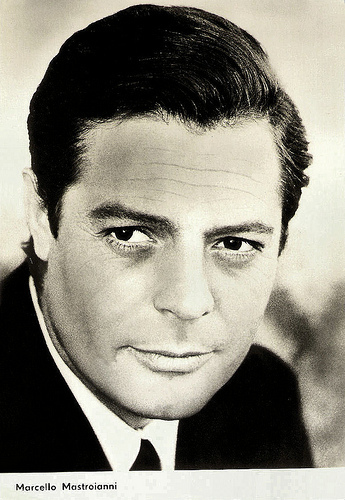
East-German postcard by VEB Progress Film-Vertrieb, Berlin, no. 2557, 1966.
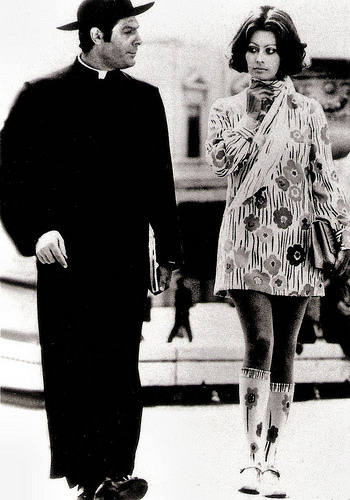
German postcard by pwe Verlag, München (Munich). Photo: publicity still for La moglie del prete/The Priest's Wife (Dino Risi, 1970) with Sophia Loren.
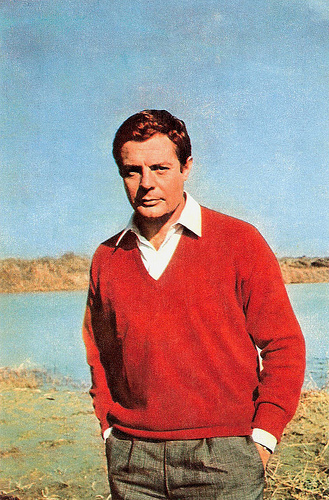
Russian postcard by Izdanije Byuro Propogandy Sovietskogo Kinoiskusstva, no. 3624, 1975. This postcard was printed in an edition of 200.000 cards. Retail price: 5 kop.
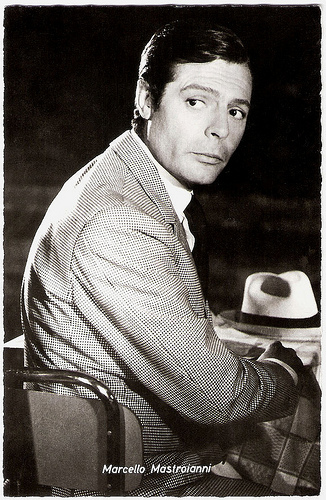
German postcard by Friedrich W. Sander Verlag, Minden. Photo: Inter Film. Still for Casanova 70 (Mario Monicelli, 1970).
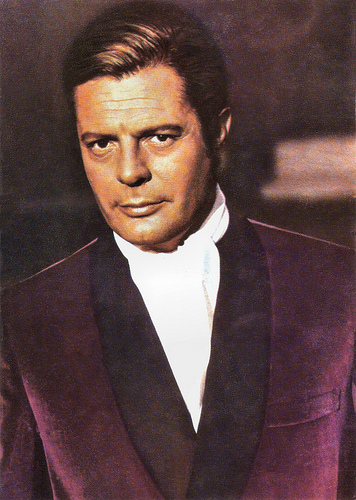
Romanian postcard by Casa Filmului Acin, no. 4881.
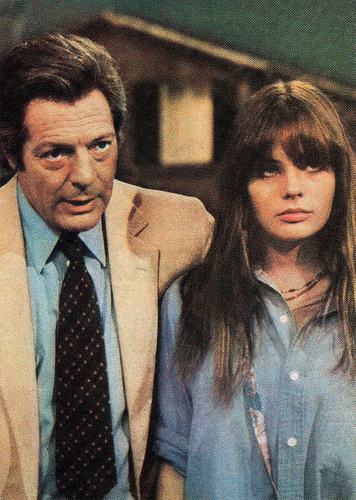
Romanian postcard by Casa Filmului Acin. Photo: publicity still for La terrazza (Ettore Scola, 1980) with Marie Trintignant.
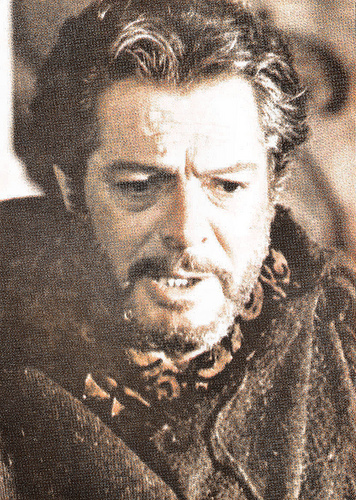
Romanian postcard by Casa Filmului Acin. Photo: publicity still for Enrico IV/Henry IV (Marco Bellocchio, 1984).
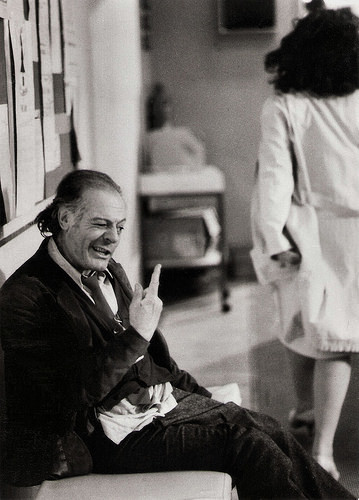
German press photo, no. 5. Photo: Tobis. Publicity still for Ginger e Fred (Federico Fellini, 1986).
Wonderfully Nostalgic
In the latter stages of his career, Marcello Mastroianni continued to take serious dramatic roles. For instance, he played the senior citizen who simply looks back on his past. In Stanno tutti bene/Everybody's Fine (Giuseppe Tornatore, 1990), he is an elderly man who is absorbed in his memories, and who travels through Italy to call on his five adult children.
In Oci ciornie/Dark Eyes (Nikita Mikhalkov, 1987), he gives a tour-de-force performance as a once young and idealistic aspiring architect who married a banker's daughter, fell into a lifestyle of afternoon snoozes and philandering, and proved incapable of holding onto what was important to him.
His on-screen presence has also been directly linked to his earlier screen characterisations. In Prêt-à-Porter/Ready to Wear (Robert Altman, 1994), he was reunited with Sophia Loren , and at one point in the scenario, she recreated her famous steamy striptease sequence from Yesterday, Today, and Tomorrow. Loren was as beguiling as she had been 30 years earlier but Mastroianni was no longer the attentive young lover, so Sophia's seductive moves only put him to sleep.
Mastroianni's appearance in two of Fellini's final features is especially sentimental. Ginger e Fred/Ginger and Fred (Federico Fellini, 1996) is sweetly nostalgic for its union of Mastroianni and Giulietta Masina , two of the maestro's then-aging but still vibrant stars of the past.
In Intervista (Federico Fellini, 1987), he appears as himself with Anita Ekberg , with whom he had starred decades before in La dolce vita. Mastroianni's entrance is especially magical; the sequence in which he and Ekberg (who, he remarks, he has not seen since making La dolce vita) observe their younger selves in some famous clips from that film is wonderfully nostalgic.
In 1988 Mastroianni was honoured with a Lifetime Achievement Award at the European Film Awards. He kept appearing in critically acclaimed films like To meteoro vima tou pelargou/The Suspended Step of the Stork (Theodoros Angelopoulos, 1991), in which he was quietly poignant as an obscure man who may have once been an important Greek politician who had disappeared years earlier.
Other films were Al di là delle nuvole/Beyond the Clouds (Michelangelo Antonioni, 1995) and Trois vies et une seule mort/Three Lives and Only One Death (Raúl Ruiz, 1996) with Anna Galiena. His final film was Viagem ao Princípio do Mundo/Voyage to the Beginning of the World (Manoel de Oliveira, 1997).
Marcello Mastroianni was married to Italian actress Flora Carabella (1926-1999) from 1948 until his death. They had one child together, Barbara. Mastroianni also had a daughter, actress Chiara Mastroianni, with French film star Catherine Deneuve , his longtime lover during the 1970s.
Both Flora and Catherine were at his bedside in Paris when he died of pancreatic cancer at the age of 72, as was his partner at the time, author and filmmaker Anna Maria Tatò. According to Christopher Wiegand and Paul Duncan in their book Federico Fellini, when Mastroianni died in 1996, the Fontana di Trevi (Trevi Fountain), which is so famously associated with him due to his role in Fellini's La dolce vita, was symbolically turned off and draped in black as a tribute.
His brother Ruggero Mastroianni (1929-1996) was a highly regarded film editor who edited several of Marcello's films directed by Federico Fellini, and appeared alongside Marcello in Scipione detto anche l'Africano/Scipio the African (Luigi Magni, 1971), a comedic take on the once popular Peplum, the sword and sandal film genre. Marcello Mastroianni had held starring roles in about 120 films over the course of his long career.
Trailer for Domenica d'agosto (1950). Source: Ugo Tramontano (YouTube).
The classic Trevi Fountain scene in La dolce vita/The Sweet Life (1960) with Anita Ekberg . Source: רונן אברהם (YouTube).
Trailer for 8 1/2 (1961). Source: BFI (YouTube).
Trailer for La Notte (1961). Source: Hadalat (YouTube).
Trailer for Ieri, oggi, domani/Yesterday, Today, and Tomorrow (1963). Source: Jeffrey M. Anderson (YouTube).
Trailer for La Grande Bouffe/Blow Out (1973). Source: Arrow Video (YouTube).
Trailer for Una giornata particolare/A Special Day (1977). Source: Argent Films (YouTube).
Trailer for La città delle donne/City of Women (1980). Source: Das Film Feuilleton (YouTube).
Trailer for Ginger e Fred/Ginger and Fred (1986). Source: Movieclips Trailer Vault (YouTube).
Sources: Elaine Mancini (Film Reference; updated by Rob Edelman), Hal Erickson (AllMovie), Jason Ankeny (AllMovie), Wikipedia and .

Italian postcard by Turismofoto, no. 76.

Italian postcard by Rotal Foto, Milano (Milan), no. 250.

Italian postcard by Bromofoto, Milano, no. 460.

German postcard by Ufa, Berlin-Tempelhof, no. FK 3486. Photo: G.B. Poletto. Publicity still for Le notti bianche/ White Nights (Luchino Visconti, 1957) with Maria Schell.

Small Romanian collectors card by Casa Filmului Acin. Photo: publicity still for La Dolce Vita (Federico Fellini, 1960) with Anouk Aimée.

Small Romanian collectors card by Casa Filmului Acin. Photo: publicity stil for La Notte (Michelangerlo Antonioni, 1961) with Jeanne Moreau.

French postcard by Edition La Malibran, Paris, no. MC 38, 1990. Photo: Claude Schwartz. Publicity still for Otto e Mezzo/8½ (Federico Fellini, 1963) with Claudia Cardinale.

Franco-German postcard by Ufa AG, Berlin/Editions P.I., Paris. Photo: Betzler / Bavaria / Schorcht Film.

Italian postcard by Bromofoto, no. 1445. Photo: Cineriz.

Russian postcard from 1987. Collection: Pierre sur le Ciel.
Forced-labour Camp
Marcello Vincenzo Domenico Mastroianni was born in Fontana Liri, a small village in the Apennines, in 1924. He was the son of Ida (née Irolle) and Ottone Mastroianni, who ran a carpentry shop. Marcello grew up in Turin and Rome.
He appeared as an uncredited extra in Marionette (Carmine Gallone, 1939) and later appeared as an extra in Una storia d'amore/Love Story (Mario Camerini, 1942) and I bambini ci guardano/The Children Are Watching Us ( Vittorio De Sica , 1944).
He worked in his father's carpentry shop, but during World War II he was put to work by the Germans drawing maps. During 1943–1944 he was imprisoned in a forced-labour camp, but he escaped and hid in Venice.
In 1944, Mastroianni started working as a cashier for film company Eagle Lion (Rank) in Rome. He began taking acting lessons and acted with the University of Rome dramatic group. In the university's production of Angelica (1948) he appeared with Giulietta Masina .
His first real film credit was in I Miserabili/Les misérables (Riccardo Freda, 1948) with Gino Cervi .
That year Mastroianni joined Luchino Visconti's repertory company, which was bringing to Italy a new kind of theatre and novel ideas of staging. The young actor played Mitch in A Streetcar Named Desire, Happy in Death of a Salesman, Stanley Kowalski in Visconti's second staging of Streetcar, and roles in Anton Chekhov's Three Sisters and Uncle Vanya.
He also acted in radio plays and he had his first substantial film role in the comedy Una domenica d'agosto/Sunday in August (Luciano Emmer, 1949).
In 1955 Mastroianni co-starred with Vittorio De Sica and Sophia Loren - an actress with whom he would frequently be paired in the years to come - in the screwball comedy Peccato che Sia una Canaglia/Too Bad She's Bad (Alessandro Blasetti, 1955) and later worked with De Sica again on the comedy Padri e Figli/Like Father, Like Son (Mario Monicelli, 1957).
His roles gradually increased in importance, but for the most part both the casts and crews of his projects were undistinguished, and he remained an unknown outside of Italy. Mastroianni permanently sealed his stardom in Italy, playing a timid clerk whose love is not reciprocated by Maria Schell , in Le notti bianche/White Nights (Luchino Visconti, 1957).
He soon became a major international star appearing in films like I soliti ignoti/Big Deal on Madonna Street (Mario Monicelli, 1958) with Vittorio Gassman . In this classic crime caper he displayed a light touch for comedy, playing the exasperated member of an inept group of burglars.
In 1960 he played his most famous role as a disillusioned and world-weary tabloid columnist who spends his days and nights exploring Rome's high society in Federico Fellini's La dolce vita/The Sweet Life (1960) with Anita Ekberg . La dolce vita changed the look and direction of the Italian cinema.
Hal Erickson at AllMovie : "Throughout his adventures, Marcello's dreams, fantasies, and nightmares are mirrored by the hedonism around him. With a shrug, he concludes that, while his lifestyle is shallow and ultimately pointless, there's nothing he can do to change it and so he might as well enjoy it. Fellini's hallucinatory, circus-like depictions of modern life first earned the adjective 'Felliniesque' in this celebrated movie, which also traded on the idea of Rome as a hotbed of sex and decadence. A huge worldwide success, La Dolce Vita won several awards, including a New York Film Critics Circle award for Best Foreign Film and the Palme d'Or at the Cannes Film Festival."

Italian postcard by Turismofoto, no. 94.

Big East-German card by VEB Progress Film-Vertrieb, Berlin, no. 68/72. Photo: Steffen.

Italian postcard by B.F.F. Edit., no. 3163. Photo: Titanus. Publicity still for La Bella Mugnaia/The Miller's Beautiful Wife (Mario Camerini, 1955).

German postcard by Kolibri-Verlag, Minden / Westf., no. 2361. Photo: Bavaria / Schorcht / Vogelmann. Publicity still for Mädchen und Männer/La ragazza della salina/Sand, Love and Salt (1957).

East-German postcard by Progress, no. 1372, 1960.

Small Czech collectors card by Pressfoto, Praha (Prague), 1965, no. S 83/6. Publicity still for Divorzio all'italiana/Divorce, Italian Style (Pietro Germi, 1961) with Stefania Sandrelli.

Franco-German postcard by Ufa AG / Editions P.I. Photo: Fried Agency.

Spanish postcard by Toro de Bronce, no. 44, 1963.

Small Czechoslovakian card by Presseojo, Praha (Prague), 1964. Retail price: 0,50 Kcs.

East-German postcard by VEB Progress Film-Vertrieb, no. 512, 1958. Retail price: 0,20 DM. Photo: Unitalia.
Not one-dimensional pretty boys
During the 1960s Marcello Mastroianni played in many great films and regularly worked with top Italian and French filmmakers. He appeared as the title character in Il bell'Antonio/Bell' Antonio (Mauro Bolognini, 1960) and starred in Michelangelo Antonioni’s masterpiece La notte/The Night (1961), where again his distanced, expressionless demeanour fit perfectly into the film's air of alienation and remote emotionality.
He appeared in interesting films like L'assassino/The Assassin (1961, Elio Petri), La Vie Privée/A Very Private Affair (1962, Louis Malle) with Brigitte Bardot , and Cronaca familiare/Family Diary (Valerio Zurlini, 1962) with Jacques Perrin .
Mastroianni followed La dolce vita with another signature role for Fellini, that of Fellini’s alter-ego, a film director who, amidst self-doubt and troubled love affairs, finds himself in a creative block while making a film in Otto e Mezzo/8½ (Federico Fellini, 1962). The film won two Academy Awards.
Mastroianni won the British BAFTA award twice for his roles in the black comedy Divorzio all'Italiana/Divorce, Italian Style (Pietro Germi, 1963) and the deliciously funny three-part sex farce Ieri, oggi, domani/Yesterday, Today, and Tomorrow (Vittorio De Sica, 1963) costarring with Sophia Loren . He and Loren starred together again in the equally amusing sex comedy Matrimonio all'italiana/Marriage Italian Style (Vittorio De Sica, 1964).
According to Elaine Mancini on Film Reference “Mastroianni's masculinity blends perfectly with Loren's exuberant earthy personality” in both these films. While he was to become known for playing Latin lover roles (which he spoofed in Casanova 70 (Mario Monicelli, 1965), his characters often were far more complexly drawn. They were not one-dimensional pretty boys; rather, beneath their handsome exteriors they were lazy, world-weary, and doubt-ridden.
Other films were La decima vittima/The Tenth Victim (Elio Petri, 1965) with Ursula Andress and the Albert Camus adaptation Lo Straniero/The Stranger (Luchino Visconti, 1967) with Anna Karina .
Mastroianni won the Best Actor award at the Cannes Film Festival for Dramma della gelosia - tutti i particolari in cronaca/Drama of Jealousy (Ettore Scola, 1970). In 1987 he would win the award again for Oci ciornie/Dark Eyes (Nikita Mikhalkov, 1987). Mastroianni, Dean Stockwell and Jack Lemmon are the only actors to have won the award twice.
During the 1970s Mastroianni continued to work in interesting films by prolific directors like Leo the Last (John Boorman, 1970), Permette? Rocco Papaleo/My Name Is Rocco Papaleo (Ettore Scola, 1971) with Lauren Hutton, Che?/What? (Roman Polanski, 1972) with Sydne Rome and La donna della domenica/The Sunday Woman (Luigi Comencini, 1975) with Jacqueline Bisset .
He often worked with controversial director Marco Ferreri at Liza (Marco Ferreri, 1972) with Catherine Deneuve , La Grande Bouffe/Blow Out (Marco Ferreri, 1973), Touche pas à la femme blanche/ Don't Touch the White Woman! (Marco Ferreri, 1974), and Ciao maschio/Bye Bye Monkey (Marco Ferreri, 1978) with Gérard Depardieu .
Other interesting films are Così come sei/Stay as You Are (Alberto Lattuada, 1978) with Nastassja Kinski , L'ingorgo - Una storia impossibile/Traffic Jam (Luigi Comencini, 1979) with Annie Girardot , and La terrazza/The Terrace (Ettore Scola, 1980) with Vittorio Gassman .
He played against his Latin lover image in Scola’s Una giornata particolare/A Special Day (Ettore Scola, 1977), in which Mastroianni's homosexual and Sophia Loren 's oppressed housewife come together on the day in 1938 when Adolph Hitler was cheered on the streets of Rome during his visit to Benito Mussolini.
His seemingly detached air was perfectly suited to satire as well, as he demonstrated in films as diverse as the historical drama Allonsanfàn (Paolo and Vittorio Taviani, 1974), and La città delle donne/City of Women (Federico Fellini, 1980).

Belgian card by Publishop, Brussels for Cine Metro, Antwerpen, no. 18. Photo: MGM.

East-German postcard by VEB Progress Film-Vertrieb, Berlin, no. 2634. Photo: publicity still for Matrimonio all'italiana/Marriage Italian Style (Vittorio De Sica, 1964).

East-German postcard by VEB Progress Film-Vertrieb, Berlin, no. 2557, 1966.

German postcard by pwe Verlag, München (Munich). Photo: publicity still for La moglie del prete/The Priest's Wife (Dino Risi, 1970) with Sophia Loren.

Russian postcard by Izdanije Byuro Propogandy Sovietskogo Kinoiskusstva, no. 3624, 1975. This postcard was printed in an edition of 200.000 cards. Retail price: 5 kop.

German postcard by Friedrich W. Sander Verlag, Minden. Photo: Inter Film. Still for Casanova 70 (Mario Monicelli, 1970).

Romanian postcard by Casa Filmului Acin, no. 4881.

Romanian postcard by Casa Filmului Acin. Photo: publicity still for La terrazza (Ettore Scola, 1980) with Marie Trintignant.

Romanian postcard by Casa Filmului Acin. Photo: publicity still for Enrico IV/Henry IV (Marco Bellocchio, 1984).

German press photo, no. 5. Photo: Tobis. Publicity still for Ginger e Fred (Federico Fellini, 1986).
Wonderfully Nostalgic
In the latter stages of his career, Marcello Mastroianni continued to take serious dramatic roles. For instance, he played the senior citizen who simply looks back on his past. In Stanno tutti bene/Everybody's Fine (Giuseppe Tornatore, 1990), he is an elderly man who is absorbed in his memories, and who travels through Italy to call on his five adult children.
In Oci ciornie/Dark Eyes (Nikita Mikhalkov, 1987), he gives a tour-de-force performance as a once young and idealistic aspiring architect who married a banker's daughter, fell into a lifestyle of afternoon snoozes and philandering, and proved incapable of holding onto what was important to him.
His on-screen presence has also been directly linked to his earlier screen characterisations. In Prêt-à-Porter/Ready to Wear (Robert Altman, 1994), he was reunited with Sophia Loren , and at one point in the scenario, she recreated her famous steamy striptease sequence from Yesterday, Today, and Tomorrow. Loren was as beguiling as she had been 30 years earlier but Mastroianni was no longer the attentive young lover, so Sophia's seductive moves only put him to sleep.
Mastroianni's appearance in two of Fellini's final features is especially sentimental. Ginger e Fred/Ginger and Fred (Federico Fellini, 1996) is sweetly nostalgic for its union of Mastroianni and Giulietta Masina , two of the maestro's then-aging but still vibrant stars of the past.
In Intervista (Federico Fellini, 1987), he appears as himself with Anita Ekberg , with whom he had starred decades before in La dolce vita. Mastroianni's entrance is especially magical; the sequence in which he and Ekberg (who, he remarks, he has not seen since making La dolce vita) observe their younger selves in some famous clips from that film is wonderfully nostalgic.
In 1988 Mastroianni was honoured with a Lifetime Achievement Award at the European Film Awards. He kept appearing in critically acclaimed films like To meteoro vima tou pelargou/The Suspended Step of the Stork (Theodoros Angelopoulos, 1991), in which he was quietly poignant as an obscure man who may have once been an important Greek politician who had disappeared years earlier.
Other films were Al di là delle nuvole/Beyond the Clouds (Michelangelo Antonioni, 1995) and Trois vies et une seule mort/Three Lives and Only One Death (Raúl Ruiz, 1996) with Anna Galiena. His final film was Viagem ao Princípio do Mundo/Voyage to the Beginning of the World (Manoel de Oliveira, 1997).
Marcello Mastroianni was married to Italian actress Flora Carabella (1926-1999) from 1948 until his death. They had one child together, Barbara. Mastroianni also had a daughter, actress Chiara Mastroianni, with French film star Catherine Deneuve , his longtime lover during the 1970s.
Both Flora and Catherine were at his bedside in Paris when he died of pancreatic cancer at the age of 72, as was his partner at the time, author and filmmaker Anna Maria Tatò. According to Christopher Wiegand and Paul Duncan in their book Federico Fellini, when Mastroianni died in 1996, the Fontana di Trevi (Trevi Fountain), which is so famously associated with him due to his role in Fellini's La dolce vita, was symbolically turned off and draped in black as a tribute.
His brother Ruggero Mastroianni (1929-1996) was a highly regarded film editor who edited several of Marcello's films directed by Federico Fellini, and appeared alongside Marcello in Scipione detto anche l'Africano/Scipio the African (Luigi Magni, 1971), a comedic take on the once popular Peplum, the sword and sandal film genre. Marcello Mastroianni had held starring roles in about 120 films over the course of his long career.
Trailer for Domenica d'agosto (1950). Source: Ugo Tramontano (YouTube).
The classic Trevi Fountain scene in La dolce vita/The Sweet Life (1960) with Anita Ekberg . Source: רונן אברהם (YouTube).
Trailer for 8 1/2 (1961). Source: BFI (YouTube).
Trailer for La Notte (1961). Source: Hadalat (YouTube).
Trailer for Ieri, oggi, domani/Yesterday, Today, and Tomorrow (1963). Source: Jeffrey M. Anderson (YouTube).
Trailer for La Grande Bouffe/Blow Out (1973). Source: Arrow Video (YouTube).
Trailer for Una giornata particolare/A Special Day (1977). Source: Argent Films (YouTube).
Trailer for La città delle donne/City of Women (1980). Source: Das Film Feuilleton (YouTube).
Trailer for Ginger e Fred/Ginger and Fred (1986). Source: Movieclips Trailer Vault (YouTube).
Sources: Elaine Mancini (Film Reference; updated by Rob Edelman), Hal Erickson (AllMovie), Jason Ankeny (AllMovie), Wikipedia and .
Published on June 26, 2017 22:00
June 25, 2017
Robert Mitchum
At
Il Cinema Ritrovato
, Robert Mitchum (1917–1997) is the subject of the section Two Faces of Robert Mitchum. The American actor is one of the icons of Hollywood thanks to his roles as tough guys, loners and drifters in many War films, Westerns and such classic Film Noirs as Out of the Past (1947) and His Kind of Woman (1952). His facade of cool, sleepy-eyed indifference proved highly attractive to both men and women. Mitchum portrayed two of the scariest screen villains ever: the psychotic evangelist Reverend Harry Powell in Night of the Hunter (1955) and cruel rapist Max Cady in the original Cape Fear (1962). During his notable 55-year acting career, he appeared in more than 125 films.
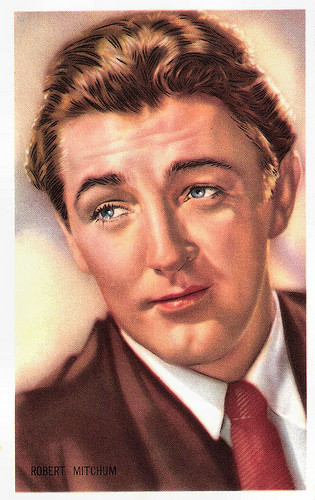
Belgian collectors card by Kwatta, Bois d'Haine, no. C 215. Photo: M.G.M. Publicity still for Desire Me (George Cukor, Jack Conway, 1947).
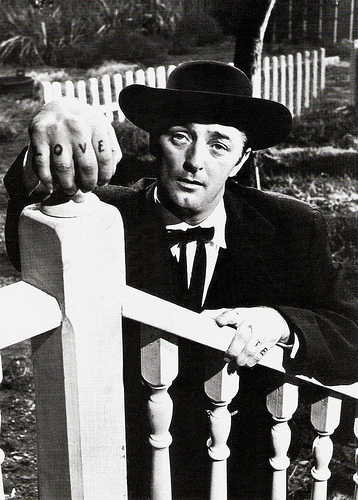
Italian programme card for Il Cinema Ritrovata 2003. Photo: publicity still for The Night of the Hunter (Charles Laughton, 1955).
A trouble-making, wayward boy
Robert Charles Durman Mitchum was born in 1917 in Bridgeport, Connecticut into a Methodist family. His parents were James Mitchum, a railroad worker of Irish descent, and Anne Mitchum, the daughter of a Norwegian ship captain. He had an elder sister, Annette (known as actress Julie Mitchum).
In 1919, James Mitchum was crushed to death in a railyard accident, when his son was less than two years old. Anne remarried to a former Royal Naval Reserve officer, Major Hugh Cunningham Morris. Robert grew up as a trouble-making, wayward boy and was sent to live with his grandparents when he was 12 years old. There he was expelled from his middle school for scuffling with a principal.
A year later, in 1930, he moved in with his older sister, in New York's Hell's Kitchen. After being expelled from Haaren High School, he left his sister and travelled throughout the country on railroad cars, taking a number of jobs including professional boxing. At age 14 in Savannah, Georgia, he was arrested for vagrancy and put on a local chain gang. By Mitchum's own account, he escaped and returned to his family in Delaware.
During this time, while recovering from injuries that nearly cost him a leg, he met the girl he would marry, Dorothy Spence. In 1936, he went back on the road, eventually riding the rails to California. In Long Beach, he worked as a ghost-writer for astrologer Carroll Righter.
His sister Julie convinced him to join the local theatre guild with her. In his years with the Players Guild of Long Beach, he made a living as a stagehand and occasional bit-player in company productions. He also wrote several short pieces which were performed by the guild. In 1940, he returned East to marry Dorothy Spence, taking her back to California. He remained a footloose character until the birth of their first child, James, nicknamed Josh (two more children followed, Chris and Petrine).
Mitchum then got a steady job as a machine operator with the Lockheed Aircraft Corporation. A nervous breakdown (which resulted in temporary blindness), apparently from job-related stress, led Mitchum to look for work as an actor or extra in films. An agent got him an interview with the producer of the series of B-Westerns starring William Boyd as flawless good guy Hopalong Cassidy. Mitchum's broad build, deep voice and insolent expression made him a perfect villain in several films in the series during 1942 and 1943.
He found further work as an extra and supporting actor in numerous productions for various studios. After playing a heroic co-pilot in Thirty Seconds Over Tokyo (Mervyn LeRoy 1943), Mitchum signed a seven-year contract with RKO Radio Pictures. He found himself groomed for B-Western stardom in a series of Zane Grey adaptations.
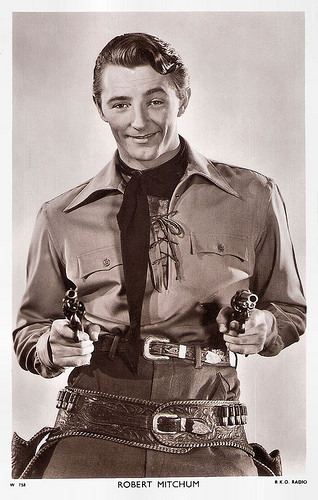
British postcard in the Picturegoer Series, London, no. W 758. Photo: R.K.O. Radio.
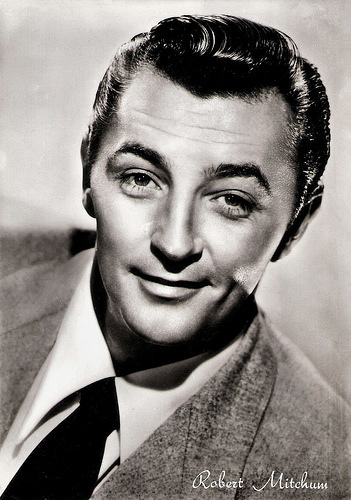
Italian postcard by Rotalfoto, Milano, no. 386.
Unique blend of strength, slow-burning sexuality and devil-may-care attitude
Following the moderately successful Western Nevada (Edward Killy, 1944), Robert Mitchum was lent from RKO to United Artists for The Story of G.I. Joe (William Wellman, 1945). In the film, he portrayed war-weary officer Bill Walker, who remains resolute despite the troubles he faces. The film, which followed the life of an ordinary soldier through the eyes of journalist Ernie Pyle (Burgess Meredith), became an instant critical and commercial success.
Shortly after making the film, Mitchum was drafted into the United States Army, serving at Fort MacArthur, California. At the 1946 Academy Awards, The Story of G.I. Joe was nominated for four Oscars, including Mitchum's only nomination for Best Supporting Actor. He finished the year off with the Western West of the Pecos (Edward Killy, 1945) and a story of returning Marine veterans, Till the End of Time (Edward Dmytryk, 1946).
The genre that came to define Mitchum's career and screen persona was Film Noir. His unique blend of strength, slow-burning sexuality and devil-may-care attitude helped to make him the personification of the Noir hero. His first foray into the genre was a supporting role opposite Kim Hunter in the B-movie When Strangers Marry (William Castle, 1944), as a woman's former lover who may or may not have killed her new husband.
Undercurrent (Vincente Minnelli, 1946) featured him playing against type as a troubled, sensitive man entangled in the affairs of his brother (Robert Taylor) and his brother's suspicious wife (Katharine Hepburn). The Locket (John Brahm, 1946) featured Mitchum as bitter ex-boyfriend to Laraine Day's femme fatale. Pursued (Raoul Walsh, 1947) combined Western and Noir styles, with Mitchum's character attempting to recall his past and find those responsible for killing his family.
Crossfire (Edward Dmytryk, 1947) featured Mitchum as a member of a group of soldiers, one of whom kills a Jewish man in an act of anti-Jewish hatred. It featured themes of anti-Semitism and the failings of military training. The film earned five Academy Award nominations.
Following Crossfire, Mitchum starred in Out of the Past (Jacques Tourneur, 1947). Mitchum played Jeff Markham, a small-town gas-station owner and former investigator, whose unfinished business with gambler Whit Sterling ( Kirk Douglas ) and femme fatale Kathie Moffett (Jane Greer), comes back to haunt him.
In 1948, after a string of successful films for RKO, Mitchum and actress Lila Leeds were arrested for possession of marijuana. The arrest was the result of a sting operation designed to capture other Hollywood partiers, as well, but Mitchum and Leeds did not receive the tip-off. After serving a week at the county jail, Mitchum spent 43 days at a Castaic, California, prison farm, with Life photographers right there taking photos of him mopping up in his prison uniform. The arrest became the inspiration for the exploitation film She Shoulda Said No! (Sam Newfield, 1949), which starred Leeds.
Mitchum claimed he was framed and in 1951 his case was overturned and his record cleared. However, the case enhanced his image as a rebel. The films released immediately after his arrest were box-office hits. The Western Rachel and the Stranger (Norman Foster, 1948) featured Mitchum in a supporting role as a mountain man competing for the hand of Loretta Young, the indentured servant and wife of William Holden, while he appeared in the film adaptation of John Steinbeck's novella The Red Pony (Lewis Milestone, 1949) as a trusted cowhand to a ranching family. He returned to true Film Noir in The Big Steal (Don Siegel, 1949), where he again joined Jane Greer.
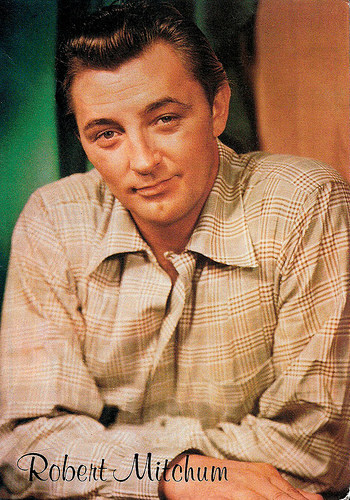
Italian postcard by Edizioni Beatrice D'Este, no. 20240. Photo: Ernest Bachrach, 1948.
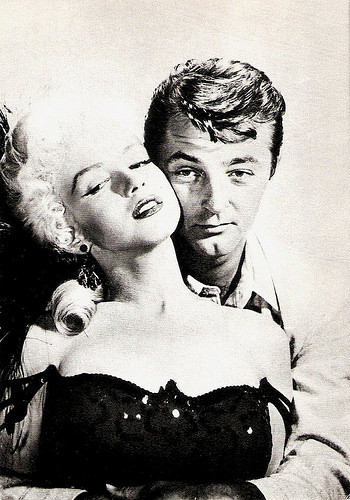
Vintage postcard. Photo: publicity still for River of No Return (Otto Preminger, 1954) with Marilyn Monroe .
The words Love and Hate tattooed on his hands
Robert Mitchum played a doctor who comes between a mentally unbalanced Faith Domergue and cuckolded millionaire Claude Rains in Where Danger Lives (John Farrow, 1950). The Racket (John Cromwell, Nicholas Ray, 1951) was a Noir remake of the early crime drama of the same name and featured Mitchum as a police captain fighting corruption in his precinct.
The Josef von Sternberg film Macao (1952) had Mitchum as a victim of mistaken identity at an exotic resort casino, playing opposite Jane Russell. They co-starred again in the steamy crime comedy-drama His Kind of Woman (John Farrow, 1952). Craig Butler at AllMovie : “Mitchum, by the way, is perfectly cast here, using his laconic, interior style to very good effect. Even Jane Russell, attired in outfits that emphasize her cleavage at every opportunity, turns in a more than decent performance. Woman is weird but wonderful.”
Otto Preminger's Angel Face (1953) was the first of three collaborations between Mitchum and British actress Jean Simmons , in which she plays an insane heiress who plans to use young ambulance driver Mitchum to kill for her. Mitchum was expelled from Blood Alley (1955), purportedly due to his conduct, especially his reportedly having thrown the film's transportation manager into San Francisco Bay. Producer John Wayne took over the role himself.
Following the Marilyn Monroe Western River of No Return (Otto Preminger, 1954), he appeared in Charles Laughton 's only film as director, The Night of the Hunter (1955). Adapted by James Agee from a novel by Davis Grubb, the thriller starred Mitchum as a terrifying killer who had the words Love and Hate tattooed on his hands and who poses as a preacher to find money hidden in his cellmate's home. Hal Erickson at AllMovie : “Combining stark realism with Germanic expressionism, the movie is a brilliant good-and-evil parable, with ‘good’ represented by a couple of farm kids and a pious old lady, and ‘evil’ literally in the hands of a posturing psychopath.” Mitchum’s performance as Reverend Harry Powell is considered by many to be one of the best of his career.
Stanley Kramer's melodrama Not as a Stranger (1955), was a box-office hit. The film starred Mitchum against type, as an idealistic young doctor, who marries an older nurse (Olivia de Havilland), only to question his morality many years later. However, the film was not well received, with most critics pointing out that Mitchum, Frank Sinatra, and Lee Marvin were all too old for their characters. Olivia de Havilland received top billing over Mitchum and Sinatra.
In 1955 Mitchum formed DRM (Dorothy and Robert Mitchum) Productions to produce five films for United Artists though only four films were produced. The first film was Bandido (Richard Fleischer, 1956). Following a succession of average Westerns and the poorly received Foreign Intrigue (Sheldon Reynolds, 1956), Mitchum starred in the first of three films with Deborah Kerr . The war drama Heaven Knows, Mr. Allison (John Huston, 1957), starred Mitchum as a Marine corporal shipwrecked on a Pacific Island with a nun, Sister Angela ( Deborah Kerr ), being his sole companion. In this character-study, they struggle to resist the elements and the invading Japanese army. The film was nominated for two Academy Awards, including Best Actress and Best Adapted Screenplay. For his role, Mitchum was nominated for a BAFTA Award for Best Foreign Actor.
In the WW II submarine classic The Enemy Below (Dick Powell, 1957), Mitchum gave a strong performance as U.S. Naval Lieutenant Commander Murrell, the captain of a U.S. Navy destroyer. He matches wits with a German U-boat captain Curd Jürgens , who starred with Mitchum again in The Longest Day (Ken Annakin, Andrew Marton, Bernhard Wicki, 1962).
Thunder Road (Arthur Ripley, 1958), the second DRM Production, was loosely based on an incident in which a driver transporting moonshine was said to have fatally crashed on Kingston Pike in Knoxville, Tennessee. Mitchum not only starred in the film, but also produced it, co-wrote the screenplay, and allegedly directed much of the film himself. He returned to Mexico for The Wonderful Country (Robert Parrish, 1959) and Ireland for A Terrible Beauty/The Night Fighters (Tay Garnett, 1960) for the last of his DRM Productions.
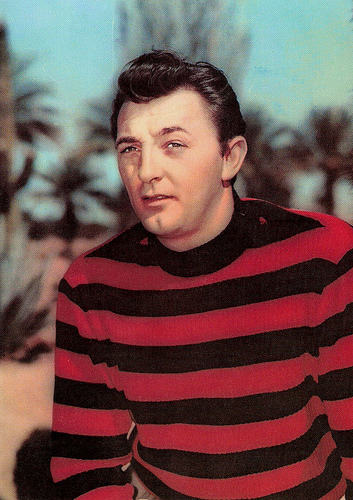
Italian postcard by Rotalfoto, Milano, no. N. 68.
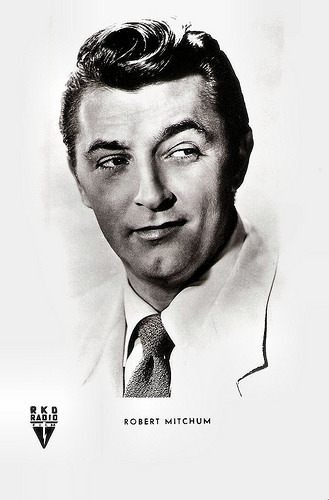
German postcard by Netter's Starverlag, Berlin. Photo: RKO Radio Film.
Menacingly vengeful rapist
Robert Mitchum and Deborah Kerr reunited for The Sundowners (Fred Zinnemann, 1960), where they played husband and wife struggling in Depression-era Australia. Opposite Mitchum, Kerr was nominated for yet another Academy Award for Best Actress, while the film was nominated for a total of five Oscars. Robert Mitchum was awarded that year's National Board of Review award for Best Actor for his performance. The award also recognised his superior performance in the Western drama Home from the Hill (Vincente Minnelli, 1960).
He was teamed with former leading ladies Kerr and Simmons, as well as Cary Grant, for the comedy The Grass Is Greener (Stanley Donen, 1960). Mitchum's performance as the menacingly vengeful rapist Max Cady who terrorises lawyer Gregory Peck and his family in Cape Fear (J. Lee Thompson, 1962) brought him even more attention and furthered his renown for playing cool, predatory characters.
The 1960s were marked by a number of lesser films and missed opportunities. Among the films Mitchum passed on during the decade were John Huston's The Misfits (1961), the Academy Award–winning Patton (Franklin J. Schaffner, 1970), and Dirty Harry (Don Siegel, 1971).
The most notable of his films in the decade included the war epics The Longest Day (Ken Annakin, Andrew Marton, Bernhard Wicki, 1962) and Anzio (Edward Dmytryk, 1968), the Shirley MacLaine comedy-musical What a Way to Go! (J. Lee Thompson, 1964), and the Western El Dorado (Howard Hawks, 1967), a remake of Rio Bravo (Howard Hawks, 1959), in which Mitchum took over Dean Martin's role of a drunken sheriff who helps John Wayne defend a town against unscrupulous cattlemen. He then teamed with Martin for the Western 5 Card Stud (Henry Hathaway, 1968), playing a homicidal preacher.
One of the lesser-known aspects of Mitchum's career was his forays into music, both as singer and composer. Mitchum's deep, commanding, yet lively voice was often used instead of that of a professional singer when his character sang in his films. After hearing traditional calypso music and meeting artists such as Mighty Sparrow and Lord Invader while filming Heaven Knows, Mr. Allison in the Caribbean islands of Tobago, he recorded Calypso — is like so ... in March 1957. A year later, he recorded a song he had written for Thunder Road, titled The Ballad of Thunder Road. The country-style song became a modest hit.
Although Mitchum continued to use his singing voice in his film work, he waited until 1967 to record his follow-up record, That Man, Robert Mitchum, Sings. Little Old Wine Drinker Me, the first single, was a top-10 hit at country radio, and crossed over onto mainstream radio, where it peaked at number 96. Its follow-up, You Deserve Each Other, also charted on the Billboard Country Singles chart. He also sang the title song to the Western Young Billy Young (Burt Kennedy, 1969).
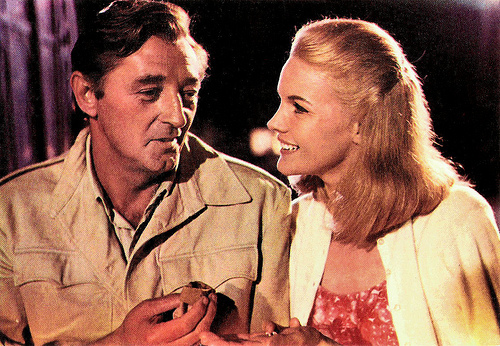
Italian postcard. Photo: DEAR Film. Publicity still for Mister Moses (Ronald Neame, 1965) with Carroll Baker .

French postcard by Editions P.I., Paris, no. FK 4568. Photo: Terb-Agency.
A low-rent Boston crook on the wrong end of the mob's attentions
Robert Mitchum seriously considered retiring from acting in 1968 due to concerns over the quality of his recent films. After a year's absence, during which he spent much of the time driving around America visiting old friends and staying in motels, he was lured back to star in Ryan's Daughter (David Lean, 1970). He made a departure from his typical screen persona with his role as Charles Shaughnessy, a mild-mannered schoolmaster in World War I-era Ireland. Though the film was nominated for four Academy Awards (winning two) and Mitchum was much publicised as a contender for a Best Actor nomination, he was not nominated. George C. Scott won the award for his performance in Patton.
The 1970s featured Mitchum in several well-received crime dramas. He was a low-rent Boston crook who finds himself on the wrong end of the mob's attentions in The Friends of Eddie Coyle (Peter Yates, 1973). He played a retired detective sent to Japan to rescue a client's daughter from gangsters in The Yakuza (Sydney Pollack, 1974), which transplanted the typical Film Noir story arc to the Japanese underworld.
He also appeared in Midway (Jack Smight, 1976) about an epic 1942 World War II battle, and opposite Robert De Niro in The Last Tycoon (Elia Kazan, 1976). Mitchum's stint as Raymond Chandler's noble private eye Philip Marlowe in Farewell, My Lovely (Dick Richards, 1975) was sufficiently well received by audiences and critics for him to reprise the role in The Big Sleep (Michael Winner, 1978).
His last interesting role in this late-career revival came with the film version of Jason Miller's play That Championship Season (Jason Miller, 1982), with Mitchum as the coach of a quartet of former high school basketball teammates who struggle to adjust to middle age and maturity.
He expanded to TV work with the big-budget miniseries The Winds of War (Dan Curtis, 1983) as navy man Victor ‘Pug’ Henry, whose family is deeply involved in the events leading up to America's involvement in the war. He also played George Hazard's father-in-law on the Civil War miniseries North and South (Richard T. Heffron, 1985). He followed it with the sequel War and Remembrance (Dan Curtis, 1988).
Mitchum replaced old friend John Huston in his son Danny's largely ignored comedy Mr. North (Danny Huston, 1988). He also was in Bill Murray's comedy film, Scrooged (Richard Donner, 1988). In 1991, Mitchum was given a lifetime achievement award from the National Board of Review of Motion Pictures and the Cecil B. DeMille Award from the Golden Globe Awards in 1992.
Mitchum continued to act in films until the mid-1990s. He appeared, in contrast to his role as the antagonist in the original, as a protagonist police detective in Martin Scorsese's remake of Cape Fear (1991). He also gave a lively performance as a robber baron of sorts who drives Johnny Depp's character into the wilderness in Jim Jarmusch's eccentric Western, Dead Man (1995). His last film appearance was a small but pivotal role in the television biopic, James Dean: Race with Destiny (Mardi Rustam, 1997), playing Giant director George Stevens opposite Casper Van Dien as James Dean. His last starring role was in the Norwegian film Pakten/Waiting for Sunset (Leidulv Risan, 1995) with Cliff Robertson and Erland Josephson.
A lifelong heavy smoker, Mitchum died in 1997, in Santa Barbara, California, due to complications of lung cancer and emphysema. Mitchum was 79. He was survived by his wife of 57 years, Dorothy Mitchum and actor sons, James Mitchum, Christopher Mitchum, and writer-daughter, Petrine Day Mitchum. His grandchildren, Bentley Mitchum and Carrie Mitchum, are actors, as was his younger brother, John, who died in 2001. His ashes were scattered by wife Dorothy and longtime friend Jane Russell.
Trailer The Big Steal (1949). Source: Movieclips Trailer Vault (YouTube).
Trailer The Night of the Hunter (1955). Source: Movieclips Trailer Vault (YouTube).
Trailer Cape Fear (1962). Source: Movieclips Trailer Vault (YouTube).
Trailer Farewell, My Lovely (1975). Source: robatsea2009 (YouTube).
Sources: Sandra Brennan (AllMovie), Hal Erickson (AllMovie), Craig Butler (AllMovie), (IMDb), William Bjornstad (Find A Grave), The New York Times, TCM, Wikipedia, and .

Belgian collectors card by Kwatta, Bois d'Haine, no. C 215. Photo: M.G.M. Publicity still for Desire Me (George Cukor, Jack Conway, 1947).

Italian programme card for Il Cinema Ritrovata 2003. Photo: publicity still for The Night of the Hunter (Charles Laughton, 1955).
A trouble-making, wayward boy
Robert Charles Durman Mitchum was born in 1917 in Bridgeport, Connecticut into a Methodist family. His parents were James Mitchum, a railroad worker of Irish descent, and Anne Mitchum, the daughter of a Norwegian ship captain. He had an elder sister, Annette (known as actress Julie Mitchum).
In 1919, James Mitchum was crushed to death in a railyard accident, when his son was less than two years old. Anne remarried to a former Royal Naval Reserve officer, Major Hugh Cunningham Morris. Robert grew up as a trouble-making, wayward boy and was sent to live with his grandparents when he was 12 years old. There he was expelled from his middle school for scuffling with a principal.
A year later, in 1930, he moved in with his older sister, in New York's Hell's Kitchen. After being expelled from Haaren High School, he left his sister and travelled throughout the country on railroad cars, taking a number of jobs including professional boxing. At age 14 in Savannah, Georgia, he was arrested for vagrancy and put on a local chain gang. By Mitchum's own account, he escaped and returned to his family in Delaware.
During this time, while recovering from injuries that nearly cost him a leg, he met the girl he would marry, Dorothy Spence. In 1936, he went back on the road, eventually riding the rails to California. In Long Beach, he worked as a ghost-writer for astrologer Carroll Righter.
His sister Julie convinced him to join the local theatre guild with her. In his years with the Players Guild of Long Beach, he made a living as a stagehand and occasional bit-player in company productions. He also wrote several short pieces which were performed by the guild. In 1940, he returned East to marry Dorothy Spence, taking her back to California. He remained a footloose character until the birth of their first child, James, nicknamed Josh (two more children followed, Chris and Petrine).
Mitchum then got a steady job as a machine operator with the Lockheed Aircraft Corporation. A nervous breakdown (which resulted in temporary blindness), apparently from job-related stress, led Mitchum to look for work as an actor or extra in films. An agent got him an interview with the producer of the series of B-Westerns starring William Boyd as flawless good guy Hopalong Cassidy. Mitchum's broad build, deep voice and insolent expression made him a perfect villain in several films in the series during 1942 and 1943.
He found further work as an extra and supporting actor in numerous productions for various studios. After playing a heroic co-pilot in Thirty Seconds Over Tokyo (Mervyn LeRoy 1943), Mitchum signed a seven-year contract with RKO Radio Pictures. He found himself groomed for B-Western stardom in a series of Zane Grey adaptations.

British postcard in the Picturegoer Series, London, no. W 758. Photo: R.K.O. Radio.

Italian postcard by Rotalfoto, Milano, no. 386.
Unique blend of strength, slow-burning sexuality and devil-may-care attitude
Following the moderately successful Western Nevada (Edward Killy, 1944), Robert Mitchum was lent from RKO to United Artists for The Story of G.I. Joe (William Wellman, 1945). In the film, he portrayed war-weary officer Bill Walker, who remains resolute despite the troubles he faces. The film, which followed the life of an ordinary soldier through the eyes of journalist Ernie Pyle (Burgess Meredith), became an instant critical and commercial success.
Shortly after making the film, Mitchum was drafted into the United States Army, serving at Fort MacArthur, California. At the 1946 Academy Awards, The Story of G.I. Joe was nominated for four Oscars, including Mitchum's only nomination for Best Supporting Actor. He finished the year off with the Western West of the Pecos (Edward Killy, 1945) and a story of returning Marine veterans, Till the End of Time (Edward Dmytryk, 1946).
The genre that came to define Mitchum's career and screen persona was Film Noir. His unique blend of strength, slow-burning sexuality and devil-may-care attitude helped to make him the personification of the Noir hero. His first foray into the genre was a supporting role opposite Kim Hunter in the B-movie When Strangers Marry (William Castle, 1944), as a woman's former lover who may or may not have killed her new husband.
Undercurrent (Vincente Minnelli, 1946) featured him playing against type as a troubled, sensitive man entangled in the affairs of his brother (Robert Taylor) and his brother's suspicious wife (Katharine Hepburn). The Locket (John Brahm, 1946) featured Mitchum as bitter ex-boyfriend to Laraine Day's femme fatale. Pursued (Raoul Walsh, 1947) combined Western and Noir styles, with Mitchum's character attempting to recall his past and find those responsible for killing his family.
Crossfire (Edward Dmytryk, 1947) featured Mitchum as a member of a group of soldiers, one of whom kills a Jewish man in an act of anti-Jewish hatred. It featured themes of anti-Semitism and the failings of military training. The film earned five Academy Award nominations.
Following Crossfire, Mitchum starred in Out of the Past (Jacques Tourneur, 1947). Mitchum played Jeff Markham, a small-town gas-station owner and former investigator, whose unfinished business with gambler Whit Sterling ( Kirk Douglas ) and femme fatale Kathie Moffett (Jane Greer), comes back to haunt him.
In 1948, after a string of successful films for RKO, Mitchum and actress Lila Leeds were arrested for possession of marijuana. The arrest was the result of a sting operation designed to capture other Hollywood partiers, as well, but Mitchum and Leeds did not receive the tip-off. After serving a week at the county jail, Mitchum spent 43 days at a Castaic, California, prison farm, with Life photographers right there taking photos of him mopping up in his prison uniform. The arrest became the inspiration for the exploitation film She Shoulda Said No! (Sam Newfield, 1949), which starred Leeds.
Mitchum claimed he was framed and in 1951 his case was overturned and his record cleared. However, the case enhanced his image as a rebel. The films released immediately after his arrest were box-office hits. The Western Rachel and the Stranger (Norman Foster, 1948) featured Mitchum in a supporting role as a mountain man competing for the hand of Loretta Young, the indentured servant and wife of William Holden, while he appeared in the film adaptation of John Steinbeck's novella The Red Pony (Lewis Milestone, 1949) as a trusted cowhand to a ranching family. He returned to true Film Noir in The Big Steal (Don Siegel, 1949), where he again joined Jane Greer.

Italian postcard by Edizioni Beatrice D'Este, no. 20240. Photo: Ernest Bachrach, 1948.

Vintage postcard. Photo: publicity still for River of No Return (Otto Preminger, 1954) with Marilyn Monroe .
The words Love and Hate tattooed on his hands
Robert Mitchum played a doctor who comes between a mentally unbalanced Faith Domergue and cuckolded millionaire Claude Rains in Where Danger Lives (John Farrow, 1950). The Racket (John Cromwell, Nicholas Ray, 1951) was a Noir remake of the early crime drama of the same name and featured Mitchum as a police captain fighting corruption in his precinct.
The Josef von Sternberg film Macao (1952) had Mitchum as a victim of mistaken identity at an exotic resort casino, playing opposite Jane Russell. They co-starred again in the steamy crime comedy-drama His Kind of Woman (John Farrow, 1952). Craig Butler at AllMovie : “Mitchum, by the way, is perfectly cast here, using his laconic, interior style to very good effect. Even Jane Russell, attired in outfits that emphasize her cleavage at every opportunity, turns in a more than decent performance. Woman is weird but wonderful.”
Otto Preminger's Angel Face (1953) was the first of three collaborations between Mitchum and British actress Jean Simmons , in which she plays an insane heiress who plans to use young ambulance driver Mitchum to kill for her. Mitchum was expelled from Blood Alley (1955), purportedly due to his conduct, especially his reportedly having thrown the film's transportation manager into San Francisco Bay. Producer John Wayne took over the role himself.
Following the Marilyn Monroe Western River of No Return (Otto Preminger, 1954), he appeared in Charles Laughton 's only film as director, The Night of the Hunter (1955). Adapted by James Agee from a novel by Davis Grubb, the thriller starred Mitchum as a terrifying killer who had the words Love and Hate tattooed on his hands and who poses as a preacher to find money hidden in his cellmate's home. Hal Erickson at AllMovie : “Combining stark realism with Germanic expressionism, the movie is a brilliant good-and-evil parable, with ‘good’ represented by a couple of farm kids and a pious old lady, and ‘evil’ literally in the hands of a posturing psychopath.” Mitchum’s performance as Reverend Harry Powell is considered by many to be one of the best of his career.
Stanley Kramer's melodrama Not as a Stranger (1955), was a box-office hit. The film starred Mitchum against type, as an idealistic young doctor, who marries an older nurse (Olivia de Havilland), only to question his morality many years later. However, the film was not well received, with most critics pointing out that Mitchum, Frank Sinatra, and Lee Marvin were all too old for their characters. Olivia de Havilland received top billing over Mitchum and Sinatra.
In 1955 Mitchum formed DRM (Dorothy and Robert Mitchum) Productions to produce five films for United Artists though only four films were produced. The first film was Bandido (Richard Fleischer, 1956). Following a succession of average Westerns and the poorly received Foreign Intrigue (Sheldon Reynolds, 1956), Mitchum starred in the first of three films with Deborah Kerr . The war drama Heaven Knows, Mr. Allison (John Huston, 1957), starred Mitchum as a Marine corporal shipwrecked on a Pacific Island with a nun, Sister Angela ( Deborah Kerr ), being his sole companion. In this character-study, they struggle to resist the elements and the invading Japanese army. The film was nominated for two Academy Awards, including Best Actress and Best Adapted Screenplay. For his role, Mitchum was nominated for a BAFTA Award for Best Foreign Actor.
In the WW II submarine classic The Enemy Below (Dick Powell, 1957), Mitchum gave a strong performance as U.S. Naval Lieutenant Commander Murrell, the captain of a U.S. Navy destroyer. He matches wits with a German U-boat captain Curd Jürgens , who starred with Mitchum again in The Longest Day (Ken Annakin, Andrew Marton, Bernhard Wicki, 1962).
Thunder Road (Arthur Ripley, 1958), the second DRM Production, was loosely based on an incident in which a driver transporting moonshine was said to have fatally crashed on Kingston Pike in Knoxville, Tennessee. Mitchum not only starred in the film, but also produced it, co-wrote the screenplay, and allegedly directed much of the film himself. He returned to Mexico for The Wonderful Country (Robert Parrish, 1959) and Ireland for A Terrible Beauty/The Night Fighters (Tay Garnett, 1960) for the last of his DRM Productions.

Italian postcard by Rotalfoto, Milano, no. N. 68.

German postcard by Netter's Starverlag, Berlin. Photo: RKO Radio Film.
Menacingly vengeful rapist
Robert Mitchum and Deborah Kerr reunited for The Sundowners (Fred Zinnemann, 1960), where they played husband and wife struggling in Depression-era Australia. Opposite Mitchum, Kerr was nominated for yet another Academy Award for Best Actress, while the film was nominated for a total of five Oscars. Robert Mitchum was awarded that year's National Board of Review award for Best Actor for his performance. The award also recognised his superior performance in the Western drama Home from the Hill (Vincente Minnelli, 1960).
He was teamed with former leading ladies Kerr and Simmons, as well as Cary Grant, for the comedy The Grass Is Greener (Stanley Donen, 1960). Mitchum's performance as the menacingly vengeful rapist Max Cady who terrorises lawyer Gregory Peck and his family in Cape Fear (J. Lee Thompson, 1962) brought him even more attention and furthered his renown for playing cool, predatory characters.
The 1960s were marked by a number of lesser films and missed opportunities. Among the films Mitchum passed on during the decade were John Huston's The Misfits (1961), the Academy Award–winning Patton (Franklin J. Schaffner, 1970), and Dirty Harry (Don Siegel, 1971).
The most notable of his films in the decade included the war epics The Longest Day (Ken Annakin, Andrew Marton, Bernhard Wicki, 1962) and Anzio (Edward Dmytryk, 1968), the Shirley MacLaine comedy-musical What a Way to Go! (J. Lee Thompson, 1964), and the Western El Dorado (Howard Hawks, 1967), a remake of Rio Bravo (Howard Hawks, 1959), in which Mitchum took over Dean Martin's role of a drunken sheriff who helps John Wayne defend a town against unscrupulous cattlemen. He then teamed with Martin for the Western 5 Card Stud (Henry Hathaway, 1968), playing a homicidal preacher.
One of the lesser-known aspects of Mitchum's career was his forays into music, both as singer and composer. Mitchum's deep, commanding, yet lively voice was often used instead of that of a professional singer when his character sang in his films. After hearing traditional calypso music and meeting artists such as Mighty Sparrow and Lord Invader while filming Heaven Knows, Mr. Allison in the Caribbean islands of Tobago, he recorded Calypso — is like so ... in March 1957. A year later, he recorded a song he had written for Thunder Road, titled The Ballad of Thunder Road. The country-style song became a modest hit.
Although Mitchum continued to use his singing voice in his film work, he waited until 1967 to record his follow-up record, That Man, Robert Mitchum, Sings. Little Old Wine Drinker Me, the first single, was a top-10 hit at country radio, and crossed over onto mainstream radio, where it peaked at number 96. Its follow-up, You Deserve Each Other, also charted on the Billboard Country Singles chart. He also sang the title song to the Western Young Billy Young (Burt Kennedy, 1969).

Italian postcard. Photo: DEAR Film. Publicity still for Mister Moses (Ronald Neame, 1965) with Carroll Baker .

French postcard by Editions P.I., Paris, no. FK 4568. Photo: Terb-Agency.
A low-rent Boston crook on the wrong end of the mob's attentions
Robert Mitchum seriously considered retiring from acting in 1968 due to concerns over the quality of his recent films. After a year's absence, during which he spent much of the time driving around America visiting old friends and staying in motels, he was lured back to star in Ryan's Daughter (David Lean, 1970). He made a departure from his typical screen persona with his role as Charles Shaughnessy, a mild-mannered schoolmaster in World War I-era Ireland. Though the film was nominated for four Academy Awards (winning two) and Mitchum was much publicised as a contender for a Best Actor nomination, he was not nominated. George C. Scott won the award for his performance in Patton.
The 1970s featured Mitchum in several well-received crime dramas. He was a low-rent Boston crook who finds himself on the wrong end of the mob's attentions in The Friends of Eddie Coyle (Peter Yates, 1973). He played a retired detective sent to Japan to rescue a client's daughter from gangsters in The Yakuza (Sydney Pollack, 1974), which transplanted the typical Film Noir story arc to the Japanese underworld.
He also appeared in Midway (Jack Smight, 1976) about an epic 1942 World War II battle, and opposite Robert De Niro in The Last Tycoon (Elia Kazan, 1976). Mitchum's stint as Raymond Chandler's noble private eye Philip Marlowe in Farewell, My Lovely (Dick Richards, 1975) was sufficiently well received by audiences and critics for him to reprise the role in The Big Sleep (Michael Winner, 1978).
His last interesting role in this late-career revival came with the film version of Jason Miller's play That Championship Season (Jason Miller, 1982), with Mitchum as the coach of a quartet of former high school basketball teammates who struggle to adjust to middle age and maturity.
He expanded to TV work with the big-budget miniseries The Winds of War (Dan Curtis, 1983) as navy man Victor ‘Pug’ Henry, whose family is deeply involved in the events leading up to America's involvement in the war. He also played George Hazard's father-in-law on the Civil War miniseries North and South (Richard T. Heffron, 1985). He followed it with the sequel War and Remembrance (Dan Curtis, 1988).
Mitchum replaced old friend John Huston in his son Danny's largely ignored comedy Mr. North (Danny Huston, 1988). He also was in Bill Murray's comedy film, Scrooged (Richard Donner, 1988). In 1991, Mitchum was given a lifetime achievement award from the National Board of Review of Motion Pictures and the Cecil B. DeMille Award from the Golden Globe Awards in 1992.
Mitchum continued to act in films until the mid-1990s. He appeared, in contrast to his role as the antagonist in the original, as a protagonist police detective in Martin Scorsese's remake of Cape Fear (1991). He also gave a lively performance as a robber baron of sorts who drives Johnny Depp's character into the wilderness in Jim Jarmusch's eccentric Western, Dead Man (1995). His last film appearance was a small but pivotal role in the television biopic, James Dean: Race with Destiny (Mardi Rustam, 1997), playing Giant director George Stevens opposite Casper Van Dien as James Dean. His last starring role was in the Norwegian film Pakten/Waiting for Sunset (Leidulv Risan, 1995) with Cliff Robertson and Erland Josephson.
A lifelong heavy smoker, Mitchum died in 1997, in Santa Barbara, California, due to complications of lung cancer and emphysema. Mitchum was 79. He was survived by his wife of 57 years, Dorothy Mitchum and actor sons, James Mitchum, Christopher Mitchum, and writer-daughter, Petrine Day Mitchum. His grandchildren, Bentley Mitchum and Carrie Mitchum, are actors, as was his younger brother, John, who died in 2001. His ashes were scattered by wife Dorothy and longtime friend Jane Russell.
Trailer The Big Steal (1949). Source: Movieclips Trailer Vault (YouTube).
Trailer The Night of the Hunter (1955). Source: Movieclips Trailer Vault (YouTube).
Trailer Cape Fear (1962). Source: Movieclips Trailer Vault (YouTube).
Trailer Farewell, My Lovely (1975). Source: robatsea2009 (YouTube).
Sources: Sandra Brennan (AllMovie), Hal Erickson (AllMovie), Craig Butler (AllMovie), (IMDb), William Bjornstad (Find A Grave), The New York Times, TCM, Wikipedia, and .
Published on June 25, 2017 22:00
June 24, 2017
Louise Brooks
Legendary dancer and film actress Louise Brooks (1906-1985) set the trend of the bobbed haircut and personified the 'flapper', the rebellious young woman of the 1920s. Brooks played the lead in three European silent film classics: Die Büchse der Pandora/Pandora's Box (1929), Tagebuch einer Verlorenen/Diary of a Lost Girl (1929), and Prix de Beauté/Miss Europe (1930). The third film was directed by Augusto Genina, one of the most cosmopolitan directors of Italian film history. At
Il Cinema Ritrovato
, the programme Augusto Genina: an Italian in Europe is dedicated to him. Genina's work in cinema began in the early 1910s, and he worked in both France and Germany - often creating portraits of mischievous women...

German postcard by Ross Verlag, no. 4252/1, 1929-1930. Photo: Alex Binder, Berlin.
Paramount
Mary Louise Brooks was born in the Midwestern town of Cherryvale, Kansas, in 1906. She was the daughter of Leonard Porter Brooks, a lawyer, who was usually too busy with his practice to discipline his children, and Myra Rude. Rude was a talented pianist who played the latest Debussy and Ravel for her children, inspiring them with a love of books and music.
None of this protected her nine-year old daughter Louise from sexual abuse at the hands of a neighbourhood predator. This event had a major influence on Brooks' life and career.
Brooks began her entertainment career as a dancer, joining the Denishawn modern dance company in Los Angeles (whose members included Ruth St. Denis, Ted Shawn and Martha Graham) in 1922. St. Denis abruptly fired Brooks from the troupe in 1924.
Brooks became a chorus girl in George White's Scandals, followed by an appearance as a featured dancer in the 1925 edition of the Ziegfeld Follies on Broadway.
As a result of her work in the Follies, she came to the attention of Paramount Pictures producer Walter Wanger, who signed her to a five-year contract with the studio in 1925. Brooks made her screen debut in an uncredited role in the silent The Street of Forgotten Men (Herbert Brenon, 1925).
Over the next few years, she played the female lead in silent light comedies and flapper films, like It's the Old Army Game (Eddie Sutherland, 1926) opposite W. C. Fields.
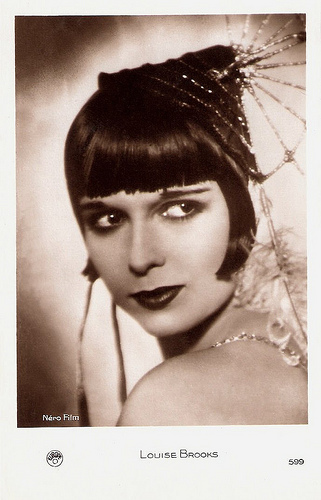
French postcard by Europe, no. 599. Photo: Néro Film.
Haunting, Provocative Performances
Louise Brooks was noticed in Europe for her pivotal vamp role in the buddy film A Girl in Every Port (Howard Hawks, 1928). That year, she also made the early sound film drama Beggars of Life (William Wellman, 1928). Brooks played an abused country girl on the run who meets two hoboes (Richard Arlen and Wallace Beery).
By this time in her life, she was mixing with the rich and famous, and was a regular guest of William Randolph Hearst and his mistress, Marion Davies, at San Simeon. Her distinctive bob haircut helped start a trend; many women styled their hair in imitation of her and fellow film star Colleen Moore.
Soon after Beggars Of Life, Brooks refused to stay on at Paramount after being denied a promised raise. She left for Europe to make films for G. W. Pabst, the prominent Austrian Expressionist director. In Germany, she starred as Lulu in Die Büchse der Pandora/Pandora's Box (Georg Wilhelm Pabst, 1929). The film is based on two plays by Frank Wedekind (Erdgeist and Die Büchse der Pandora) and Brooks plays the central figure. This film is notable for its frank treatment of modern sexual mores, including one of the first screen portrayals of a lesbian.
Brooks then starred in Pabst’s controversial social drama Tagebuch einer Verlorenen/Diary of a Lost Girl (Georg Wilhelm Pabst, 1929), based on the book by Margarete Böhme. In France she filmed Prix de Beauté/Miss Europe (Augusto Genina, 1930).
Hal Erickson at AllMovie : “Her haunting, provocative performances in Pabst's Pandora's Box (1928) and Diary of a Lost Girl (1929) not only established her as a screen personality of the first rank, but also fostered a Louise Brooks ‘cult’ which continued to flourish. (...) Not as highly regarded as Louise Brooks' German films for G. W. Pabst, Prix de Beauté nonetheless succeeds in terms of visual dynamics and the naturalness of the star's performance.”
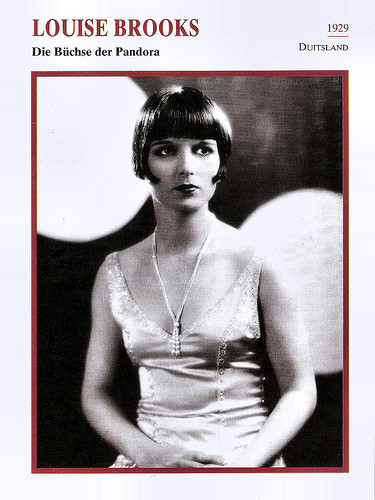
Dutch collectors card in the series 'Filmsterren: een portret' by Edito Service, 1995. Photo: Stars-Films. Publicity still for Die Büchse der Pandora/Pandora's Box (G.W. Pabst, 1929).
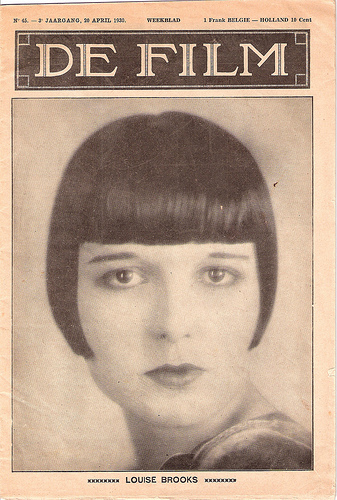
Cover of De Film, 20 April 1930. De Film was a Belgium film magazine.
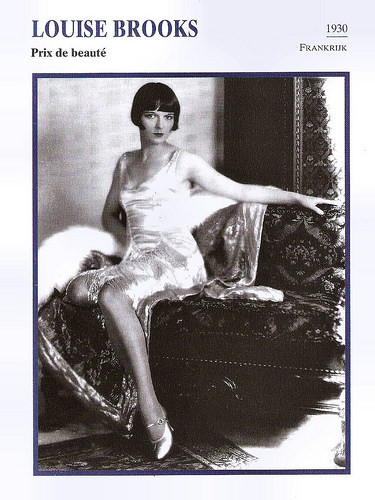
Dutch collectors card in the series 'Filmsterren: een portret' by Edito Service, 1995. Photo: Stars-Films. Publicity still for Prix de Beauté (Augusto Genina, 1930).
Lulu in Hollywood
When Louise Brooks returned to Hollywood in 1931, she was cast in two mainstream films: God's Gift to Women (Michael Curtiz, 1931) and It Pays to Advertise (Frank Tuttle, 1931). Her performances in these films, however, were largely ignored, and few other job offers were forthcoming. She turned down the female lead opposite James Cagney in Public Enemy (William Wellman, 1931) which marked the end of her film career.
Furthermore she was only cast in bit parts and roles in B pictures and short films. At 32, Brooks retired from the screen after completing one last film, the John Wayne western Overland Stage Raiders (George Sherman, 1938). She then briefly returned to Wichita, where she was raised. After an unsuccessful attempt at operating a dance studio, she returned East and, after brief stints as a radio actor and a gossip columnist, worked as a salesgirl in a Saks Fifth Avenue store in New York City for a few years, then eked out a living as a courtesan with a few select wealthy men as clients.
In the early 1950s French film historians rediscovered her films, proclaiming her as an actress who surpassed even Marlene Dietrich and Greta Garbo as a film icon, much to her amusement. It rehabilitated her reputation in the US. With the help of James Card, film curator for the George Eastman House, she became a writer of well-researched and well-balanced articles on film history. She published her witty, extremely candid autobiography, Lulu in Hollywood, in 1982.
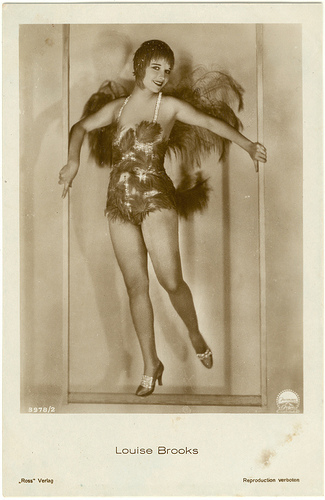
German postcard by Ross Verlag, no. 3978/2, 1928-1929. Photo: Paramount. Publicity still for The Canary Murder Case (Malcolm St. Clair, 1929). Collection: Rescued by Rover@Flickr.
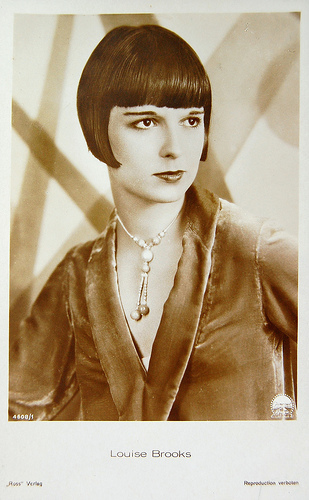
German postcard by Ross Verlag, no. 4608/1, 1929-1930. Photo: Paramount. Collection: Anni Raasu (Shme@Flickr).
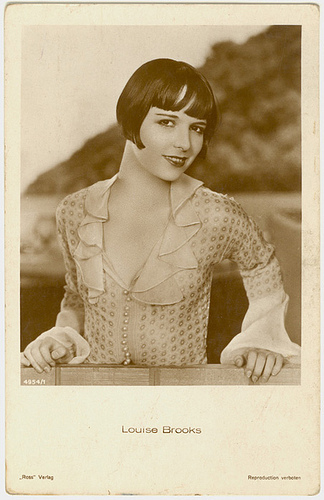
German postcard by Ross Verlag, no. 4954/1, 1929-1930. Collection: Rescued by Rover@Flickr.
Speculation
Louise Brooks was married twice. In 1926, she had married director Eddie Sutherland, but they divorced in 1928 because of her relationship with George Preston Marshall, owner of a chain of laundries and future owner of the Washington Redskins football team.
In 1933, she married Chicago millionaire Deering Davis, but abruptly left him after only five months of marriage. The couple officially divorced in 1938.
Brooks enjoyed fostering speculation about her sexuality, cultivating friendships with lesbian and bisexual women, but eschewing relationships.
In 1985, Louise Brooks was found dead of a heart attack in her home in Rochester. She was 78 years old, and had appeared in only 25 films.
Scene from Die Büchse der Pandora/Pandora's Box (1929). Lulu dances with Countess Augusta Geschwitz (Alice Roberts), one of cinema's earliest representations of lesbian desire. Source: ButchInProgress (YouTube).
Scene from Prix de Beauté/Miss Europe (1930). Source: Mark Satchwell (YouTube).
Sources: Hal Erickson (AllMovie), (IMDb), Wikipedia, and .

German postcard by Ross Verlag, no. 4252/1, 1929-1930. Photo: Alex Binder, Berlin.
Paramount
Mary Louise Brooks was born in the Midwestern town of Cherryvale, Kansas, in 1906. She was the daughter of Leonard Porter Brooks, a lawyer, who was usually too busy with his practice to discipline his children, and Myra Rude. Rude was a talented pianist who played the latest Debussy and Ravel for her children, inspiring them with a love of books and music.
None of this protected her nine-year old daughter Louise from sexual abuse at the hands of a neighbourhood predator. This event had a major influence on Brooks' life and career.
Brooks began her entertainment career as a dancer, joining the Denishawn modern dance company in Los Angeles (whose members included Ruth St. Denis, Ted Shawn and Martha Graham) in 1922. St. Denis abruptly fired Brooks from the troupe in 1924.
Brooks became a chorus girl in George White's Scandals, followed by an appearance as a featured dancer in the 1925 edition of the Ziegfeld Follies on Broadway.
As a result of her work in the Follies, she came to the attention of Paramount Pictures producer Walter Wanger, who signed her to a five-year contract with the studio in 1925. Brooks made her screen debut in an uncredited role in the silent The Street of Forgotten Men (Herbert Brenon, 1925).
Over the next few years, she played the female lead in silent light comedies and flapper films, like It's the Old Army Game (Eddie Sutherland, 1926) opposite W. C. Fields.

French postcard by Europe, no. 599. Photo: Néro Film.
Haunting, Provocative Performances
Louise Brooks was noticed in Europe for her pivotal vamp role in the buddy film A Girl in Every Port (Howard Hawks, 1928). That year, she also made the early sound film drama Beggars of Life (William Wellman, 1928). Brooks played an abused country girl on the run who meets two hoboes (Richard Arlen and Wallace Beery).
By this time in her life, she was mixing with the rich and famous, and was a regular guest of William Randolph Hearst and his mistress, Marion Davies, at San Simeon. Her distinctive bob haircut helped start a trend; many women styled their hair in imitation of her and fellow film star Colleen Moore.
Soon after Beggars Of Life, Brooks refused to stay on at Paramount after being denied a promised raise. She left for Europe to make films for G. W. Pabst, the prominent Austrian Expressionist director. In Germany, she starred as Lulu in Die Büchse der Pandora/Pandora's Box (Georg Wilhelm Pabst, 1929). The film is based on two plays by Frank Wedekind (Erdgeist and Die Büchse der Pandora) and Brooks plays the central figure. This film is notable for its frank treatment of modern sexual mores, including one of the first screen portrayals of a lesbian.
Brooks then starred in Pabst’s controversial social drama Tagebuch einer Verlorenen/Diary of a Lost Girl (Georg Wilhelm Pabst, 1929), based on the book by Margarete Böhme. In France she filmed Prix de Beauté/Miss Europe (Augusto Genina, 1930).
Hal Erickson at AllMovie : “Her haunting, provocative performances in Pabst's Pandora's Box (1928) and Diary of a Lost Girl (1929) not only established her as a screen personality of the first rank, but also fostered a Louise Brooks ‘cult’ which continued to flourish. (...) Not as highly regarded as Louise Brooks' German films for G. W. Pabst, Prix de Beauté nonetheless succeeds in terms of visual dynamics and the naturalness of the star's performance.”

Dutch collectors card in the series 'Filmsterren: een portret' by Edito Service, 1995. Photo: Stars-Films. Publicity still for Die Büchse der Pandora/Pandora's Box (G.W. Pabst, 1929).

Cover of De Film, 20 April 1930. De Film was a Belgium film magazine.

Dutch collectors card in the series 'Filmsterren: een portret' by Edito Service, 1995. Photo: Stars-Films. Publicity still for Prix de Beauté (Augusto Genina, 1930).
Lulu in Hollywood
When Louise Brooks returned to Hollywood in 1931, she was cast in two mainstream films: God's Gift to Women (Michael Curtiz, 1931) and It Pays to Advertise (Frank Tuttle, 1931). Her performances in these films, however, were largely ignored, and few other job offers were forthcoming. She turned down the female lead opposite James Cagney in Public Enemy (William Wellman, 1931) which marked the end of her film career.
Furthermore she was only cast in bit parts and roles in B pictures and short films. At 32, Brooks retired from the screen after completing one last film, the John Wayne western Overland Stage Raiders (George Sherman, 1938). She then briefly returned to Wichita, where she was raised. After an unsuccessful attempt at operating a dance studio, she returned East and, after brief stints as a radio actor and a gossip columnist, worked as a salesgirl in a Saks Fifth Avenue store in New York City for a few years, then eked out a living as a courtesan with a few select wealthy men as clients.
In the early 1950s French film historians rediscovered her films, proclaiming her as an actress who surpassed even Marlene Dietrich and Greta Garbo as a film icon, much to her amusement. It rehabilitated her reputation in the US. With the help of James Card, film curator for the George Eastman House, she became a writer of well-researched and well-balanced articles on film history. She published her witty, extremely candid autobiography, Lulu in Hollywood, in 1982.

German postcard by Ross Verlag, no. 3978/2, 1928-1929. Photo: Paramount. Publicity still for The Canary Murder Case (Malcolm St. Clair, 1929). Collection: Rescued by Rover@Flickr.

German postcard by Ross Verlag, no. 4608/1, 1929-1930. Photo: Paramount. Collection: Anni Raasu (Shme@Flickr).

German postcard by Ross Verlag, no. 4954/1, 1929-1930. Collection: Rescued by Rover@Flickr.
Speculation
Louise Brooks was married twice. In 1926, she had married director Eddie Sutherland, but they divorced in 1928 because of her relationship with George Preston Marshall, owner of a chain of laundries and future owner of the Washington Redskins football team.
In 1933, she married Chicago millionaire Deering Davis, but abruptly left him after only five months of marriage. The couple officially divorced in 1938.
Brooks enjoyed fostering speculation about her sexuality, cultivating friendships with lesbian and bisexual women, but eschewing relationships.
In 1985, Louise Brooks was found dead of a heart attack in her home in Rochester. She was 78 years old, and had appeared in only 25 films.
Scene from Die Büchse der Pandora/Pandora's Box (1929). Lulu dances with Countess Augusta Geschwitz (Alice Roberts), one of cinema's earliest representations of lesbian desire. Source: ButchInProgress (YouTube).
Scene from Prix de Beauté/Miss Europe (1930). Source: Mark Satchwell (YouTube).
Sources: Hal Erickson (AllMovie), (IMDb), Wikipedia, and .
Published on June 24, 2017 22:00
June 23, 2017
A hundred years ago: 12 film star postcards of 1917
Bon giorno! We're in Bologna at Il Cinema Ritrovato. Till 2 July, all EFSP posts will highlight festival sections and today we start with the section A hundred years ago: 50 films of 1917. It contains some fifty films, documentaries, fragments and animation films, including such masterful works like Yakov Protazanov’s Ne nado krovi/Blood Need Not Be Spilled, starring Ivan Mozzhukhin, amazing actresses like Maria Orska, Pola Negri and Pauline Starke and popular idols like Gunnar Tolnæs. Some of the 12 postcards in this post were also used for the catalogue of Il Cinema Ritrovato 2017.
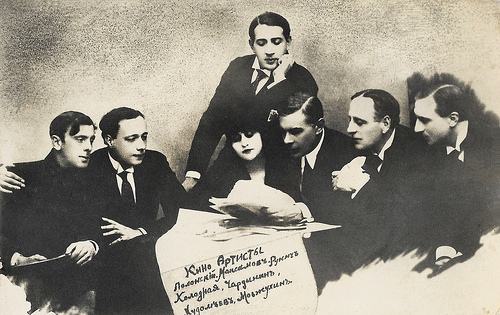
The Russian film scene, ca. 1917. From left to right: Vitold Polonsky , Vladimir Maksimov , Vera Kholodnaya, Ossip Runitsch (in the back), Petr Cardynin, Ivan Khudoleyev, and Ivan Mozzhukin . Russian postcard. Collection: Didier Hanson.
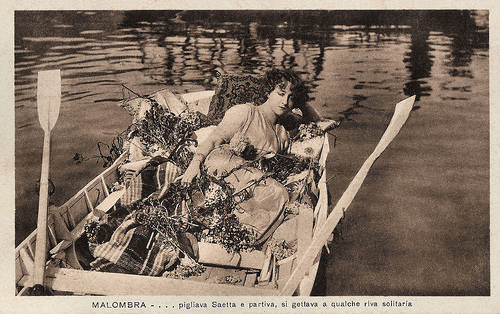
Italian postcard for the silent film Malombra (Carmine Gallone, 1917), adapted from the novel by Antonio Fogazzaro, and starring Lyda Borelli . Caption: "...Saetta seized [the oars] and left, moving towards some solitary shore."
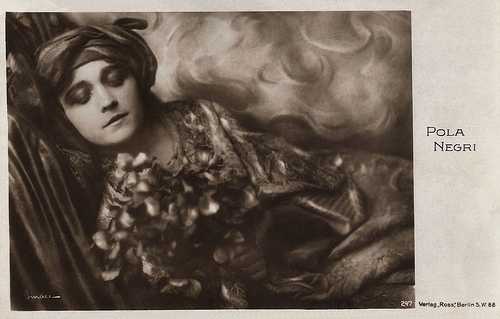
Pola Negri , ca. 1919. German postcard by Ross Verlag, no. 247. Photo: Alex Binder. Negri stars in the Polish film Bestia/The Polish Dancer (Aleksander Hertz, 1917).
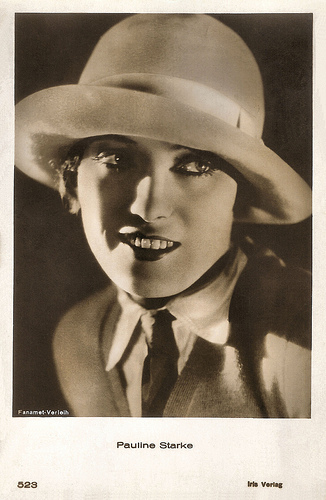
Pauline Starke. Austrian postcard by Iris Verlag, no. 523. Photo: Fanamet Verleih. At Bologna, Starke can be seen in Until They Get Me (Frank Borzage, 1917).
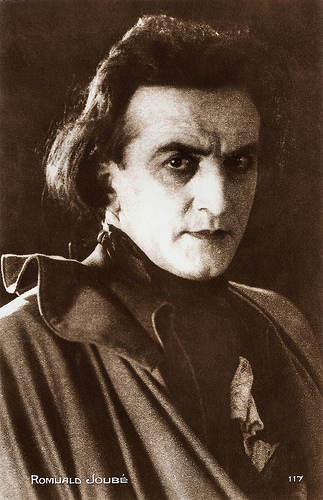
Romuald Joubé . French postcard by Editions Cinémagazine, no. 117. Joubé appears in Le coupable/The guilty party (André Antoine, 1917).
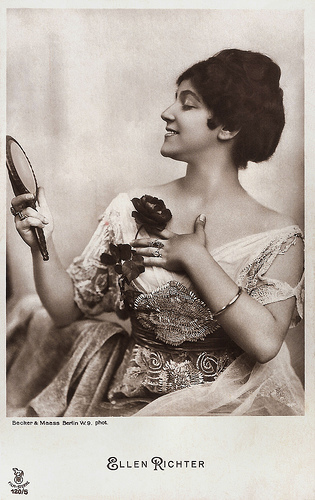
Ellen Richter . German postcard in the Film-Sterne series by Rotophot, no. 120/5. Photo: Becker & Maass, Berlin. Richter was the star of Das Bacchanal des Todes/ The Bacchanal of Death (Richard Eichberg, 1917).
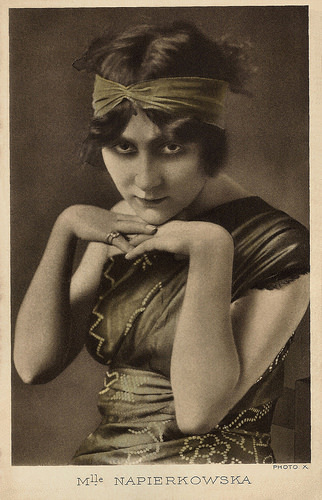
Stacia Napierkowska . French postcard. Photo X. She stars in La tragica fine di Caligula Imperator/Caligula (Ugo Falena, 1917).
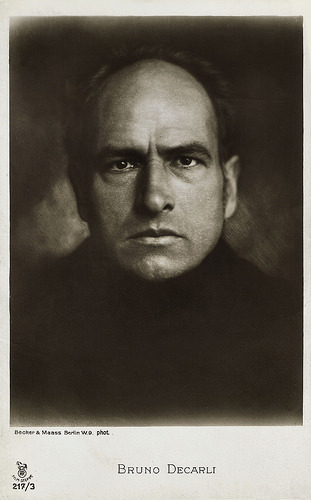
Bruno Decarli . German postcard in the Film-Sterne series by Rotophot, no. 217/3. Photo: Becker & Maass, Berlin. Decarli plays a man haunted by a misdeed he has committed in Furcht/Fear (Robert Wiene, 1917).
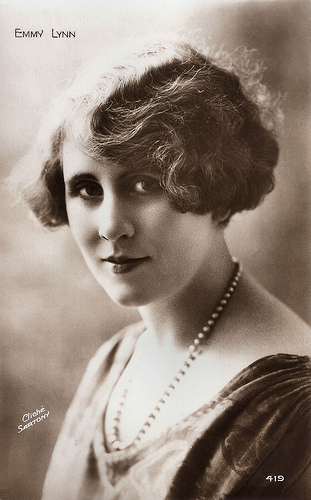
Emmy Lynn. French postcard by Editions Cinémagazine, no. 419. Photo: Sartony. Lynn plays one of the leads in Mater Dolorosa/Sorrowful Mother (Abel Gance, 1917).
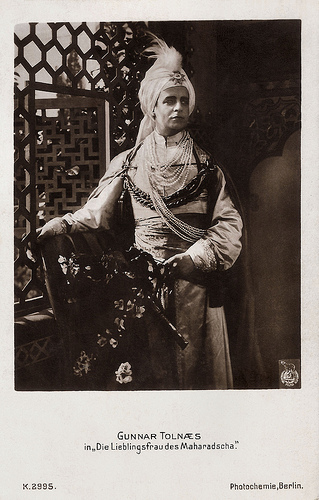
German postcard by Photochemie, Berlin, no. K. 2995. Photo: Nordisk. Publicity still for Maharadjahens Yndlingshustru/The Maharajah's Favourite Wife (Robert Dinesen, 1917), starring Gunnar Tolnaes as an Indian prince. Tolnaes had his most famous performance in this Danish orientalist melodrama. It was so popular that it had a Danish sequel in 1919, and a German sequel in 1921.
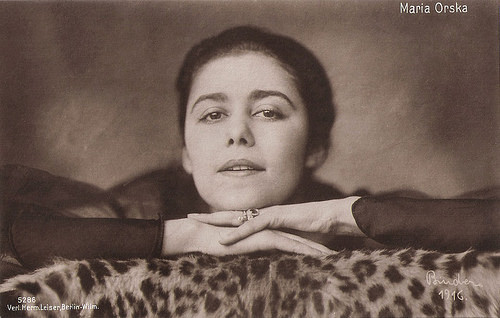
Maria Orska. German postcard by Verlag Hermann Leiser, Berlin-Wilm., no. 5286. Photo: Alex Binder, 1916. She can be seen at Il Cinema Ritrovato in Die schwarze Loo/The Black Loo (Max Mack, 1917).
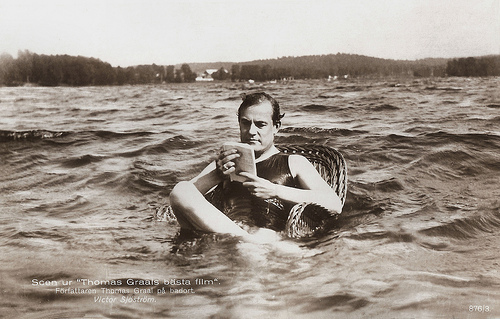
Swedish postcard by Ed. Nordisk Konst, Stockholm, no. 876/3. Photo: publicity still for the comedy Thomas Graals bästa film/Thomas Graal's Best Film (Mauritz Stiller, 1917), scripted by Gustav Molander. The story deals with screenwriter Thomas Graal ( Victor Sjöström ) who falls in love with his secretary Bessie ( Karin Molander ) and imagines himself rescuing her from poverty. Reality is quite different as Bessie is a modern woman. The film also mocks the bored aristocracy involved in the modernity of filmmaking. Caption: "The author Thomas Graal at sea."
Source: Il Cinema Ritrovato.

The Russian film scene, ca. 1917. From left to right: Vitold Polonsky , Vladimir Maksimov , Vera Kholodnaya, Ossip Runitsch (in the back), Petr Cardynin, Ivan Khudoleyev, and Ivan Mozzhukin . Russian postcard. Collection: Didier Hanson.

Italian postcard for the silent film Malombra (Carmine Gallone, 1917), adapted from the novel by Antonio Fogazzaro, and starring Lyda Borelli . Caption: "...Saetta seized [the oars] and left, moving towards some solitary shore."

Pola Negri , ca. 1919. German postcard by Ross Verlag, no. 247. Photo: Alex Binder. Negri stars in the Polish film Bestia/The Polish Dancer (Aleksander Hertz, 1917).

Pauline Starke. Austrian postcard by Iris Verlag, no. 523. Photo: Fanamet Verleih. At Bologna, Starke can be seen in Until They Get Me (Frank Borzage, 1917).

Romuald Joubé . French postcard by Editions Cinémagazine, no. 117. Joubé appears in Le coupable/The guilty party (André Antoine, 1917).

Ellen Richter . German postcard in the Film-Sterne series by Rotophot, no. 120/5. Photo: Becker & Maass, Berlin. Richter was the star of Das Bacchanal des Todes/ The Bacchanal of Death (Richard Eichberg, 1917).

Stacia Napierkowska . French postcard. Photo X. She stars in La tragica fine di Caligula Imperator/Caligula (Ugo Falena, 1917).

Bruno Decarli . German postcard in the Film-Sterne series by Rotophot, no. 217/3. Photo: Becker & Maass, Berlin. Decarli plays a man haunted by a misdeed he has committed in Furcht/Fear (Robert Wiene, 1917).

Emmy Lynn. French postcard by Editions Cinémagazine, no. 419. Photo: Sartony. Lynn plays one of the leads in Mater Dolorosa/Sorrowful Mother (Abel Gance, 1917).

German postcard by Photochemie, Berlin, no. K. 2995. Photo: Nordisk. Publicity still for Maharadjahens Yndlingshustru/The Maharajah's Favourite Wife (Robert Dinesen, 1917), starring Gunnar Tolnaes as an Indian prince. Tolnaes had his most famous performance in this Danish orientalist melodrama. It was so popular that it had a Danish sequel in 1919, and a German sequel in 1921.

Maria Orska. German postcard by Verlag Hermann Leiser, Berlin-Wilm., no. 5286. Photo: Alex Binder, 1916. She can be seen at Il Cinema Ritrovato in Die schwarze Loo/The Black Loo (Max Mack, 1917).

Swedish postcard by Ed. Nordisk Konst, Stockholm, no. 876/3. Photo: publicity still for the comedy Thomas Graals bästa film/Thomas Graal's Best Film (Mauritz Stiller, 1917), scripted by Gustav Molander. The story deals with screenwriter Thomas Graal ( Victor Sjöström ) who falls in love with his secretary Bessie ( Karin Molander ) and imagines himself rescuing her from poverty. Reality is quite different as Bessie is a modern woman. The film also mocks the bored aristocracy involved in the modernity of filmmaking. Caption: "The author Thomas Graal at sea."
Source: Il Cinema Ritrovato.
Published on June 23, 2017 22:00
In memory of Ad Werner (1925-2017)
On 17 June 2017, Dutch graphic designer Ad Werner passed away at the age of 92 years. Werner's letter designs and figurative marks are world-famous. He designed the logo for Quick and the Mexican for cigarette brand Caballero is an icon of Dutch design. Werner worked for the Hema stores for years and for Fokker, designed a house style for the municipality of Amsterdam, was the co-founder and designer of the name of the women magazine Opzij (The guys must make place for the women), he made cartoons for the newspaper NRC and for Schiphol airport, designed posters and decors for stage artists, and lectured at the Royal Academy of Fine Arts in The Hague. It is less known that he also designed hundreds of film posters for the Tuschinski group immediately after the war.
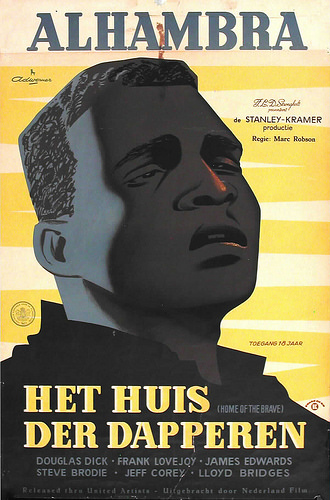
Het huis der dapperen. Dutch film poster by Ad Werner for Home of the Brave (Mark Robson, 1949) about racism during WW II. Pictured is James Edwards as the suffering but proud soldier Moss.
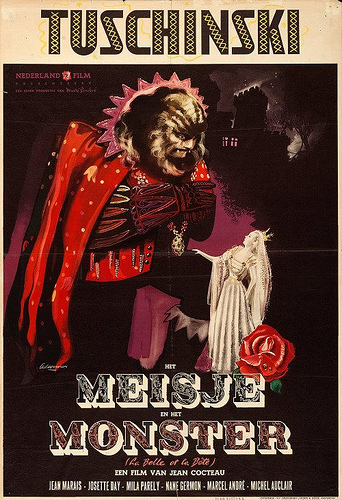
Het meisje en het monster. Dutch film poster by Ad Werner for La belle et la bête/Beauty and the beast (Jean Cocteau, 1946). Pictured are Jean Marais as the Beast and Josette Day as Belle.
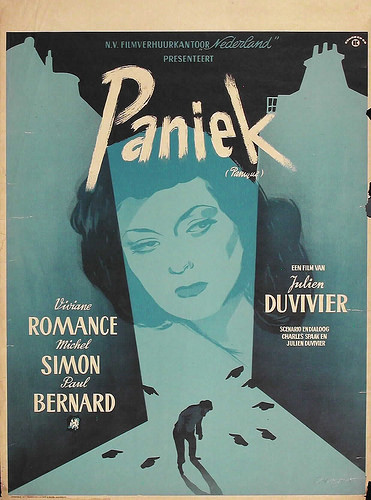
Paniek. Dutch film poster by Ad Werner for Panique/Panic (Julien Duvivier, 1946). Pictured are Viviane Romance as Alice and Michel Simon as Monsieur Hire.
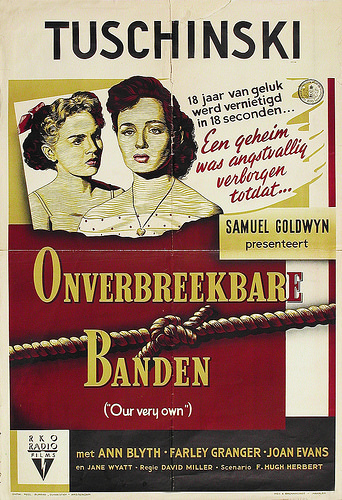
Onverbreekbare banden. Dutch film poster by Ad Werner for Our Very Own (David Miller, 1950). Pictured are Ann Blyth and Joan Evans.
Capturing the Zeitgeist perfectly
Adrianus Gerardus (Ad) Werner (1925), born in Leiden, was the son of a printer. He was educated at the Koninklijke Academie voor de Beeldende Kunsten (the Royal Academy of Fine Arts) in The Hague in accordance with the principles of the Bauhaus. To the dismay of his former teacher Paul Schuitema, he started his career as a young graphic designer with creating film posters.
In 1947 he had moved to Amsterdam where he had quickly found a job at Keman & Co, an advertising agency. His main task there was designing film posters for the Strengholt group behind Theater Tuschinski, the most prestigious movie palace in the Netherlands. His posters were a success. And after three years he and two colleagues started their own studio, Centaur.
Later, Ad Werner would work for many years for the HEMA department stores, he designed for popular Dutch magazines like Margriet, Elegance and Nieuwe Revu and drew cartoons for newspapers. Author and designer Jan Middendorp about Werner: ‘Someone who managed to capture the Zeitgeist perfectly and give it a pure expression that was attractive to a large public’.
Ad Werner's designs earned him little prestige from colleagues or critics. Within the world of Dutch graphic design he was called an outsider, someone who was completely uninterested in intellectualism and conceptual thinking.
Yet his influence on the graphic appearance of the Netherlands in the 1970s and 1980s was significant, thanks to his work for such firms as Fokker, Philips and Citroën, his corporate identity for the City of Amsterdam, his famous little Mexican for the cigarette brand Caballero and his logos and type designs which also made him internationally known.
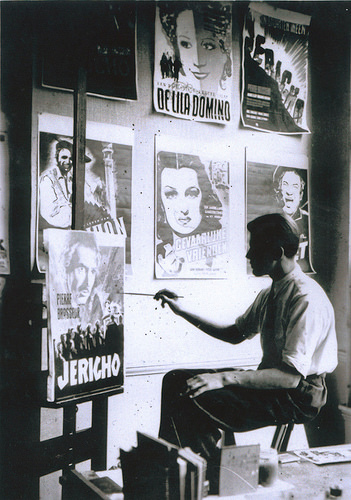
Ad Werner in his poster studio, ca. 1946.
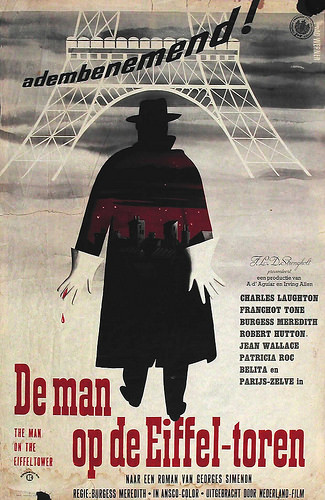
De man op de Eiffel-toren. Dutch film poster by Ad Werner for The Man on the Eiffel Tower (Burgess Meredith, 1950).
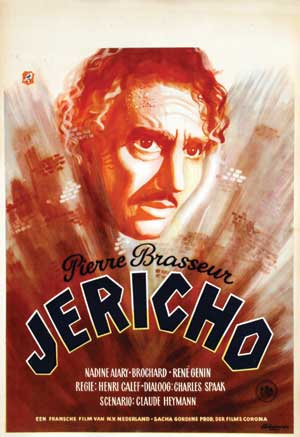
Jericho. Dutch film poster by Ad Werner for Jericho (Henri Calef, 1946). Pictured is Pierre Brasseur .
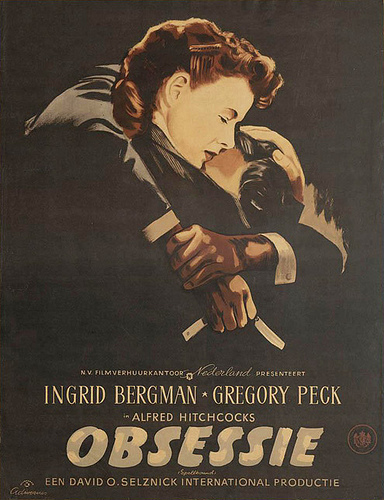
Obsessie. Dutch film poster by Ad Werner for Spellbound (Alfred Hitchcock, 1945). Pictured are Ingrid Bergman and Gregory Peck.
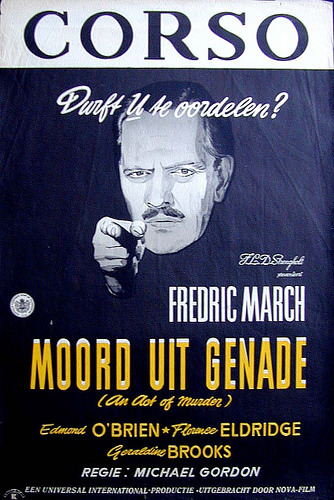
Moord uit genade. Dutch film poster by Ad Werner for An Act of Murder (Michael Gordon, 1948). Pictured is Fredric March.
Imaginative and multi-layered designs
Ad Werner designed hundreds of film posters between 1946 and 1955. In 2007, I discovered these 'affiches' when I was writing a series of columns on the poster collection of the Dutch Filmmuseum (now EYE) for film magazine Skrien. I had selected Werner's Het huis der dapperen, made for a little known film by Mark Robson, Home of the Brave, on racism in the American army during the war.
I liked how the designer had created this powerful image of a black, suffering war hero: only four colours, a low point of view and a dynamic background of yellow stripes.
To my surprise and delight, the curator of the collection told me that the poster designer was still alive and active, and that he was living in Amsterdam. So, I called Mr. Werner and he invited me to visit him at his home. For hours we sat in his garden while he told me about his work and showed me the colourful and imaginative posters he had created as a young man and also his many other designs.
Werner's stories about his experiences in the Dutch film and design world after the Second World War were fascinating. His painted designs were imaginative and multi-layered. I decided to write a large interview with him for Skrien, as an addition to the poster column.
Later I also invited Ad and his wife for a lecture in a series of colleges on film posters which Ivo Blom and I had organised together with the Dutch Filmmuseum at the Vrije Universiteit in Amsterdam. The students loved Ad's poster designs and his inside stories about working for the cinema. One of the students, Aaron J. Peterer, made an short documentary about Ad, which you can view below.
Again some months later, publisher Robert van Rixtel of [Z]OO producties asked me for suggestions for his Roots series about Dutch graphic designers. When I suggested Ad Werner, Robert was triggered while Werner was fairly unknown to him. And when he heard about Werner's letter designs, his many logos, his house style for the city of Amsterdam, he was impressed.
Ad Werner also liked the idea of a publication. So our little but beautiful booklet was presented with Ad's many family members, famous friends and old colleagues attending. Former Minister of Culture Hedy d'Ancona, with whom he had founded feminist magazine Opzij did the speech, Aaron's excellent film was shown and everybody loved the anecdotes Ad told when I interviewed him. There were huge cakes with his old poster designs on it and Ad's many grandchildren fought about who would have the first piece.
Our collaboration is a happy memory to me. Mr. Werner, dear Ad, thank you and rest in piece.
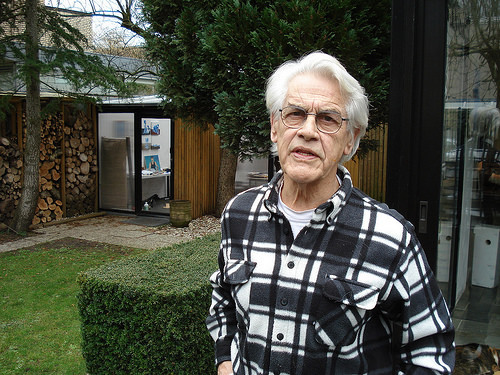
Ad Werner in his garden in Amsterdam, 2007.
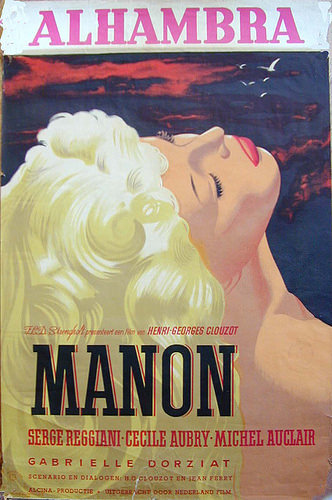
Manon. Dutch film poster by Ad Werner for Manon (Henri-Georges Clouzot, 1949). Pictured is Cécile Aubry as Manon.
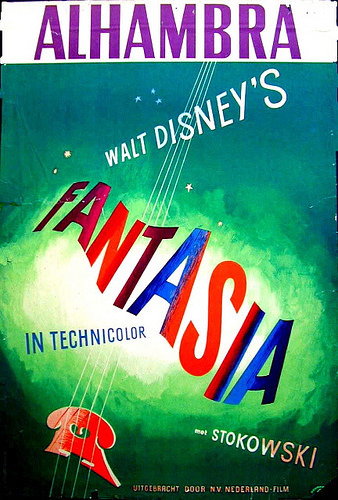
Fantasia. Dutch film poster by Ad Werner for Fantasia (Walt Disney, 1940).
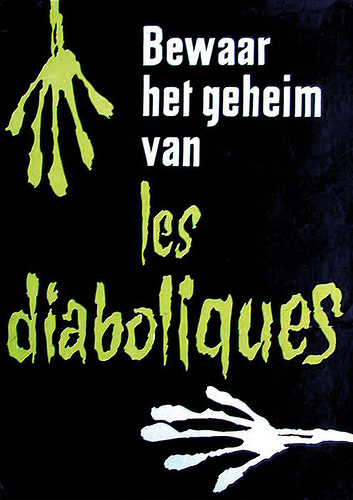
Bewaar het geheim van les diaboliques. Dutch film poster by Ad Werner for Les diaboliques (Henri-Georges Clouzot, 1955).
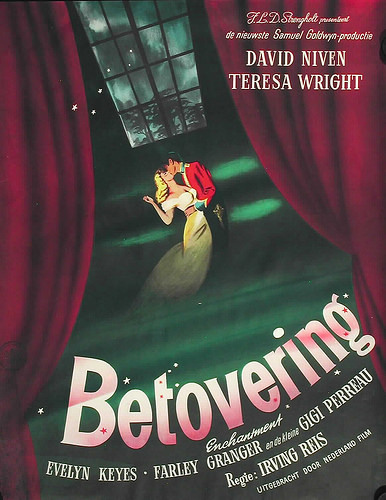
Betovering. Dutch film poster by Ad Werner for Enchantment (Irving Reis, 1948). Pictured are David Niven as General Sir Roland Dane and Teresa Wright as Lark Ingoldsby.
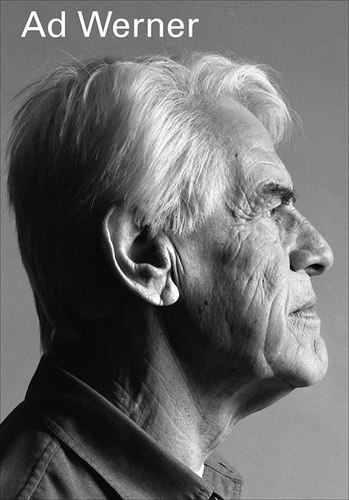
Cover of my publication Ad Werner, published in the Roots series by [Z]OO producties. Photo: Aatjan Renders.
Filmaffiches van Ad Werner by Aaron J. Peterer on Vimeo.
Sources: Roots 15: Ad Werner (Dutch), Design History.nl (Dutch), Dutch Design Weekly and Wikipedia (Dutch).

Het huis der dapperen. Dutch film poster by Ad Werner for Home of the Brave (Mark Robson, 1949) about racism during WW II. Pictured is James Edwards as the suffering but proud soldier Moss.

Het meisje en het monster. Dutch film poster by Ad Werner for La belle et la bête/Beauty and the beast (Jean Cocteau, 1946). Pictured are Jean Marais as the Beast and Josette Day as Belle.

Paniek. Dutch film poster by Ad Werner for Panique/Panic (Julien Duvivier, 1946). Pictured are Viviane Romance as Alice and Michel Simon as Monsieur Hire.

Onverbreekbare banden. Dutch film poster by Ad Werner for Our Very Own (David Miller, 1950). Pictured are Ann Blyth and Joan Evans.
Capturing the Zeitgeist perfectly
Adrianus Gerardus (Ad) Werner (1925), born in Leiden, was the son of a printer. He was educated at the Koninklijke Academie voor de Beeldende Kunsten (the Royal Academy of Fine Arts) in The Hague in accordance with the principles of the Bauhaus. To the dismay of his former teacher Paul Schuitema, he started his career as a young graphic designer with creating film posters.
In 1947 he had moved to Amsterdam where he had quickly found a job at Keman & Co, an advertising agency. His main task there was designing film posters for the Strengholt group behind Theater Tuschinski, the most prestigious movie palace in the Netherlands. His posters were a success. And after three years he and two colleagues started their own studio, Centaur.
Later, Ad Werner would work for many years for the HEMA department stores, he designed for popular Dutch magazines like Margriet, Elegance and Nieuwe Revu and drew cartoons for newspapers. Author and designer Jan Middendorp about Werner: ‘Someone who managed to capture the Zeitgeist perfectly and give it a pure expression that was attractive to a large public’.
Ad Werner's designs earned him little prestige from colleagues or critics. Within the world of Dutch graphic design he was called an outsider, someone who was completely uninterested in intellectualism and conceptual thinking.
Yet his influence on the graphic appearance of the Netherlands in the 1970s and 1980s was significant, thanks to his work for such firms as Fokker, Philips and Citroën, his corporate identity for the City of Amsterdam, his famous little Mexican for the cigarette brand Caballero and his logos and type designs which also made him internationally known.

Ad Werner in his poster studio, ca. 1946.

De man op de Eiffel-toren. Dutch film poster by Ad Werner for The Man on the Eiffel Tower (Burgess Meredith, 1950).

Jericho. Dutch film poster by Ad Werner for Jericho (Henri Calef, 1946). Pictured is Pierre Brasseur .

Obsessie. Dutch film poster by Ad Werner for Spellbound (Alfred Hitchcock, 1945). Pictured are Ingrid Bergman and Gregory Peck.

Moord uit genade. Dutch film poster by Ad Werner for An Act of Murder (Michael Gordon, 1948). Pictured is Fredric March.
Imaginative and multi-layered designs
Ad Werner designed hundreds of film posters between 1946 and 1955. In 2007, I discovered these 'affiches' when I was writing a series of columns on the poster collection of the Dutch Filmmuseum (now EYE) for film magazine Skrien. I had selected Werner's Het huis der dapperen, made for a little known film by Mark Robson, Home of the Brave, on racism in the American army during the war.
I liked how the designer had created this powerful image of a black, suffering war hero: only four colours, a low point of view and a dynamic background of yellow stripes.
To my surprise and delight, the curator of the collection told me that the poster designer was still alive and active, and that he was living in Amsterdam. So, I called Mr. Werner and he invited me to visit him at his home. For hours we sat in his garden while he told me about his work and showed me the colourful and imaginative posters he had created as a young man and also his many other designs.
Werner's stories about his experiences in the Dutch film and design world after the Second World War were fascinating. His painted designs were imaginative and multi-layered. I decided to write a large interview with him for Skrien, as an addition to the poster column.
Later I also invited Ad and his wife for a lecture in a series of colleges on film posters which Ivo Blom and I had organised together with the Dutch Filmmuseum at the Vrije Universiteit in Amsterdam. The students loved Ad's poster designs and his inside stories about working for the cinema. One of the students, Aaron J. Peterer, made an short documentary about Ad, which you can view below.
Again some months later, publisher Robert van Rixtel of [Z]OO producties asked me for suggestions for his Roots series about Dutch graphic designers. When I suggested Ad Werner, Robert was triggered while Werner was fairly unknown to him. And when he heard about Werner's letter designs, his many logos, his house style for the city of Amsterdam, he was impressed.
Ad Werner also liked the idea of a publication. So our little but beautiful booklet was presented with Ad's many family members, famous friends and old colleagues attending. Former Minister of Culture Hedy d'Ancona, with whom he had founded feminist magazine Opzij did the speech, Aaron's excellent film was shown and everybody loved the anecdotes Ad told when I interviewed him. There were huge cakes with his old poster designs on it and Ad's many grandchildren fought about who would have the first piece.
Our collaboration is a happy memory to me. Mr. Werner, dear Ad, thank you and rest in piece.

Ad Werner in his garden in Amsterdam, 2007.

Manon. Dutch film poster by Ad Werner for Manon (Henri-Georges Clouzot, 1949). Pictured is Cécile Aubry as Manon.

Fantasia. Dutch film poster by Ad Werner for Fantasia (Walt Disney, 1940).

Bewaar het geheim van les diaboliques. Dutch film poster by Ad Werner for Les diaboliques (Henri-Georges Clouzot, 1955).

Betovering. Dutch film poster by Ad Werner for Enchantment (Irving Reis, 1948). Pictured are David Niven as General Sir Roland Dane and Teresa Wright as Lark Ingoldsby.

Cover of my publication Ad Werner, published in the Roots series by [Z]OO producties. Photo: Aatjan Renders.
Filmaffiches van Ad Werner by Aaron J. Peterer on Vimeo.
Sources: Roots 15: Ad Werner (Dutch), Design History.nl (Dutch), Dutch Design Weekly and Wikipedia (Dutch).
Published on June 23, 2017 08:29
June 22, 2017
Édith Piaf
Édith Piaf (1915-1963) is a cultural icon and is universally regarded as France's greatest popular singer. Her ballads, like La Vie en rose (1946) and Non, je ne regrette rien (1960), reflected her life. She appeared sporadically in films.
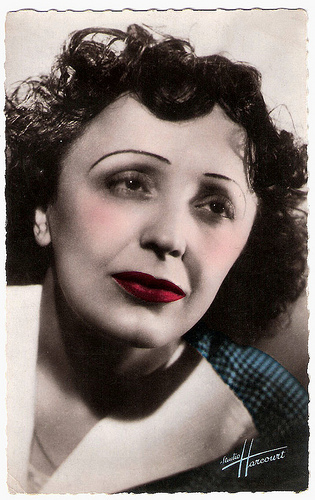
French postcard by Editions O.P., Paris, no. 18. Photo: Studio Harcourt.
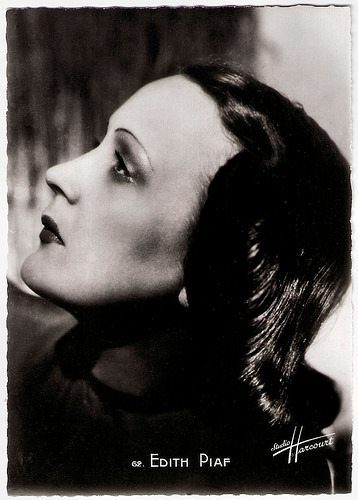
French postcard by S.E.R.P., Paris, no. 62. Photo: Studio Harcourt, Paris.
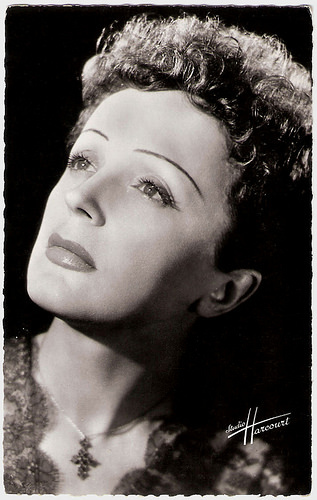
French postcard by Editions du Globe (E.D.U.G.), no. 171. Photo: Studio Harcourt.
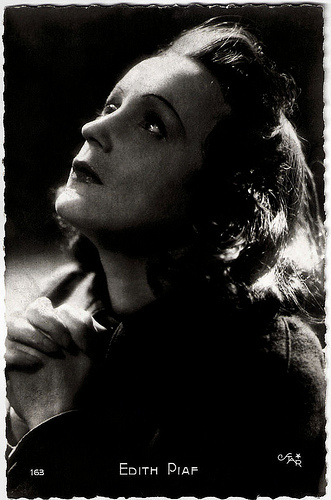
French postcard by Editions P.I., no. 163. Photo: Star.
The Little Sparrow
Despite numerous biographies, much of Édith Piaf's life is shrouded in mystery. She was born Édith Giovanna Gassion in Ménilmontant, one of the poorer districts of Paris, in 1915. She was named Edith after the World War I British nurse Edith Cavell, who was executed for helping French soldiers escape from German captivity. Piaf - a Francilien colloquialism for sparrow - was a nickname she would receive 20 years later.
Her Moroccan-Italian mother, Anita Maillard, worked as a cafe singer under the name Line Marsa. Louis-Alphonse Gassion, Édith's father, was a Norman street acrobat with a past in the theatre. Édith's parents soon abandoned her, and she lived for a short time with her maternal grandmother, who virtually ignored her.
Her father had enlisted with the French Army to fight in World War I. When Louis Alphonse returned in 1918, he decided to send his daughter to live with his mother in Normandy. Later, she joined her father in his acrobatic street performances all over France. Discovering that she had a powerful singing voice which could hold a crowd mesmerised for longer than her father's back flips, Edith decided to follow in her mother's footsteps.
In Paris she went her own way and began singing on the Paris streets while her friend Simone, aka Momone, passed the hat round. In spite of her scruffy street urchin appearance, Edith proved extremely popular with the crowds, her amazingly expressive voice managing to move even the most impassive listener.
She was about 16 when she fell in love with Louis Dupont, a delivery boy and they soon had a child, Marcelle, who died of meningitis at age two.
In 1935 Piaf was discovered by Louis Leplée, owner of the nightclub Le Gerny off the Champs-Élysées. He gave her the nickname that would stay with her for the rest of her life, La Môme Piaf (The Little Sparrow - she was only 1 m 47 tall). Leplée taught her the basics of stage presence and told her to wear a black dress, later to become her trademark apparel.
Leplée ran an intense publicity campaign leading up to her opening night, attracting the presence of many celebrities, including Maurice Chevalier . Her nightclub gigs led to her first two records produced that same year. In 1936, Leplée was murdered and Piaf was questioned and accused as an accessory, but was acquitted. Leplée had been killed by mobsters with previous ties to Piaf.
To rehabilitate her image, she recruited Raymond Asso, with whom she would become romantically involved. He changed her stage name to Édith Piaf, barred undesirable acquaintances from seeing her, and commissioned Marguerite Monnot to write songs that reflected or alluded to Piaf's previous life on the streets. Later that same year Piaf launched a film career, appearing in La garçonne/The Tomboy (Jean Limur, 1937) with Marie Bell .
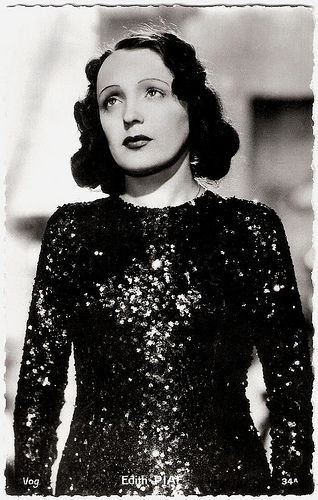
French postcard by Edit. Chantal, Rueil, no. 34A. Photo: Vog.
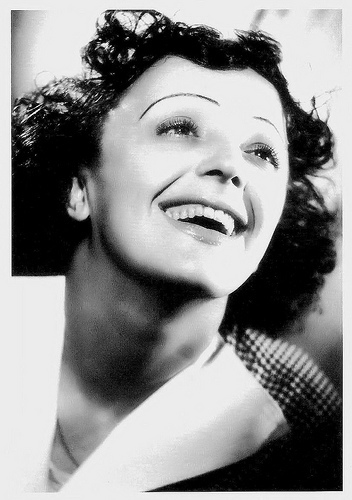
Modern French postcard by Éditions du Désastre, Paris, no. PR 022. Photo: Studio Harcourt, 1946.
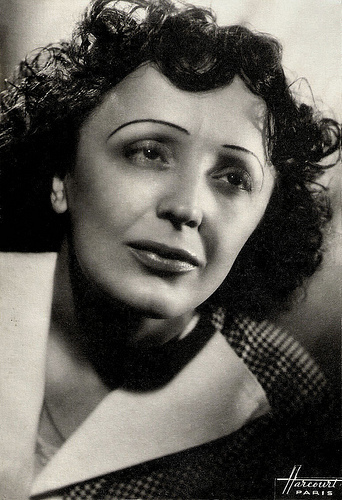
French postcard. Sent in 1948. Photo: Studio Harcourt, Paris.
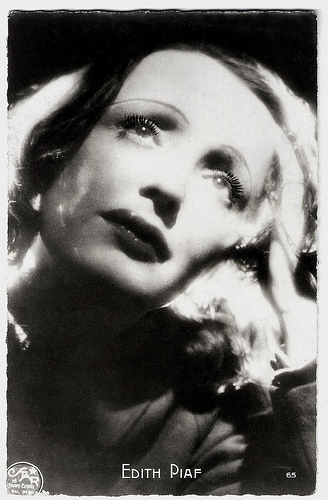
French postcard by O.P., Paris, no. 65. Photo: Star.
The love of Piaf's life
In 1940, Édith Piaf co-starred with Paul Meurisse in Jean Cocteau's successful one-act play Le Bel Indifférent (The beautiful indifferent). Piaf and Meurisse were then offered leading roles in the film Montmartre-sur-Seine (Georges Lacombe, 1940) in which the couple starred alongside the famous French actor Jean-Louis Barrault .
She began forming friendships with prominent people, including Chevalier and poet Jacques Borgeat. He wrote the lyrics of many of her songs and collaborated with composers on the tunes.
In 1944, she discovered Yves Montand in Paris, made him part of her act, and became his mentor and lover. They would form a famous double act in the film Etoile sans lumière/Star Without Light (Marcel Blistène, 1945). Within a year, Montand became one of the most famous singers in France, and Piaf broke off their relationship when he had become almost as popular as she was.
During this time she was in great demand and very successful in Paris as France's most popular entertainer. After the war, she became known internationally, touring Europe, the United States, and South America. She scored a major hit in 1946 with Les Trois Cloches, which would later become an English-language smash for The Browns when translated into The Three Bells.
Later that year, she recorded the self-composed number La Vie en Rose, another huge hit that international audiences would come to regard as her signature song. She also sang it in the film Neuf garçons, un coeur/Nine Boys, One Heart (Georges Friedland, 1948), in which she appeared with her new proteges Les Compagnons de la Chanson.
The love of Piaf's life was the married boxing champion Marcel Cerdan . He died in a plane crash in October 1949, while flying from Paris to New York City to meet her. His sudden death left Piaf devastated and she fell in a deep depression. It was the beginning of her downfall, and drugs and alcohol began to take their toll on Piaf’s increasingly fragile health.
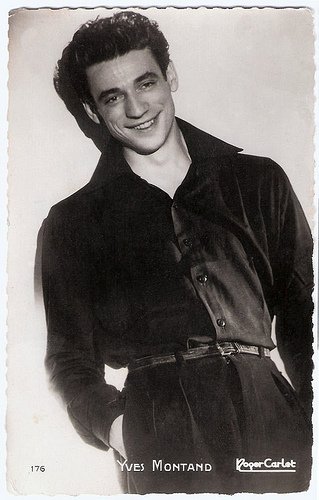
Yves Montand. French postcard by Editions P.I., Paris, no. 176. Photo: Roger Carlet.
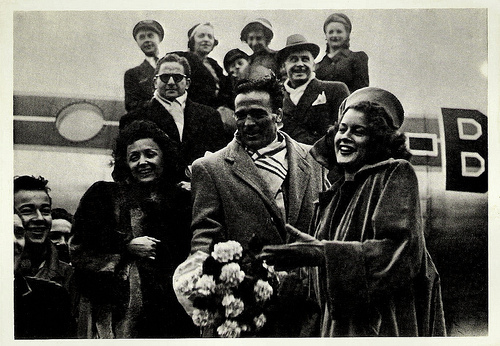
French postcard by Editions Gendre, Paris, no. 27. Photo: Keystone. Caption: Edith Piaf, Marcel Cerdan, March 1948.
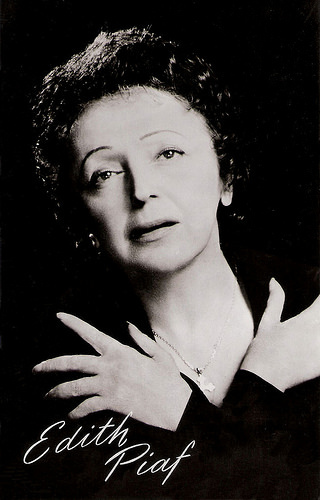
Dutch postcard by Uitg. Takken, Utrecht, no. AX 5247. Photo: Columbia.
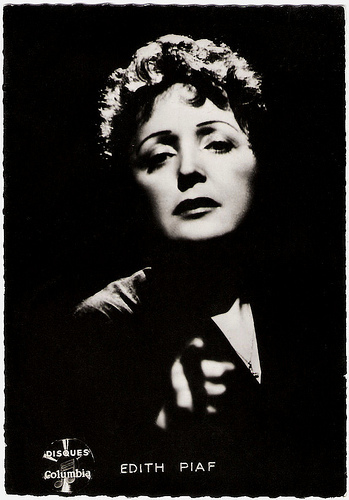
French promotion card by Disques Columbia.
Alcohol and Morphine
In the early 1950s Édith Piaf would begin a long series of treatments in a private health clinic, in an attempt to wean herself off alcohol and morphine. Yet, while her health continued to decline, Piaf's voice appeared to go from strength to strength.
She also helped launch the career of Charles Aznavour , taking him on tour with her in France and the United States and recording some of his songs.
In 1951 Piaf would fall in love again, throwing herself into a passionate relationship with Eddie Constantine , a young American singer and actor. Later that same year Piaf would demand that her new protege be given a lead role in Marcel Achard's operetta, La p'tite Lili (Little Lili), which Achard was staging at the ABC with Marguerite Monnot. Piaf got her way and helped Constantine launch his career. But after La p'tite Lili’s successful seven month run at the ABC, Piaf and Constantine's relationship also came to an end.
The following year Piaf married singer Jacques Pills and after four years they divorced in 1956. Not long afterward, she suffered an attack of delirium tremens and had to be hospitalised.
In 1954 she appeared in two successful films, in Si Versailles m'était conté/Affairs in Versailles (Sacha Guitry, 1954), a witty history of the Versailles palace, and in French Cancan (Jean Renoir, 1954) about the revival of Paris' most notorious dance.
Piaf achieved lasting fame in Bruno Coquatrix's famous Paris Olympia music hall where she gave several series of concerts from 1955 till 1962.
In late 1958, she met another up-and-coming songwriter, Georges Moustaki, and made him her latest lover and improvement project. Teaming once again with Marguerite Monnot, Moustaki co-wrote Milord, an enormous hit that topped the charts all over Europe in early 1959 and became Piaf's first successful single in the U.K.
She made one last film, Les amants de demain/The Lovers of Tomorrow (Marcel Blistène, 1959) opposite Michel Auclair . In 1962, she wed Théo Sarapo (Theophanis Lamboukas), a Greek hairdresser-turned-singer and actor who was 20 years her junior. The couple sang together in some of her last engagements.
In 1963 Édith Piaf died of liver cancer at Plascassier, on the French Riviera, aged 47. Although she was denied a funeral mass by the Roman Catholic archbishop of Paris because of her lifestyle, her funeral procession drew tens of thousands of mourners onto the streets of Paris and the ceremony at the cemetery was attended by more than 100,000 fans.
The film Piaf (Guy Casaril, 1974) depicted her early years, and starred Brigitte Ariel, with early Piaf songs performed by Betty Mars. Piaf's relationship with Cerdan was depicted in the film Édith et Marcel (Claude Lelouch, 1983) with Marcel Cerdan Jr. in the role of his father and Évelyne Bouix portraying Piaf. Piaf...Her Story...Her Songs (George Elder, Bernard Salzmann. 2003) is a documentary starring Raquel Bitton in her performance tribute to Edith Piaf.
La Môme/La Vie en rose (Olivier Dahan, 2007) debuted at the Berlin Film Festival in February 2007. The film features Marion Cotillard in the role that won her the Golden Globe, the BAFTA award and the Academy Award for Best Actress.
At AllMusic, Steve Huey writes about Édith Piaf: “Still revered as an icon decades after her death, ‘the Sparrow’ served as a touchstone for virtually every chansonnier, male or female, who followed her. Her greatest strength wasn't so much her technique, or the purity of her voice, but the raw, passionate power of her singing.”
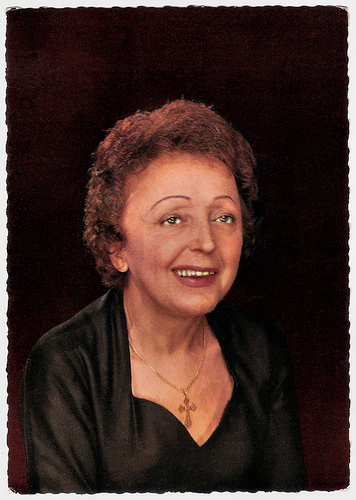
French postcard by E.D.U.G., no. 270. Photo: Sam Lévin.
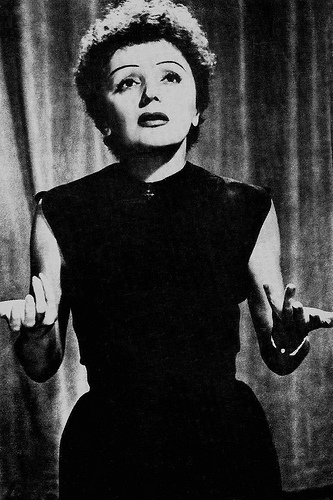
French postcard by Ébullitions, no. 66.
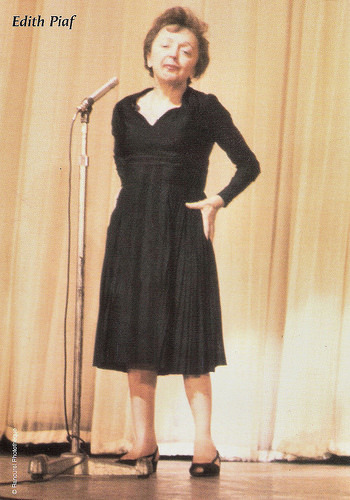
French postcard by L'Encyclopédie de la Chanson Française, 2003. Photo: Universal Collections.
Edith Piaf sings La Vie En Rose in Neuf garçons, un coeur/Nine Boys, One Heart (1948). Source: bigproblem11 (Daily Motion).
Sources: Steve Huey (AllMusic), (IMDb), RFI Musique, Wikipedia, and .

French postcard by Editions O.P., Paris, no. 18. Photo: Studio Harcourt.

French postcard by S.E.R.P., Paris, no. 62. Photo: Studio Harcourt, Paris.

French postcard by Editions du Globe (E.D.U.G.), no. 171. Photo: Studio Harcourt.

French postcard by Editions P.I., no. 163. Photo: Star.
The Little Sparrow
Despite numerous biographies, much of Édith Piaf's life is shrouded in mystery. She was born Édith Giovanna Gassion in Ménilmontant, one of the poorer districts of Paris, in 1915. She was named Edith after the World War I British nurse Edith Cavell, who was executed for helping French soldiers escape from German captivity. Piaf - a Francilien colloquialism for sparrow - was a nickname she would receive 20 years later.
Her Moroccan-Italian mother, Anita Maillard, worked as a cafe singer under the name Line Marsa. Louis-Alphonse Gassion, Édith's father, was a Norman street acrobat with a past in the theatre. Édith's parents soon abandoned her, and she lived for a short time with her maternal grandmother, who virtually ignored her.
Her father had enlisted with the French Army to fight in World War I. When Louis Alphonse returned in 1918, he decided to send his daughter to live with his mother in Normandy. Later, she joined her father in his acrobatic street performances all over France. Discovering that she had a powerful singing voice which could hold a crowd mesmerised for longer than her father's back flips, Edith decided to follow in her mother's footsteps.
In Paris she went her own way and began singing on the Paris streets while her friend Simone, aka Momone, passed the hat round. In spite of her scruffy street urchin appearance, Edith proved extremely popular with the crowds, her amazingly expressive voice managing to move even the most impassive listener.
She was about 16 when she fell in love with Louis Dupont, a delivery boy and they soon had a child, Marcelle, who died of meningitis at age two.
In 1935 Piaf was discovered by Louis Leplée, owner of the nightclub Le Gerny off the Champs-Élysées. He gave her the nickname that would stay with her for the rest of her life, La Môme Piaf (The Little Sparrow - she was only 1 m 47 tall). Leplée taught her the basics of stage presence and told her to wear a black dress, later to become her trademark apparel.
Leplée ran an intense publicity campaign leading up to her opening night, attracting the presence of many celebrities, including Maurice Chevalier . Her nightclub gigs led to her first two records produced that same year. In 1936, Leplée was murdered and Piaf was questioned and accused as an accessory, but was acquitted. Leplée had been killed by mobsters with previous ties to Piaf.
To rehabilitate her image, she recruited Raymond Asso, with whom she would become romantically involved. He changed her stage name to Édith Piaf, barred undesirable acquaintances from seeing her, and commissioned Marguerite Monnot to write songs that reflected or alluded to Piaf's previous life on the streets. Later that same year Piaf launched a film career, appearing in La garçonne/The Tomboy (Jean Limur, 1937) with Marie Bell .

French postcard by Edit. Chantal, Rueil, no. 34A. Photo: Vog.

Modern French postcard by Éditions du Désastre, Paris, no. PR 022. Photo: Studio Harcourt, 1946.

French postcard. Sent in 1948. Photo: Studio Harcourt, Paris.

French postcard by O.P., Paris, no. 65. Photo: Star.
The love of Piaf's life
In 1940, Édith Piaf co-starred with Paul Meurisse in Jean Cocteau's successful one-act play Le Bel Indifférent (The beautiful indifferent). Piaf and Meurisse were then offered leading roles in the film Montmartre-sur-Seine (Georges Lacombe, 1940) in which the couple starred alongside the famous French actor Jean-Louis Barrault .
She began forming friendships with prominent people, including Chevalier and poet Jacques Borgeat. He wrote the lyrics of many of her songs and collaborated with composers on the tunes.
In 1944, she discovered Yves Montand in Paris, made him part of her act, and became his mentor and lover. They would form a famous double act in the film Etoile sans lumière/Star Without Light (Marcel Blistène, 1945). Within a year, Montand became one of the most famous singers in France, and Piaf broke off their relationship when he had become almost as popular as she was.
During this time she was in great demand and very successful in Paris as France's most popular entertainer. After the war, she became known internationally, touring Europe, the United States, and South America. She scored a major hit in 1946 with Les Trois Cloches, which would later become an English-language smash for The Browns when translated into The Three Bells.
Later that year, she recorded the self-composed number La Vie en Rose, another huge hit that international audiences would come to regard as her signature song. She also sang it in the film Neuf garçons, un coeur/Nine Boys, One Heart (Georges Friedland, 1948), in which she appeared with her new proteges Les Compagnons de la Chanson.
The love of Piaf's life was the married boxing champion Marcel Cerdan . He died in a plane crash in October 1949, while flying from Paris to New York City to meet her. His sudden death left Piaf devastated and she fell in a deep depression. It was the beginning of her downfall, and drugs and alcohol began to take their toll on Piaf’s increasingly fragile health.

Yves Montand. French postcard by Editions P.I., Paris, no. 176. Photo: Roger Carlet.

French postcard by Editions Gendre, Paris, no. 27. Photo: Keystone. Caption: Edith Piaf, Marcel Cerdan, March 1948.

Dutch postcard by Uitg. Takken, Utrecht, no. AX 5247. Photo: Columbia.

French promotion card by Disques Columbia.
Alcohol and Morphine
In the early 1950s Édith Piaf would begin a long series of treatments in a private health clinic, in an attempt to wean herself off alcohol and morphine. Yet, while her health continued to decline, Piaf's voice appeared to go from strength to strength.
She also helped launch the career of Charles Aznavour , taking him on tour with her in France and the United States and recording some of his songs.
In 1951 Piaf would fall in love again, throwing herself into a passionate relationship with Eddie Constantine , a young American singer and actor. Later that same year Piaf would demand that her new protege be given a lead role in Marcel Achard's operetta, La p'tite Lili (Little Lili), which Achard was staging at the ABC with Marguerite Monnot. Piaf got her way and helped Constantine launch his career. But after La p'tite Lili’s successful seven month run at the ABC, Piaf and Constantine's relationship also came to an end.
The following year Piaf married singer Jacques Pills and after four years they divorced in 1956. Not long afterward, she suffered an attack of delirium tremens and had to be hospitalised.
In 1954 she appeared in two successful films, in Si Versailles m'était conté/Affairs in Versailles (Sacha Guitry, 1954), a witty history of the Versailles palace, and in French Cancan (Jean Renoir, 1954) about the revival of Paris' most notorious dance.
Piaf achieved lasting fame in Bruno Coquatrix's famous Paris Olympia music hall where she gave several series of concerts from 1955 till 1962.
In late 1958, she met another up-and-coming songwriter, Georges Moustaki, and made him her latest lover and improvement project. Teaming once again with Marguerite Monnot, Moustaki co-wrote Milord, an enormous hit that topped the charts all over Europe in early 1959 and became Piaf's first successful single in the U.K.
She made one last film, Les amants de demain/The Lovers of Tomorrow (Marcel Blistène, 1959) opposite Michel Auclair . In 1962, she wed Théo Sarapo (Theophanis Lamboukas), a Greek hairdresser-turned-singer and actor who was 20 years her junior. The couple sang together in some of her last engagements.
In 1963 Édith Piaf died of liver cancer at Plascassier, on the French Riviera, aged 47. Although she was denied a funeral mass by the Roman Catholic archbishop of Paris because of her lifestyle, her funeral procession drew tens of thousands of mourners onto the streets of Paris and the ceremony at the cemetery was attended by more than 100,000 fans.
The film Piaf (Guy Casaril, 1974) depicted her early years, and starred Brigitte Ariel, with early Piaf songs performed by Betty Mars. Piaf's relationship with Cerdan was depicted in the film Édith et Marcel (Claude Lelouch, 1983) with Marcel Cerdan Jr. in the role of his father and Évelyne Bouix portraying Piaf. Piaf...Her Story...Her Songs (George Elder, Bernard Salzmann. 2003) is a documentary starring Raquel Bitton in her performance tribute to Edith Piaf.
La Môme/La Vie en rose (Olivier Dahan, 2007) debuted at the Berlin Film Festival in February 2007. The film features Marion Cotillard in the role that won her the Golden Globe, the BAFTA award and the Academy Award for Best Actress.
At AllMusic, Steve Huey writes about Édith Piaf: “Still revered as an icon decades after her death, ‘the Sparrow’ served as a touchstone for virtually every chansonnier, male or female, who followed her. Her greatest strength wasn't so much her technique, or the purity of her voice, but the raw, passionate power of her singing.”

French postcard by E.D.U.G., no. 270. Photo: Sam Lévin.

French postcard by Ébullitions, no. 66.

French postcard by L'Encyclopédie de la Chanson Française, 2003. Photo: Universal Collections.
Edith Piaf sings La Vie En Rose in Neuf garçons, un coeur/Nine Boys, One Heart (1948). Source: bigproblem11 (Daily Motion).
Sources: Steve Huey (AllMusic), (IMDb), RFI Musique, Wikipedia, and .
Published on June 22, 2017 22:00
June 21, 2017
Maureen Swanson
Scottish actress Maureen Swanson (1932-2011) was a pretty, elegant, brunette leading lady in British films of the 1950s. After her marriage in 1961, she retired and in 1969 she became Countess of Dudley.
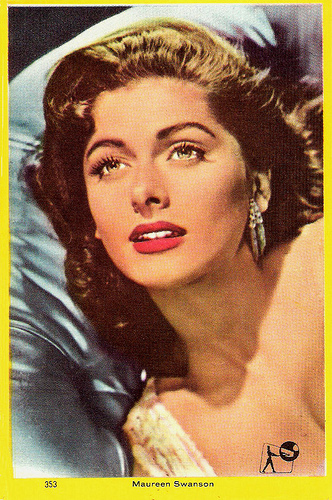
Mexican Collectors card, no. 353. Photo: Rank.
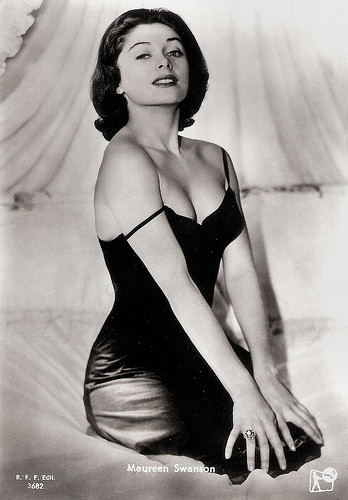
Italian postcard by B.F.F. Edit., no. 3682. Photo: Rank Organisation. Publicity still for Robbery Under Arms (Jack Lee, 1957).
A much-publicised Kiss
Maureen Swanson was born in Glasgow, Scotland in 1932. Her father James Swanson was a businessman.
When her parents immigrated to South Africa, she decided to stay behind in Great Britain. She was educated at schools and convents in Scotland, before she went to Paris to study ballet.
She soon won a place at the Sadler's Wells Ballet School and then the company itself, for which she had a featured role in The Haunted Ballroom, choreographed by Ninette de Valois. This gave her the chance, aged 19, to take over the important dancing role of Louise in Rodgers and Hammerstein's Carousel at the Theatre Royal, Drury Lane, in 1951.
She made her film debut in John Huston’s drama Moulin Rouge (1952) which was shot at Shepperton Studios in England. She played the aristocratic girl who rejects a proposal of marriage from Henri de Toulouse-Lautrec (José Ferrer), telling him no woman will ever love him, which prompts him to leave his childhood home in despair to begin a new life as a painter in Paris.
In 1952 Errol Flynn gave her a much-publicised kiss at the London airport and there was talk of Flynn giving her a contract, but she said no. She appeared in MGM's first CinemaScope feature, the spectacular Knights of the Round Table (Richard Thorpe, 1953) starring Robert Taylor and Ava Gardner.
Swanson appeared in memorable films like The Valley of Song (Gilbert Gunn, 1953), and the British Film Noir Third Party Risk (Daniel Birt, 1954) opposite Lloyd Bridges. In 1955 she made her TV debut in Great Britain, although she had already acted and danced in a series of six films made for the American television.
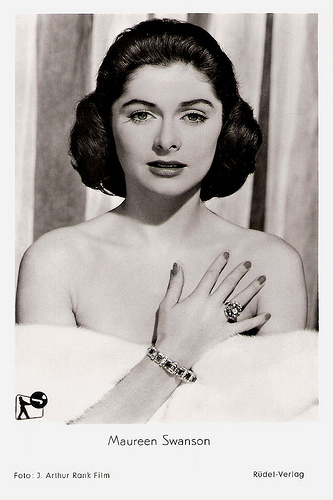
German postcard by Rüdel-Verlag, Hamburg-Bergedorf, no. 2092. Photo: J. Arthur Rank Film. Publicity still for The Spanish Gardener (Philip Leacock, 1956).
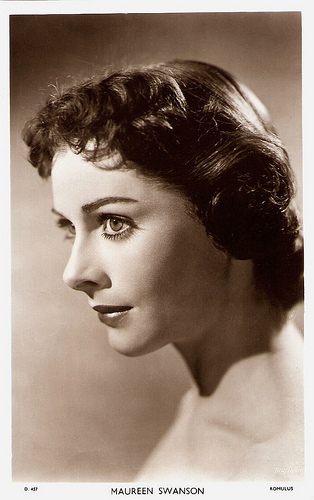
British postcard in the Picturegoer series, London, no. D 457. Photo: Romulus.
Up in the World
In 1956 Maureen Swanson appeared in four films. Her first film under contract to Rank, A Town Like Alice (Jack Lee, 1956) with Peter Finch and Virginia McKenna , was her best by far. It covers how a small group of women and children were force-marched through Malaysia by the Japanese during the second world war. In the film, Swanson, the youngest and prettiest of the women, flirts with any available man and even goes off with a Japanese officer.
She starred opposite Norman Wisdom in the comedy Up in the World (John Paddy Carstairs, 1956). She had a secondary role in Jacqueline (Roy Ward Baker, 1956). And in The Spanish Gardener (Philip Leacock, 1956) she appeared as the girlfriend Dirk Bogarde .
In 1956 she was also introduced to the Queen at the Royal Film Performance of The Battle at the River Plate at the Empire Theatre in London. Along with her were Marilyn Monroe , Victor Mature, Anthony Quayle, and others.
The following year she received good reviews for her role in the in Australia situated adventure film Robbery Under Arms (Jack Lee, 1957) starring Peter Finch, but it was to be her last feature film.
The following year, she only appeared further in a TV production of The Importance of Being Earnest (1958).
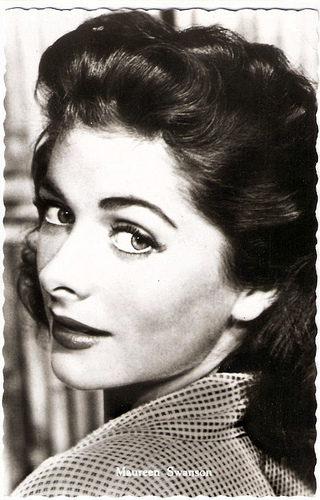
Dutch postcard, sent by mail in 1960. Photo: Rank. Publicity picture for Robbery Under Arms (Jack Lee, 1957).
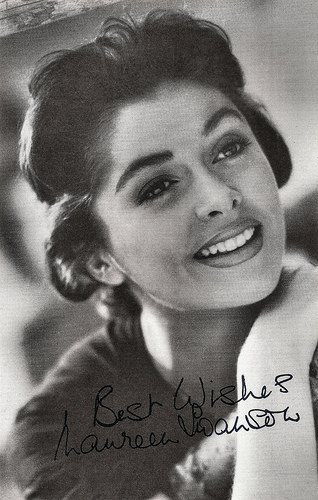
British postcard in the Celebrity Autograph Series by Celebrity Publishers LTD., London, no. 266. Photo: Rank Organisation. Publicity still for Robbery Under Arms (Jack Lee, 1957).
Libel Cases
In 1961 Maureen Swanson married William Ward, who in 1969 became the 4th Earl of Dudley. Their first child, a son named William, was stillborn in 1961. Later, they had six children, including documentary filmmaker Leander Ward (1971). Actress Rachel Ward is their niece.
As the Countess of Dudley, she managed the couple's homes in Cottesmore Gardens, Kensington, London and Devon. She also served as a lady in waiting to Princess Michael of Kent.
A few heavily publicised libel cases made sure she was not entirely out of the public eye. First, in 1987, the countess won £5,000 in libel damages from the Literary Review for a review of a book about ladies-in-waiting which, she claimed, had made her out to be a greedy and vulgar woman.
In 1989, she won again 'substantial' damages from the publishers of Honeytrap: the Secret Worlds of Stephen Ward by Anthony Summer and Stephen Dorril. The authors suggested that Swanson had been one of the 'popsies' whom Stephen Ward had procured for his influential friends.
Lady Dudley testified that she and Ward had an affair in the early 1950s. She became friends with the osteopath and artist when he was commissioned to draw her portrait in 1953, This was 10 years before he became one of the central figures in the notorious affair around former war minister John Profumo.
In 2002, the Countess of Dudley again accepted substantial libel damages from the publishers of Christine Keeler: The Truth At Last, Keeler's own account of the events surrounding her affair with John Profumo, in which she referred to Lady Dudley as having been 'one of Stephen’s girls'.
Lady Dudley died by cancer in 2011, aged 78.
Trailer Up In The World (1956). Source: rockinkid58 (YouTube).
Norman Wisdom and Maureen Swanson in Up In The World (1956). Source: 0swproductions0 (YouTube).
Sources: Ronald Bergan (The Guardian), Glamour Girls of the Silver Screen, Wikipedia and .

Mexican Collectors card, no. 353. Photo: Rank.

Italian postcard by B.F.F. Edit., no. 3682. Photo: Rank Organisation. Publicity still for Robbery Under Arms (Jack Lee, 1957).
A much-publicised Kiss
Maureen Swanson was born in Glasgow, Scotland in 1932. Her father James Swanson was a businessman.
When her parents immigrated to South Africa, she decided to stay behind in Great Britain. She was educated at schools and convents in Scotland, before she went to Paris to study ballet.
She soon won a place at the Sadler's Wells Ballet School and then the company itself, for which she had a featured role in The Haunted Ballroom, choreographed by Ninette de Valois. This gave her the chance, aged 19, to take over the important dancing role of Louise in Rodgers and Hammerstein's Carousel at the Theatre Royal, Drury Lane, in 1951.
She made her film debut in John Huston’s drama Moulin Rouge (1952) which was shot at Shepperton Studios in England. She played the aristocratic girl who rejects a proposal of marriage from Henri de Toulouse-Lautrec (José Ferrer), telling him no woman will ever love him, which prompts him to leave his childhood home in despair to begin a new life as a painter in Paris.
In 1952 Errol Flynn gave her a much-publicised kiss at the London airport and there was talk of Flynn giving her a contract, but she said no. She appeared in MGM's first CinemaScope feature, the spectacular Knights of the Round Table (Richard Thorpe, 1953) starring Robert Taylor and Ava Gardner.
Swanson appeared in memorable films like The Valley of Song (Gilbert Gunn, 1953), and the British Film Noir Third Party Risk (Daniel Birt, 1954) opposite Lloyd Bridges. In 1955 she made her TV debut in Great Britain, although she had already acted and danced in a series of six films made for the American television.

German postcard by Rüdel-Verlag, Hamburg-Bergedorf, no. 2092. Photo: J. Arthur Rank Film. Publicity still for The Spanish Gardener (Philip Leacock, 1956).

British postcard in the Picturegoer series, London, no. D 457. Photo: Romulus.
Up in the World
In 1956 Maureen Swanson appeared in four films. Her first film under contract to Rank, A Town Like Alice (Jack Lee, 1956) with Peter Finch and Virginia McKenna , was her best by far. It covers how a small group of women and children were force-marched through Malaysia by the Japanese during the second world war. In the film, Swanson, the youngest and prettiest of the women, flirts with any available man and even goes off with a Japanese officer.
She starred opposite Norman Wisdom in the comedy Up in the World (John Paddy Carstairs, 1956). She had a secondary role in Jacqueline (Roy Ward Baker, 1956). And in The Spanish Gardener (Philip Leacock, 1956) she appeared as the girlfriend Dirk Bogarde .
In 1956 she was also introduced to the Queen at the Royal Film Performance of The Battle at the River Plate at the Empire Theatre in London. Along with her were Marilyn Monroe , Victor Mature, Anthony Quayle, and others.
The following year she received good reviews for her role in the in Australia situated adventure film Robbery Under Arms (Jack Lee, 1957) starring Peter Finch, but it was to be her last feature film.
The following year, she only appeared further in a TV production of The Importance of Being Earnest (1958).

Dutch postcard, sent by mail in 1960. Photo: Rank. Publicity picture for Robbery Under Arms (Jack Lee, 1957).

British postcard in the Celebrity Autograph Series by Celebrity Publishers LTD., London, no. 266. Photo: Rank Organisation. Publicity still for Robbery Under Arms (Jack Lee, 1957).
Libel Cases
In 1961 Maureen Swanson married William Ward, who in 1969 became the 4th Earl of Dudley. Their first child, a son named William, was stillborn in 1961. Later, they had six children, including documentary filmmaker Leander Ward (1971). Actress Rachel Ward is their niece.
As the Countess of Dudley, she managed the couple's homes in Cottesmore Gardens, Kensington, London and Devon. She also served as a lady in waiting to Princess Michael of Kent.
A few heavily publicised libel cases made sure she was not entirely out of the public eye. First, in 1987, the countess won £5,000 in libel damages from the Literary Review for a review of a book about ladies-in-waiting which, she claimed, had made her out to be a greedy and vulgar woman.
In 1989, she won again 'substantial' damages from the publishers of Honeytrap: the Secret Worlds of Stephen Ward by Anthony Summer and Stephen Dorril. The authors suggested that Swanson had been one of the 'popsies' whom Stephen Ward had procured for his influential friends.
Lady Dudley testified that she and Ward had an affair in the early 1950s. She became friends with the osteopath and artist when he was commissioned to draw her portrait in 1953, This was 10 years before he became one of the central figures in the notorious affair around former war minister John Profumo.
In 2002, the Countess of Dudley again accepted substantial libel damages from the publishers of Christine Keeler: The Truth At Last, Keeler's own account of the events surrounding her affair with John Profumo, in which she referred to Lady Dudley as having been 'one of Stephen’s girls'.
Lady Dudley died by cancer in 2011, aged 78.
Trailer Up In The World (1956). Source: rockinkid58 (YouTube).
Norman Wisdom and Maureen Swanson in Up In The World (1956). Source: 0swproductions0 (YouTube).
Sources: Ronald Bergan (The Guardian), Glamour Girls of the Silver Screen, Wikipedia and .
Published on June 21, 2017 22:00
June 20, 2017
Vele ammainate (1931)
Vele ammainate/Lowered Sails (Anton Giulio Bragaglia, 1931) is an early Italian sound film, produced by Cines-Pittaluga. Dria Paola starred in this melodrama, which lacked a good script but had excellent cinematography and art direction as can be seen on the postcards.
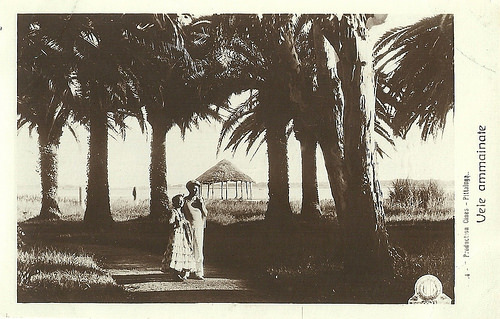
Italian postcard, no. 4. Photo: Cines-Pittaluga. Publicity still for Vele ammainate/Lowered Sails (1931).
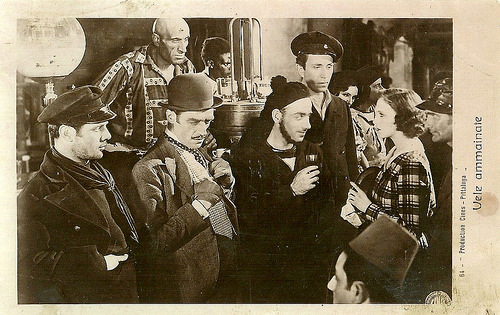
Italian postcard, no. 64. Photo: Cines-Pittaluga. Publicity still for Vele ammainate/Lowered Sails (1931).
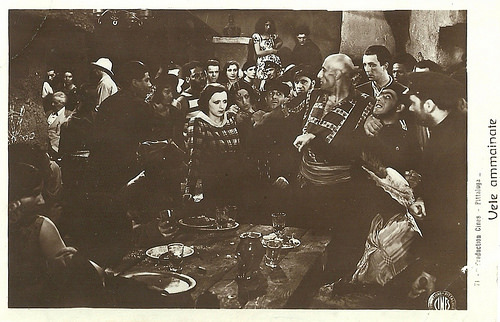
Italian postcard, no. 71. Photo: Cines-Pittaluga. Publicity still for Vele ammainate/Lowered Sails (1931).
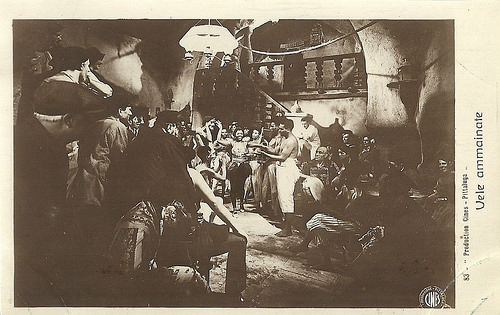
Italian postcard, no. 83. Photo: Cines-Pittaluga. Publicity still for Vele ammainate/Lowered Sails (1931).
An infamous harbour tavern in the Tropes
Dria Paola (1909-1993) was an Italian film actress of the 1930s and 1940s. Her name is attached to the first Italian sound film La canzone dell’amore/The Song of Love (1930) by Gennaro Righelli.
In Vele ammainate/Lowered Sails, Paola plays Aurora, the daughter of the keeper of an infamous harbour tavern in the Tropes. Her lurid and vulgar father (Umberto Guarracino) mistreats her all the time, which attracts the attention of a dashing young captain (Carlo Fontana), who is stuck in the harbour town because he has lost his ship in a storm and he is penniless. The captain defends the girl against the brutal father and a cheeky rival. In the end after he has regained income and paid for a new ship, he takes the girl with him on his new ship.
The Cinema Illustrazione reported in 1931 that the cinematography and scenography of the film were excellent, such as can be seen in the storm scene, or in the buoyant atmosphere in the tavern. However, the magazine condemned the poor script, the editing and the direction. Dria Paola did not get much space to develop her character, which was deplored in general as well, not only for this film.
The cinematography of Vele ammainate/Lowered Sails was done by Massimo Terzano and Domenico Scala, and the sets were designed by art directors Gastone Medin and Ivo Perilli. Indoor shooting was done at the Cines studios, outdoor shooting in Savona. Vele ammainate premiered around 21 December 1931 in Rome.
For both director Anton Giulio Bragaglia and Dria's co-star Umberto Guarracino Vele ammainate was their last film.The strongman Umberto Guarracino already played bad guys in the silent era, starting as the Monster in Il mostro di Frankenstein (1921) with Luciano Albertini as Dr. Frankenstein, followed by parts in Luciano Albertini's earliest German films, directed by Joseph Delmont in 1921, and a few other German films. In 1922-1923 he returned to Italy, to act in the Maciste films of the 1920s, in which he was called Cimaste. Dria Paola 's other co-star Carlo Fontana was a little known actor, who only did four feature films, between 1929 and 1937.
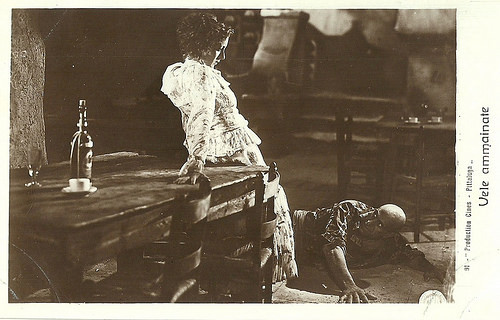
Italian postcard, no. 91. Photo: Cines-Pittaluga. Publicity still for Vele ammainate/Lowered Sails (1931).
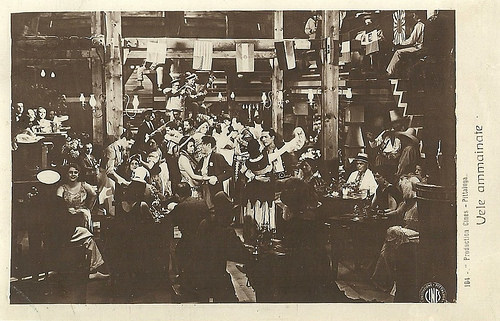
Italian postcard, no. 104. Photo: Cines-Pittaluga. Publicity still for Vele ammainate/Lowered Sails (1931).
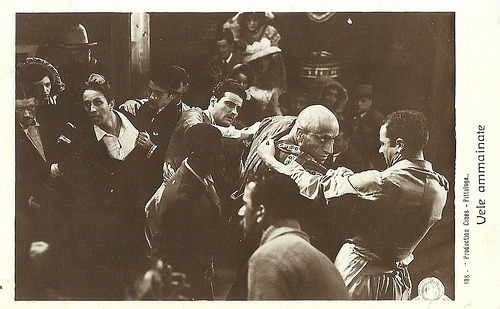
Italian postcard, no. 108. Photo: Cines-Pittaluga. Publicity still for Vele ammainate/Lowered Sails (1931).
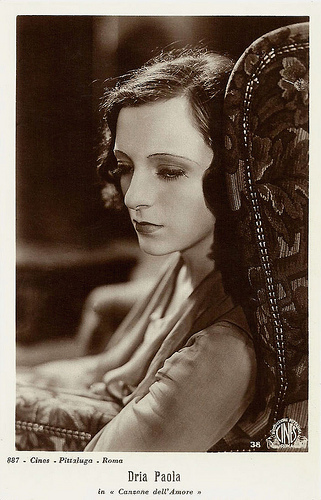
Italian postcard by G.B. Falci, Milano, no. 887. Photo: Cines Pittaluga, Roma. Publicity still of Dria Paola in La canzone dell’amore (1930).
Source: Roberto Chiti/Enrico Lancia (I film, vol. I: Tutti i film italiani dal 1930 al 1944), Wikipedia and IMDb.

Italian postcard, no. 4. Photo: Cines-Pittaluga. Publicity still for Vele ammainate/Lowered Sails (1931).

Italian postcard, no. 64. Photo: Cines-Pittaluga. Publicity still for Vele ammainate/Lowered Sails (1931).

Italian postcard, no. 71. Photo: Cines-Pittaluga. Publicity still for Vele ammainate/Lowered Sails (1931).

Italian postcard, no. 83. Photo: Cines-Pittaluga. Publicity still for Vele ammainate/Lowered Sails (1931).
An infamous harbour tavern in the Tropes
Dria Paola (1909-1993) was an Italian film actress of the 1930s and 1940s. Her name is attached to the first Italian sound film La canzone dell’amore/The Song of Love (1930) by Gennaro Righelli.
In Vele ammainate/Lowered Sails, Paola plays Aurora, the daughter of the keeper of an infamous harbour tavern in the Tropes. Her lurid and vulgar father (Umberto Guarracino) mistreats her all the time, which attracts the attention of a dashing young captain (Carlo Fontana), who is stuck in the harbour town because he has lost his ship in a storm and he is penniless. The captain defends the girl against the brutal father and a cheeky rival. In the end after he has regained income and paid for a new ship, he takes the girl with him on his new ship.
The Cinema Illustrazione reported in 1931 that the cinematography and scenography of the film were excellent, such as can be seen in the storm scene, or in the buoyant atmosphere in the tavern. However, the magazine condemned the poor script, the editing and the direction. Dria Paola did not get much space to develop her character, which was deplored in general as well, not only for this film.
The cinematography of Vele ammainate/Lowered Sails was done by Massimo Terzano and Domenico Scala, and the sets were designed by art directors Gastone Medin and Ivo Perilli. Indoor shooting was done at the Cines studios, outdoor shooting in Savona. Vele ammainate premiered around 21 December 1931 in Rome.
For both director Anton Giulio Bragaglia and Dria's co-star Umberto Guarracino Vele ammainate was their last film.The strongman Umberto Guarracino already played bad guys in the silent era, starting as the Monster in Il mostro di Frankenstein (1921) with Luciano Albertini as Dr. Frankenstein, followed by parts in Luciano Albertini's earliest German films, directed by Joseph Delmont in 1921, and a few other German films. In 1922-1923 he returned to Italy, to act in the Maciste films of the 1920s, in which he was called Cimaste. Dria Paola 's other co-star Carlo Fontana was a little known actor, who only did four feature films, between 1929 and 1937.

Italian postcard, no. 91. Photo: Cines-Pittaluga. Publicity still for Vele ammainate/Lowered Sails (1931).

Italian postcard, no. 104. Photo: Cines-Pittaluga. Publicity still for Vele ammainate/Lowered Sails (1931).

Italian postcard, no. 108. Photo: Cines-Pittaluga. Publicity still for Vele ammainate/Lowered Sails (1931).

Italian postcard by G.B. Falci, Milano, no. 887. Photo: Cines Pittaluga, Roma. Publicity still of Dria Paola in La canzone dell’amore (1930).
Source: Roberto Chiti/Enrico Lancia (I film, vol. I: Tutti i film italiani dal 1930 al 1944), Wikipedia and IMDb.
Published on June 20, 2017 22:00
Paul van Yperen's Blog
- Paul van Yperen's profile
- 13 followers
Paul van Yperen isn't a Goodreads Author
(yet),
but they
do have a blog,
so here are some recent posts imported from
their feed.



